- Our Community
- Advertise / Pubblicità
- Search for: Search Button


An Italian-registered 'Associazione Culturale', a Not-for-Profit Cultural Association
Primavera, the best time to visit abruzzo.
Late April to mid-May is the best time to visit Abruzzo for a holiday or long weekend break; it is still untouched, wild, with nature at its most flirty.
The landscape is a textural riot with every imaginable petal & blossom open to announce the beginning of the warm weather softening the existing starkness of the Gran Sasso Mountains from where the snow has melted. The softest purples, yellows & pinks fill the hedgerows, Apennine meadows and olive groves with centre stage taken by the mass of poppies that seem to burst from every available pocket of earth. Delicate violets, anemones, buttercups and sky-blue forget-me-nots. “Occhi della Madonna”, gentians & peonies poke through in contrast to the bunches of white wisteria that dangle as a glorious canopy to shade them from the already powerful midday sun.
As the newborn lambs cavort next to their newly shorn mums, everyone is busy out in their fields harvesting the first crop of the season; sweet Favas (Broadbeans). They make the perfect snack with a little of the local sharp and peppery virgin olive oil & Panepizza (a sort of open textured crusty slim version of focaccio) and a chilled flowery glass of Trebbiano. Of course there are a million things more, the birds, the bees, all back and playing in the newly bushy wild cherry trees but that is worthy of a post all to itself.
Abruzzo’s Colours of Spring

Author: Roddy Newlands
Roddy Newlands is an Associate Member of Life In Abruzzo, as well as antique book dealer and web and graphic designer. Abruzzo allows him to get his mountain-air fix, & satisfy his passion for pasta & panettone.
Protecting Abruzzo’s Charm, Empowering Generations to Come: Grow Life in Abruzzo!
Support our not-for-profit cultural association via gofundme, free newsletter, related posts, autumn in abruzzo – bounty, beauty & bereavement, life in abruzzo january sun, autumn cheer gluten-free focaccia, related articles, events, businesses and shop items.

Cherries & Dressing Up at Raiano

Bucchianico: Festa dei Bandereisi

Abruzzo Beach Bible – Blue Flag Beaches 2024

Getting Slippy at the Cocullo Snake Festival

Sulmona – Festa dei Fuochi
Fai open spring days across abruzzo.

FAI Spring Open Day Abruzzo

Eat Le Virtù – Teramo’s Special May Day Soup

Plutonic Love – Italia’s Mint Pancakes

Virtues of Le Virtù – Teramo’s Tasty Spring Clean Soup

Shepherd’s Steak – Abruzzo’s Pastoral Cheese on Toast
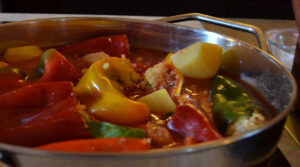
Get Stuffing – Divine Stuffed Cornetto Peppers (Peperoni Ripieni)

Spring Veggie Timballo

Sagne, Guanciale and Broad Beans in a Pecorino Cream

A Pennese Summer Take on Pasta alla Genovese with Minted Cream of Peas
Change Location
Find awesome listings near you.
You’ve probably never been to…Italy’s Abruzzo National Park. Here's why you should

Dec 20, 2022 • 7 min read

Experience one of Europe's rewilding projects in Italy's Abruzzo National Park © Francesco Riccardo Iacomino / Getty Images
In Rome, tourists swarm into the ruins of ancient temples, jostle for selfies and stand in line for restaurants. But just two hours away, the hills and valleys are empty and the only wait you have is in hope for a sight of an elusive bear or wolf. This is Italy ’s Abruzzo National Park, a triumph of conservation and rewilding in both Italy and Europe.
In the entirety of the Abruzzo region – of which the national park is only a portion – just 1.3 million tourists visited in 2021, with far less making the journey from Abruzzo’s gorgeous coastline inland to the park. The result is that outside the high summer season , it’s completely possible you might hike for the day without passing anybody else.
Here are the best things to do in Abruzzo National Park.

Look out for the local wildlife: bears, wolves and deer
Abruzzo National Park is one of the best places in Italy to spot large animals and makes a strong contender for the best in Europe. When it comes to advertising the park, however, there is one superstar and that’s the Mariscan brown bear. Smaller and less aggressive than their fearsome North American counterparts, they are literally the icon of this area, appearing on the park logo and on statues in Pescasseroli, the main town of the park.
Walking with my guide Andreas from Wildlife Adventures, he described the park as a “heaven for bears” thanks to an abundance of good food. They can be difficult to spot due to being largely solitary creatures but evidence of them is everywhere if you know where to look. Over the course of five days, Andreas regularly pointed out tree trunks that were used by bears to rub against, finding hairs still trapped in the wood.
A slightly more contentious inhabitant of the park is the Italian wolf. There are many farmers in the region that dislike sharing space with them. We met a local farmer who lost cattle due to wolves and even pointed out a calf who was still recovering from painful injuries sustained from a wolf attack. But the wolves are a huge draw for people. For many visitors, especially from urban areas, Andreas said they tend to view wolves almost as puppies. Despite his own deep love of the animals, he takes a more neutral standpoint: “I think the truth is something in between.”
Recent reports say the wolves are not showing as much fear around humans as they were before, something of a “shifting point in their attitude towards us”. There was even a biting incident recently near the Abruzzo coast after a tourist cornered a wolf. However, the biggest problem is often other humans, in particular the desire to get close to get the "perfect" picture. If people are lucky enough to spot the wild animals one day, they will often tell their friends who come back and, perhaps, take more risks in order to get the same experience.
Despite the long days and good weather, it can sometimes be more difficult to see wolves in the summer because the pack splits while in winter they travel together. The last intensive survey of wolves in the park estimated there to be about 10 packs, with between 60 and 70 wolves in total.
Still, there is no shortage of animals to see. When I visited, we were lucky enough to be treated to two spectacular displays of red deer in the early mornings. The males bellowed loudly, their noisy display the first step in warning other males against approaching some females in the area. Despite that, some persisted and the sight of them locking antlers in the early morning sun, at the side of a mountain, was spectacular.
The best time to go wildlife watching is very early morning or at sunset. While waiting, it’s a beautiful opportunity to slow down and really take in the landscape. And if you don’t spot anything? “That’s part of the game!”, jokes Andreas.
Want some help? Let Elsewhere plan your next trip
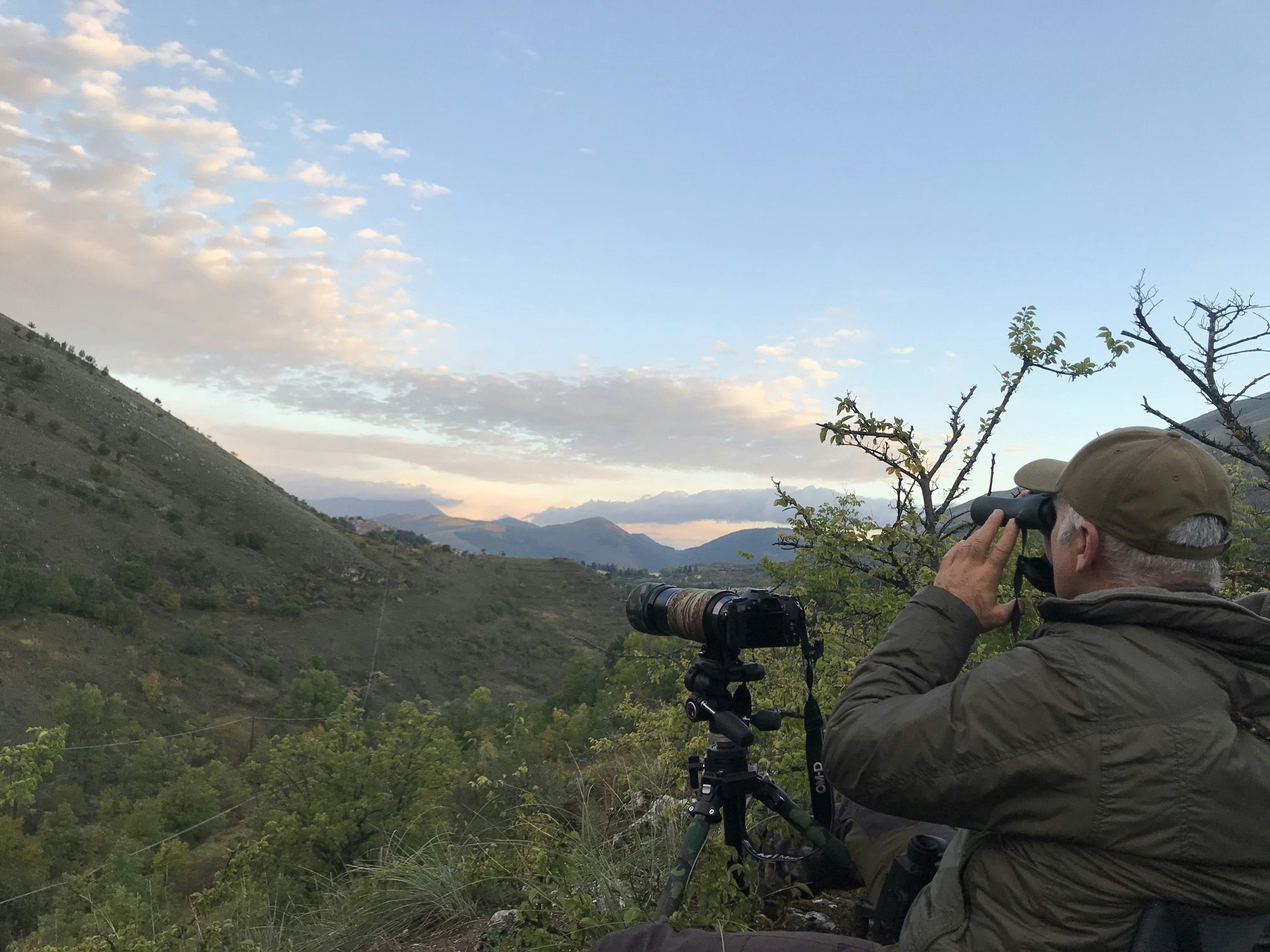
Witness a gradual rewilding during a rewarding hike
When not waiting for the animals, there are nearly 150 well-marked hiking trails for you to explore, covering an incredible 750km (466 miles) in total. If you’d prefer to not hire a guide, a full list of trails is available on a map you can pick up from any local tourist office.
However, with a bit of expert help, you can more deeply appreciate the gradual rewilding of the park. Intensive forest management ended 50 years ago but the landscape is still feeling the effects of it today. Trying to optimize the land for agriculture meant plenty of space was kept between trees to ensure there was enough shade for grazing animals, as well as space for them to eat. Now the trees are gradually closing the gap and Andreas estimates that maybe in 100 years, without intervention, it will resemble a primeval forest once again. Beech tree woods cover about 60% of the park today.
In the meantime, it is a joy to trek through, spotting the slow re-encroachment of nature, imagining what it might have been like in the past and what it may look like again. Even the fallen or dead trees are left here to add to the ecosystem, fungus and seeds appearing on them like mini-universes. Good mushrooms often appear when trees are about to die. Bring your attention and slow down to really take in all these details.
Stay in a mountain hut
We spent one night in Rifugio Terraegna , a hut high up in the mountains that can accommodate groups of up to ten people. With comfy beds and some limited electricity from solar power, it has everything you need for a short stay and our host Valeria cooked a delicious three-course meal, with some organic local red wine also available to purchase. Afterwards we all told stories about some of our favorite moments in nature, one that brought a touch of magic to our lives.
There are plenty of rifugios (refuges or shelters) dotted around the park with varying degrees of luxury. Booking ahead is recommended.
Indulge in Abruzzo's local cuisine
During your wild wanderings, you may sometimes forget you’re in Italy but you’ll certainly remember when it comes to dinner. Abruzzo is famous for hearty takes on Italian classics . The region is famous for lamb and the arrosticini sheep skewers are a local delicacy, although the meat will be used in any number of delicious dishes for your secondo, including agnello cacio e ovo (lamb covered in a lemon, egg and cheese sauce) or mutton stew. If you’re so inclined, everything is best washed down with some Montepulciano d'Abruzzo, the most famous wine of the region.

Check out the Visitor Centre and sanctuary
Pescasseroli is the headquarters of the park and the Visitor Centre is a sanctuary for a couple of injured bears and other wild animals. A lot of the displays are only in Italian but at least you’re guaranteed to spot some animals if your wildlife-watching has been a bit disappointing. It's not an essential stop but we passed a particularly wet afternoon there quite pleasantly and it was my only sighting of a bear in the park.
How to get to Abruzzo National Park and where to stay
Pescasseroli is the main town in the park and the most popular base to stay in if you want to remain within the park bounds. It has the most choice of accommodations and places to eat, as well as some charming lanes to explore in your downtime. If you want to stay near the coast and don’t mind a longer drive, Pescara is a good option.
It’s a two-hour drive from Leonardo DaVinci airport to Pescasseroli. It’s probably too long a drive – with far too many things to do – for a day trip but it’s certainly doable in a weekend trip from Rome (although you will certainly fill more days if you’d like to, particularly if you’re a nature-lover).
If you are traveling independently, a car is your best bet, both to get there and also to ensure you have full access to the beginnings of the trails and the best wildlife watching spots. There are bus connections from Rome via Prontobus to the town of Avezzano.
AnneMarie traveled to Abruzzo National Park on the invitation of Much Better Adventures.
Explore related stories

Jan 11, 2024 • 8 min read
Italy has so many delights for visitors, it’s hard to know where to start. Lucky for you, we’ve made this list of the best experiences all over the country.

Feb 18, 2021 • 2 min read
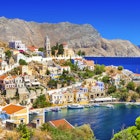
Aug 25, 2020 • 8 min read
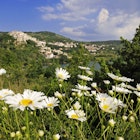
Apr 4, 2017 • 4 min read

May 24, 2024 • 7 min read

May 18, 2024 • 10 min read
Abruzzo Travel Guide: The Essential Guide To Abruzzo Italy

- October 3, 2023
- Things you need to know about Abruzzo , Top Events in Abruzzo
- Abruzzo Travel , Abruzzo Travel Guide
- One Comment
Abruzzo Travel Guide: Your Essential Guide to Explore the Enchanting Beauty of Abruzzo Italy
This Abruzzo Travel Guide promises an experience like no other. With breathtaking landscapes, charming medieval villages, delectable cuisine, and vibrant cultural celebrations. Here’s your comprehensive Abruzzo Travel Guide to ensure you make the most of your visit to this remarkable region. Welcome to Abruzzo, Italy. Italy’s best-kept secret.

Abruzzo is a pristine region, often referred to as “Italy’s Best-Kept Secret” because its allure lies in its unspoiled natural beauty, rich cultural heritage, and warm hospitality. Unlike the bustling tourist crowds in more popular Italian destinations. Abruzzo offers a serene escape because you will be traveling into the heart of Italy and all in close proximity to your very own exclusive Villa Rental in Abruzzo
This Essential Guide to Abruzzo will cover:
- The Abruzzo Mountain Range and National Park
- Abruzzo Medieval Villages
- Abruzzo Food & Wine
- Blue Flag Beaches of Abruzzo’s Adriatic Coast
- Abruzzo Cultural Festivals and vibrant night life
Your Guide to Abruzzo’s Mountain Range and National Park
Nature enthusiasts will be captivated by the majestic Apennine Mountains, which dominate Abruzzo’s landscape, so its perfect for hiking enthusiasts. The Gran Sasso and Monti della Laga National Par is the crown jewel of the Abruzzo mountain range because its home to stunning peaks, lush forests, and diverse wildlife. Hikers and adventure seekers will find themselves in paradise, with endless trails and activities to explore.
Abruzzo’s extensive network of national parks competes admirably with the natural beauty found in renowned parks worldwide. During your Abruzzo trip, you’ll encounter a collection of exceptional natural reserves. The Parco Nazionale della Majella d’Abruzzo, Parco Nazionale d’Abruzzo, Parco Nazionale del Gran Sasso e Monti della Laga in Pietracamela, Italy, and Parco Naturale Regionale Sirente Velino. Above them all, proudly towering over the Abruzzo Apennines, is the majestic Corno Grande in the Abruzzo Gran Sasso region. It soars to a remarkable elevation of 2,912 meters above sea level.
Here are some key information on these natural wonders:
- Parco Nazionale della Majella : Declared a UNESCO Global Geopark.
- Parco Nazionale d’Abruzzo : One of the largest protected areas in Europe.
- Parco Nazionale del Gran Sasso e Monti della Laga in Pietracamela : One of the largest protected areas in Europe,
- Parco Naturale Regionale Sirente Velino : There are 1,926 floristic entities registered in the park. The flora is of scientific importance and includes species never reported before
In the Abruzzo National Park , the allure of nature’s beauty beckons. Inviting you to explore its diverse landscapes and experience the marvels of “Italy’s Garden”.
Abruzzo Travel Guide to its Medieval Villages
The charming Abruzzo towns and medieval villages in Abruzzo all share a common allure: perched atop picturesque hilltops, they boast a church, a town square, enchanting houses and architecture offering sweeping panoramic vistas. These beautiful Abruzzo villages trace their origins primarily to the medieval era, a period when these charming settlements began to take shape. Remarkably, their appearances have been lovingly preserved, capturing a historical moment frozen in time. What makes Abruzzo of particular importance to Abruzzo towns is the fact that it has won several “Borghi Piu Belli d’Italia” awards ( The Most Beautiful Villages in Italy )

Exploring these ancient mountain towns in Abruzzo feels like stepping into miniature worlds. Each medieval Abruzzo village possesses a unique ambiance that encapsulates the passage of time where the locals warmly greet visitors with a friendly “buongiorno.” For a detailed guide read the Abruzzo guide to Abruzzo Towns & Medieval Villages
Your Guide to Abruzzo Food & Wine
Prepare your taste buds for an unforgettable culinary journey as part of your adventure in Abruzzo. Abruzzo travel is synonymous with a diverse range of cuisine, including seafood, cheese, and pasta. Indulge in dishes like arrosticini (grilled lamb skewers), pappardelle with wild boar, saffron-infused risotto, and an array of delectable seafood options. Don’t forget to pair your meal with local wines, such as Montepulciano d’Abruzzo, produced in the region’s vineyards. Want to know more details about Abruzzo cuisine? Then read the Abruzzo Food Guide

Abruzzo Guide to blue flag Beaches
The Adriatic Sea, Abruzzo offers 130 kilometers of coastline and so the picturesque beaches are perfect for sunbathing and swimming.The beaches near Pescara, Silvi, Montesilvano and Pescara are known for their golden sands and clear waters, making them ideal for a relaxing day by the sea. If you love the beach then read the Abruzzo Guide to beaches

Abruzzo Travel Guide of Cultural Festivals
Abruzzo is steeped in a rich tapestry of history and culture, where ancient traditions coexist with modern influences. The region’s historic towns and villages offer a glimpse into Italy’s storied past, with their well-preserved architecture, centuries-old churches, and archaeological sites that bear witness to the civilizations that once thrived here.
As you meander through the labyrinthine streets, you’ll encounter a sense of timelessness that transcends the constraints of the present. Immerse yourself in Abruzzo’s rich cultural heritage so by attending its vibrant festivals your experience in Abruzzoe wouldn’t be complete without experiencing some of these events:
- Held in August in Guardiagrele
- This traditional festival revolves around saffron and showcases local crafts, music, and dance
- This experience will offer a taste of Abruzzo’s rich heritage
- Held annually in Cocullo in May so the weather is not too hot or too cold
- This unique and ancient festival honors St. Domenico, the patron saint of snakebite victims
- Live snakes are draped over a statue of the saint and carried through the village making it a fascinating and symbolic procession, so a one-of-a-kind experience!
- Chieti Easter Parade (Processione del Venerdì Santo) : Witness the solemn and deeply moving Chieti Easter Parade , a religious procession that takes place on Good Friday. It features beautifully crafted statues depicting scenes from the Passion of Christ, as it is a significant cultural event in the region, and thus adding a spiritual touch to your Abruzzo journey.
- Madonna che Scappa in Sulmona : Experience the unique and lively Madonna che Scappa (Madonna on the Run) festival in Sulmona during Holy Week. This event reenacts the joyous moment when the resurrected Christ meets his mother, adding a special cultural and religious dimension to your experience.
These festivals offer a glimpse into Abruzzo’s rich traditions and so it provides you an opportunity to connect with the local culture in a profound way, making them essential stops on your itinerary. Plan your visit to coincide with one of these events to truly immerse yourself in the spirit of Abruzzo.
Abruzzo Travel Guide to vibrant nightlife
For those looking to experience a livelier side of Abruzzo, then Pescara is the place to be. This coastal city comes alive at night, with a bustling nightlife scene so you can enjoy beachfront clubs, bars, and live music venues. And for the Jazz lovers, there is the Pescara Jazz festival . Enjoy Prosecco by the sea; moreover, you can dance the night away to the latest tunes during your Abruzzo adventure.
Hiring a car in Abruzzo
Renting a car offers you the flexibility to explore the beauty of the Abruzzo region at your own leisure. We recommend booking in advance via our car rental partner, as they offer great rates and service, often significantly cheaper than booking direct. Additionally, they provide car rental from Pescara, Rome, as well as all key locations and airports in Italy. You can BOOK HERE to secure your rental today.
- Visit the the Abruzzo Mountain Range and National Park so you can take in “Europe’s Garden”
- Take road trips to Abruzzo Medieval Villages so you can explore beautiful churches, unique architecture and relax at the local piazza square with a cappuccino while enjoying sweeping views
- Enjoy the flavours of Abruzzo Food & Wine, remember it’s not only about pizza and pasta!
- Soak in the sun and swim the Blue Flag Beaches of Abruzzo’s Adriatic Coast
- Learn about and take part in Abruzzo Cultural Festivals and enjoy the vibrant night life
One thought on “ Abruzzo Travel Guide: The Essential Guide To Abruzzo Italy ”
Great travel guide to Abruzzo! I will be traveling to Abruzzo and looking forward to it 🙂
Leave a Reply Cancel reply
Your email address will not be published. Required fields are marked *
Save my name, email, and website in this browser for the next time I comment.
Please enable JavaScript to submit this form.
You may also find these articles interesting
- Top things to know about Abruzzo, Italy
- Last Minute Pescara
- Where to Stay in Abruzzo | Looking where to stay in Abruzzo Italy?
- Easter holiday in Italy | Easter in Italy traditions | Easter holidays in Italy | Easter traditions in Italy
Abruzzo, Italy: travel guide and places to visit

Visit Abruzzo
With a varied landscape Abruzzo is known for its seaside resorts, its mountain scenery and its ski resorts - with the great advantage that the sea and the mountains are never far apart so it is easily possible to combine both during your visit.
Abruzzo - a travel guide and places to visit
For a summary of the most popular sights in the region see also Abruzzo places to visit .
The Abruzzo region runs along the Adriatic coast of western central Italy.

To the east of Abruzzo the area also has popular beaches and coastline on the Adriatic Sea. For almost 100 miles Abruzzo follows the Adriatic, where well established resorts attract large numbers of families from across Italy and elsewhere in Europe. Apart from the long beaches in the major destinations there are also long stretches of quieter coast where you might find a smaller beach where you are almost alone.
Advertisement
Western Abruzzo - Inland with beautiful mountain scenery
The region away from the coast is defined by its mountains, and it is one of the most mountainous regions in Italy, culminating with the Corno Grande mountain at almost 3000 metres high.

The mountains of Abruzzo also contains numerous attractive villages, often huddled around an ancient church, and several other interesting towns, castles and other historic monuments.
In the north in particular Abruzzo has a particularly impressive mountain backdrop, perhaps nowhere more so than the region around the town of L'Aquila. L'Aquila, the capital of Abruzzo is in the Gran Sasso mountains and has a long tradition of being one of the most historically interesting centres in Abruzzo, although the historic center suffered a great deal of damage during an earthquake in 2009, which also killed several hundred people.

A little to the west is the ski-resort of Ovindoli and the nearby town of Celano , famous for the huge Piccolomini castle which dominates the attractive hill-top town.
Further south is a cluster of villages which count amongst the most beautiful villages of Italy. Pacentro , Anversa degli Abruzzi , Scanno and Opi all have this distinction. As a bonus they are all situated in beautiful mountain settings. Pacentro also has a 14th century castle which is currently being renovated. Nearby is the lovely town of Sulmona which has many palazzos and piazzas to admire as well as a large aquaduct. Another highlight is the dramatic village and castle of Roccascalegna (photo above) which is near the border with Molise.
There are parts of three different Italian National Parks within Abruzzo's borders - the Abruzzo, Lazio and Molise National Park, the Mount Majella National Park and the Gran Sasso e Monti della Laga National Park - as well as the Sirente Velino Regional park and several Nature Reserves. Together these cover more than a third of the territory and as a result you are never far the chance to enjoy the protected environment of mountains and forests, lakes and rivers, and an abundance of wildlife.
Eastern Abruzzo and the coastline
Eastern Abruzzo has some beautiful beaches with, in general, the longer, sandier beaches being on the northern part of the Abruzzo coast.
Among the most visited of the Abruzzo sea resorts are Alba Adriatica, Costa dei Trabocchi, Francavilla al Mare, Giulianova, Martinsicuro, Montesilvano , Ortona , Pineto, Roseto degli Abruzzi, San Salvo, Silvi Marina, Tortoreto and Vasto and several of them have been awarded the prestigious 'blue flag' award for cleanliness and facilities. Ortona as well as being a coastal resort is home to a large Argonese castle. The main town on the coast is at Pescara, which also has about 10 kilometres of sandy beaches.

Atri is a pretty hill village fairly close to the coast and further south, also occupying a hilltop location is Lanciano with its medieval cathedral to the south. Lanciano is an important tourist destination as it is the site of the Eucharist miracle where bread and wine were apparently seen to turn into flesh and blood. Between the two Crecchio is home to an impressive castle which contains an Etruscan and Byzantine museum.
Abruzzo is famous for its olive oil and Loreto-Aprutino is part of the 'golden-triangle' of olive oil along with Moscufo and Pianella.
A highlight of Abruzzo is the hill top city of Chieti is one of the oldest cities in Italy and is home to many fine Palazzos and churches. Another highlight is the dramatic village and castle of Roccascalegna which is in the south of the region near the border with Molise.
Abruzzo photo gallery

Tourist Awards in Abruzzo
Most beautiful villages.
The following Italian towns and villages in Abruzzo are listed among the ' most beautiful villages in Italy ': Anversa degli Abruzzi , Bugnara, Castel del Monte, Castelli, Città Sant'Angelo, Civitella del Tronto , Guardiagrele, Introdacqua, Navelli , Opi , Pacentro , Pescocostanzo, Pettorano sul Gizio, Pietracamela, Rocca San Giovanni, Santo Stefano di Sessanio , Scanno , Tagliacozzo, Villalago
Orange Flag Tourism towns in Abruzzo
The following Italian towns and villages in Abruzzo are listed among the ' Orange flag towns in Italy '(a national tourist award): Palena, Roccascalegna
Map of Abruzzo and places to visit
Abruzzo places to visit.

Select your language
Site search

Cinque Terre

Amalfi coast
Italy This Way - copyright 2009 - 2024 :: privacy policy
Travel Info for Abruzzo
Best time to go to abruzzo and how to get there.
- Places to stay
- Insider's Guide
- Travel Info
Abruzzo: When to Go
Abruzzo is a year-round destination, but we'd recommend visiting in the spring (particularly early-mid May when the wild cherry is blossoming) or early summer (late May-June) when the alpine and subalpine flowers are in bloom. But midsummer and autumn are also lovely. It is several degrees cooler than Rome up here, and can be very snowy in winter - though central heating and (in some rooms) working fireplaces keep the houses cosy.
TRAVEL ESSENTIALS
Getting there.
To search flights across all airlines, we recommend using Skyscanner ABRUZZO: BY AIR From the UK: carriers include Ryanair , British Airways , Easyjet and Jet2 . Within Europe: try Aer Lingus and Easyjet .
Getting Around
There's little public transport here, so hiring a car is essential - see our car rental recommendations ..
Italy (Abruzzo)
From breathtaking, ancient hilltop towns, a little ragged around the edges, to Neolithic caves, Roman ruins, and the best beaches in the country, Abruzzo is as surprising and rare a find as an Egyptian tomb in a scoured desert. Luciano Di Gregorio author of Abruzzo: The Bradt Guide
Abruzzo offers travellers a holiday that is as varied as its landscape, with snow-topped peaks, flower-swathed alpine meadows and remote beaches. Remote medieval villages and monasteries tumble down rugged slopes, villagers harvest saffron by hand in timehonoured fashion, and wolves and bears still lurk in forgotten corners. Yet fashionistas throng the streets of Pescara, and visitors flock to the region’s riviera to soak up the sun, gorge on seafood and live la dolce vita .
Food and drink in Abruzzo
Many visitors to Abruzzo, both Italian and foreign, claim that the food is one of the highlights of their stay. Indeed, many of the region’s fairs and festivals revolve around food, and eating is at the core of Abruzzo’s culture.
Eating out in Abruzzo is quite a simple and hassle-free aff air: the quality of food and drink will be good to excellent anywhere you go. This is especially true of smaller towns. Furthermore, Abruzzo has a fine culture of casual eating alongside proper dining. The food that you encounter at street kiosks and bars is almost always of great quality. In fact, when visiting a town or village, don’t hesitate to walk into a restaurant that looks more like someone’s kitchen or living room than a posh restaurant; your meal is likely to be even more memorable.
So it’s a lazy Sunday in Pescara, and you’re keen to make the most of the region’s gastronomic delights. Here’s how:
Get up early and head to your local bar. There is one at every street corner, so you probably needn’t go very far. Order a bomba and a cappuccino and do some people watching whilst sipping your coffee at the bar.
Head to a restaurant, or, better yet, get invited to the home of a local. Here, enjoy a filling plate of sagne e fagioli . After your hearty meal, sip a genziana liqueur.
Afternoon snack
At about 17.00, take yourself to a pasticceria (patisserie) for an espresso accompanied by two pizzelle filled with a mixture of jam and chocolate spread such as Nutella, a snack favoured by the Pescaresi.
Find a trattoria for the best arrosticini in the region. It is very common to eat at least 20 of these, accompanied by toasted bread with a dash of oil. Follow your meal with a saffron liqueur.
Vegetarians
Even though a recent survey claimed that 7% of Italians have become vegetarian, the idea hasn’t really penetrated the popular conscience yet, especially in the rustic Abruzzo. Though vegetarian restaurants exist, and many others in the cities can offer a vegetariano choice, in many places you’re going to be stuck with a lot of tomato and mozzarella salads.
As for vegans, if you tell an Abruzzese you are a vegano , chances are he won’t have the faintest idea what you’re talking about. But things are looking up; Abruzzo Vegan has a short list of vegan restaurants and food shops in the region (in Italian only).
Health and safety in Abruzzo
Aside from the risks posed by exposure to the sun (both in summer and winter), and the nuisance of mosquitoes, health issues in Abruzzo are no different from those in other westernised countries.
In most cases, EU citizens with an EHIC (European Health Insurance Card) are entitled to free care in Italy from the SSN (Servizio Sanitario Nazionale, the national health system). Non-EU visitors will be expected to pay. Once you obtain an Italian residence permit, you are eligible to apply for the national health insurance.
There will be a hospital or clinic in every town of any size, and the staff in pharmacies are trained to assist with most minor problems. If one is closed when you need it, look for the card in the window with the schedule of the farmacia di turno (the closest one open).
Emergency numbers are the same throughout Italy.
Travel clinics and health information
A full list of current travel clinic websites worldwide is available on ISTM . For other journey preparation information, consult Travel Health Pro (UK) or CDC (US). Information about various medications may be found on Net Doctor . All advice found online should be used in conjunction with expert advice received prior to or during travel.
Whilst Abruzzo, as with most of Italy, is generally a safe place to travel, a sensible level of awareness is advised. This is particularly true in Pescara, where you should keep an eye on your belongings, especially in and around the station.
Female travellers
Women travelling alone or in small groups should not encounter any particular problems in Abruzzo, especially in the countryside. If possible, try to avoid arriving or leaving the stations of Pescara, Chieti, Teramo and L’Aquila too late at night. There have been problems and complaints in the past of things such as bag snatching, harassment, etc, though no more or less than in any other cities of similar size throughout Europe.
The beaches of coastal Abruzzo are generally a safe place for lone women to be. This is also true of the nightlife in and around the stabilimenti, which are often patrolled.
LGBTQ+ travellers
Attitudes towards gay, lesbian, bisexual and transgender people are consistent with those of the rest of Italy outside the bigger cities. A normal amount of discretion is advised. You are unlikely to be harassed in the provincial capitals, though the residents of country towns are likely to display a mixture of confusion and animosity, especially teenagers and the elderly. However, hotel workers are unlikely to question a gay or lesbian couple requesting a double room.
Pescara used to have its own gay nightclub, bar and sauna, but, following a recent spate of homophobic attacks on cars parked around the venue, this has since closed. There is a section of beach in the area of Scerne di Pineto which is frequented by many gay and lesbian people, especially on Sundays.
Despite some recent concerns, attitudes in Italy are slowly relaxing with a growing awareness of the issue of discrimination towards LGBT men and women which is discussed in both the media and politics. However, drastic change is unlikely to take place, given the pressures and influences of the Vatican City, a short distance (physically and metaphorically) from the central government in Rome.
Travel and visas in Abruzzo
Abruzzo is a region of the Italian Republic and therefore bound by all internal entry regulations, as well as those governed or required by the European Union and the Schengen Agreement. In addition to citizens of EU member states, holders of passports from some 50 nations do not need a visa for stays of 90 days or less. These include Australia, Canada, Hong Kong, Israel, Japan, Malaysia, Mexico, New Zealand, South Korea, Singapore, Switzerland, and the United States.
Theoretically, all foreigners are required to register their presence with the police within eight days of their arrival in the country, but in practice few people bother; in any case, your hotel should take your passport and residence details for this exact purpose. Note, however, that if you are non-EU and get in a jam with the police, they can take your failure to report your arrival as evidence that you have already overstayed the legal period.
EU citizens and their families (including grandparents, uncles and aunts, etc in some cases) can stay beyond 90 days if they have employment, sufficient resources to live by, or an approved course of study. Even so, it will require filling out a form at the local police station. Non-EU family members will need to apply for a residence permit, a carta di soggiorno. After five years EU citizens and family members have the right to a permanent residence card.
For citizens of non-EU countries, extending your stay in Italy beyond 90 days can be rather difficult; the first step is applying for a carta di soggiorno through the provincial Questura (state police office) or through the Post Office. Italy currently offers around 21 types of entry visa, few of which are entirely clear in their regulations and limitations, let alone in their explanation of what’s required in order to secure one. The most common types of foreign visa are those based on study, work and elective residence.
Whichever sort of visa or permit you need, expect the rules to be infernally complex, onerous and confusing. For detailed information on these subjects (in English), see the site of the Polizia di Stato , or that of the Foreign Ministry . Note that information on these two sites is often contradictory.
Getting there and away
Abruzzo International Airport ,10 minutes by bus from the centre of Pescara, is the main gateway to the region. Passenger numbers have risen by more than 400% over the last decade and an increasing number of international airlines are now using this small though often busy airport.
The city centre is only 3km away, reachable by taxi , by city bus 38, or the ARPA coach line, which continues on to Chieti.
Many will find it more convenient to fly to Rome and travel from there to Abruzzo. Rome’s Fiumicino airport is a 2½-hour drive from the centre of Pescara and only 45 minutes from the border between Abruzzo and Lazio. Numerous international airlines from the UK, USA and elsewhere service the airport.
If you do not have your own transport, there are various options for getting to Abruzzo from Rome. The quickest is via the airport train terminal to Rome’s Tiburtina station. From there, buses are available to the larger cities such as Pescara. To travel on by train you must head for Rome’s Termini station. Be aware that while the bus journey takes around 2½ hours, the train can often take 4 hours.
Alternatively, Rome Ciampino airport is approximately 15km southeast of the centre of Rome. It is a major hub for both Ryanair and easyJet, so you may well find yourself arriving here. From the UK, there are flights from numerous regional airports as well as from London. To get to Abruzzo from here by public transport, it is necessary to make your way into the centre of Rome and out again by either train or bus from Tiburtina station. Should you wish to hire a car, you will find all of the major hire firms situated south of the departure hall.
A number of coach companies operate services from various European countries to Abruzzo. Check out BusWeb for information on services including times, prices and booking options.
Travelling through Europe by train is an immensely rewarding way of reaching Abruzzo, and if you are coming from the UK it also means you can make stops along the way. Take the Eurostar across the Channel and connect with services to Italy.
Trenitalia , formerly known as the Ferrovie dello Stato, operates the country’s rail network. Pescara is a key stop for the Adriatic Frecciarossa express train linking Milan with the southern city of Bari, via Bologna and Ancona. Depending on schedules the Milan–Pescara trip takes 4–5 hours.
European rail passes are a great way to get around the continent and there are many different types. EURail provides a wealth of information on the various types of passes available. Trenitalia offers discount passes for over-60s ( Carta d’Argento ) and under 25s ( Carta Verde ). Be careful though – unless you intend riding an awful lot of trains, all these passes might not save you anything. Note that all the Freccia express trains ( Frecciarossa , Frecciargento , etc) require a reservation, while regional trains do not; reservations are usually no problem, and come with the ticket you buy at the station. In Italy some city-centre travel agencies still sell Trenitalia tickets, which can be convenient. It is also possible to buy e-tickets online, or from ticket machines at the stations.
Summer tourist car ferry services from Pescara to the Croatian island of Hvar (Stari Grad) are run by SNAV . Journey times to Hvar are around 3 hours, 45 minutes. Tickets can be bought online and at Pescara’s port, from where the ferries depart.
Italy’s extensive network of motorways ( autostrade ) is well kept and equipped. It’s run by Autostrade per L’Italia who seem to put the money they rake in from the toll system to good use. It’s rare for Italians to fly domestically, though the increasing number of low-cost carriers is slowly changing this. Abruzzo is well serviced by autostrade . The A14, running straight through coastal Abruzzo, is the major Adriatic artery linking the southern city of Taranto with Bologna, from where it changes into the A1 to Milan and beyond. The A24 links Rome with the provincial capitals of L’Aquila and Teramo, while the A25 crosses the peninsula from Rome to Pescara. Use of the autostrade is tolled on a distance basis.
Car hire companies with offices in the region are the same as you would expect to find anywhere else in Italy: Hertz, Avis, Europcar, Sixt and Maggiore, an Italian firm. Most of these have branches in all the major cities and towns, and at Rome’s Fiumicino/Ciampino airports.
Getting around
Some parts of Abruzzo have sparse public transport connections so, unless you are visiting only Pescara, this is the quickest and most convenient way of getting around.
Buses are the method of public transport generally preferred by the Abruzzesi. Services, as elsewhere in Italy, are very good: comfortable, airconditioned, quick, regular, efficient and economical, especially to and from the four major cities and beyond, but also between the smaller provincial towns and villages.
ARPA is the Abruzzo’s main bus and coach company, and goes almost everywhere. ARPA shares the routes with other companies, including Di Febo Capuani and Di Fonzo . Don’t worry about the different companies. In practice, it generally works like one single bus line; the companies use the same stops and stations, and services are complementary. Information and schedules are available at the stations and tourist offices.
Abruzzo, with its difficult terrain, is not particularly well served by trains. They can be very scenic, but the buses will almost always be cheaper and more convenient, and they reach far more destinations. As Abruzzo is on the main railway line connecting the Adriatic coast to the northern cities, travelling by train can make sense if you are moving between the coastal hubs. This coastal line has short branch services inland from Giulianova to Teramo, and San Vito-Lanciano to Lanciano. The other Abruzzo regional line connects Pescara to Rome, via Sulmona and Avezzano; from Sulmona you can change for L’Aquila (L’Aquila’s only rail service) and Terni in Umbria, or for Campobasso in the Molise.
Getting around by bicycle in the provincial capitals can be ideal – distances are relatively short. In Pescara, there is the added benefit of the strada parco (road through the park), which runs the length of the whole city between the Via Nazionale (the main thoroughfare through the city) and the Riviera. A disused railway line, the strada parco has been paved and is lined with trees and residential buildings.
Getting around the rest of the region by bicycle should not present a problem, although you should be aware that many country roads are in poor condition and will leave you wishing you had caught a bus instead. So, too, might the constant rolling hills right up to the coastline; you’ll need a certain level of fitness for longer bike trips.
When to visit Abruzzo
Abruzzo is, to coin an old travel cliché, a truly ‘year-round destination’, with ancient villages, castles, lakes and rivers nestling between soaring mountains that in the winter months offer some of the best skiing in the country – some of them only 30km from a pristine coastline.
Abruzzo’s climate is Mediterranean, with hot, dry summers and cold winters (especially in the region’s interior). However, each season has its own charm, not to mention a plethora of seasonal activities and sightseeing, no matter what the month. The spring and summer period bring pastel-coloured fields with red and purple flowers, an endless calendar of events in charming medieval towns with warm terracotta roofs and, of course, packed beaches. The months of July and August can often be relentlessly hot and dry for long periods, with daytime temperatures typically reaching 38–40°C. While travellers from places such as Australia will not find the sun as intense as back home, it is still powerful and protection is a must. Some years, it can be warm to hot as early as April and well into October.
During the colder periods, the region opens up to lovers of winter sports, especially during the months of December to February. Snow can fall as early as October and as late as April, and during midwinter it is bitterly cold in the higher mountains. Sunny winter days can be magical in the mountains and the snow gives the towns and villages a fairy-tale appearance.
What to see and do in Abruzzo
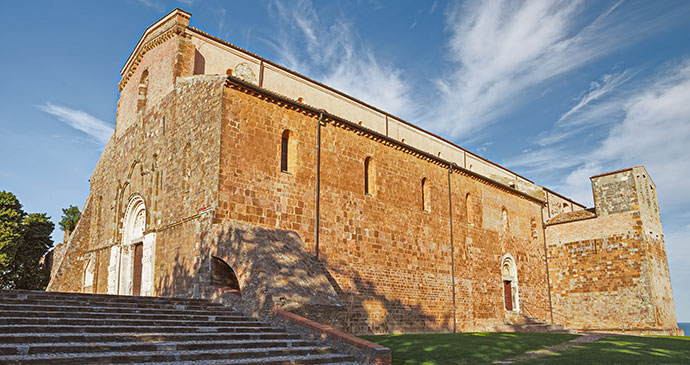
The abbey’s current structure was built in 1165 © Ermess/Dreamstime
Abbey of San Giovanni in Venere
This is one of the most famous and historically significant abbeys in Abruzzo. The current structure was built in 1165 but is said to have been constructed on the site of a Roman temple dedicated to Venus (hence its name, Venere, the Italian for Venus). Its location on a small olive-grove hill 100m from the coast and overlooking the Adriatic makes its situation just as appealing as the building itself.
The entrance into the abbey is through the famous Luna, or moon portal, decorated with some beautiful reliefs. On approach to the abbey, this door appears to be the side entrance but is actually the north-facing main doorway. The nave and its two aisles contain frescoes from the 12th–14th centuries. Some of these are particularly well preserved and vividly coloured, especially those in the crypt.
The abbey’s cloister (closed lunchtime, usually anywhere between 12.30 & 14.00) is perhaps even more attractive than the abbey itself. Its landscaped garden, with roses, palm trees and two tall conifers, is framed by charming lancet arches beneath bright, terracotta roof tiles.
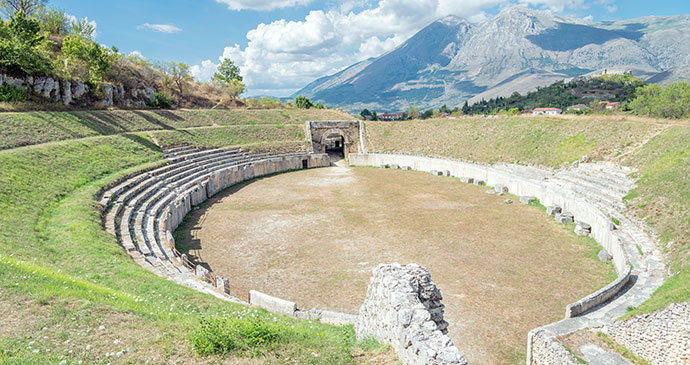
The ancient city of Alba Fucens is well preserved © Matteo Gabrieli/Shutterstock
Alba Fucens
If you take an interest in ancient Rome and its wonderfully convoluted history, Alba Fucens is a must-visit. Set on the hills and framed by the mountains of the Sirente Velino Regional Park, this wonderfully well-preserved ancient city is an easy place to imagine Roman citizens going about their business. Nowadays, the Roman, medieval and modern towns, all in close proximity to one another, show the various layers of settlement in Abruzzo.
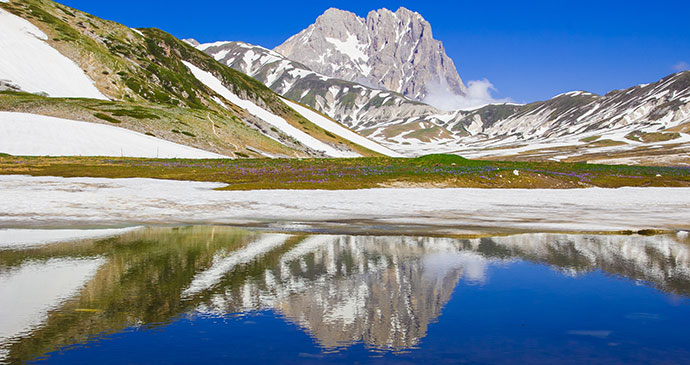
Campo Imperatore is overlooked by the tallest peak of the Gran Sasso National Park © Buffy1982/Shutterstock
Campo Imperatore
Campo Imperatore, sometimes called the ‘little Tibet’ of Italy, is a large plateau at over 1,500m above sea level. It is about 30km long and just under 10km wide, and is overlooked by the tallest peak of the Gran Sasso National Park, the Corno Grande. The area is most popular for its winter skiing, though it’s lovely to walk or drive here during the warmer months.
In 1943, Mussolini was imprisoned at what is now the Hotel Campo Imperatore. Please note that it is a complicated affair to drive around the area from around late October to March owing to heavy snowfalls. Many of the roads are cleared, but it is advisable to take great care and drive with wheel-chains.
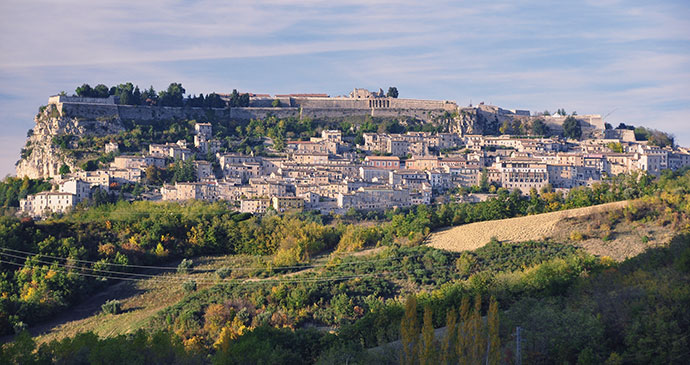
The town is famous for its fortress © Bornin54/Dreamstime
Civitella del Tronto
If you visit only one place in the province of Teramo, it should undoubtedly be the stunning town of Civitella del Tronto (population: approx. 5,000). It is a small, wall-enclosed gem about 650m above sea level and is famous for its impressive fortress, important from both an architectural and a historical point of view. The town has withstood long sieges, such as those instigated by the French in the 1550s and again during the Risorgimento (Italian unification). It was voted one of the most beautiful villages in Italy in 2012.
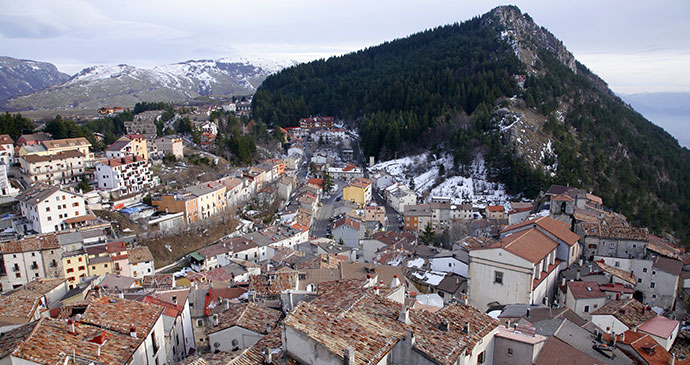
Ovindoli is a town of medieval origins © trotalo/Shutterstock.
For more than a hundred years, this large town of medieval origins has been ‘the’ place in Abruzzo (if not in non-Alpine Italy) for skiing and snowboarding. During the colder months, Italians descend on Ovindoli with as much fervour as they would eat a gelato on a warm, July evening. In fact, the town’s popularity as a summer holiday destination almost rivals its winter tourism due to the beauty of the surrounding landscape. It is situated at the southern end of the Rocche plateau, which connects the Sirente and Velino massifs, and sits at more than 1,250m above sea level.
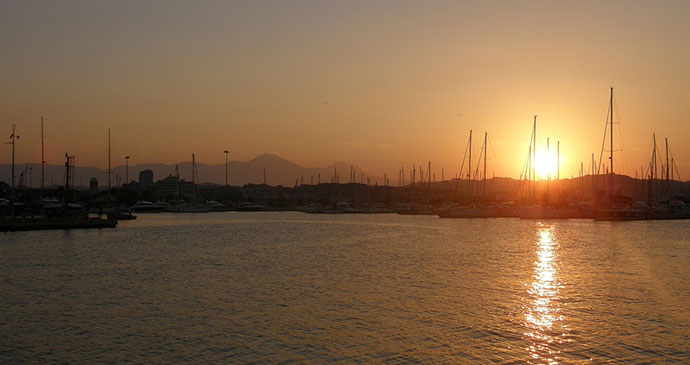
Pescara is especially charming in the warmer months © Ra Boe/Wikimedia-Commons
Despite the obvious lack of evident history or historical landmarks, Pescara is a microcosm of some of the best things Italy has to offer: a dining scene to cherish, a summer atmosphere to knock your socks off, the best shopping in the region and a vibrant beach culture. As the economic powerhouse of Abruzzo, the city has been buffed and shined, and is ready to welcome the willing traveller with open arms.
During summer, Pescara has a knack for changing your outlook on what constitutes la dolce vita . The streets are awash with sunshine and are buzzing in the mornings and late afternoons, only to be found deserted and peacefully silent over the lunchtime and siesta hours. Nothing could be so important as to warrant shortening lunch, the most important meal of the day. Or, God forbid, missing out on those precious forty winks before heading back to work for the afternoon.
Whilst Pescara’s charms are not of the slap-in-the-face variety that are so common among the historical cities of Italy, it is a place well worth exploring, especially in the warmer months, when it really comes into its own. That said, it takes more than a moment or two to see past the concrete façades of the countless post-war apartment buildings to a vibrant, pastel-coloured coastal city that oozes rest and relaxation.
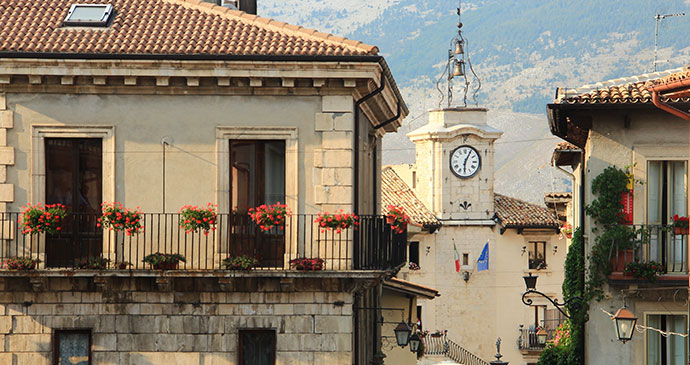
Pescocostanzo is strikingly beautiful © Giuseppe Di Paolo/Dreamstime
Pescocostanzo
Pescocostanzo is widely held to be one of the most striking towns in central Italy. Its architectural and artistic gems include centuries-old houses and public buildings, set on a peaceful plateau in a southern corner of the Majella National Park.
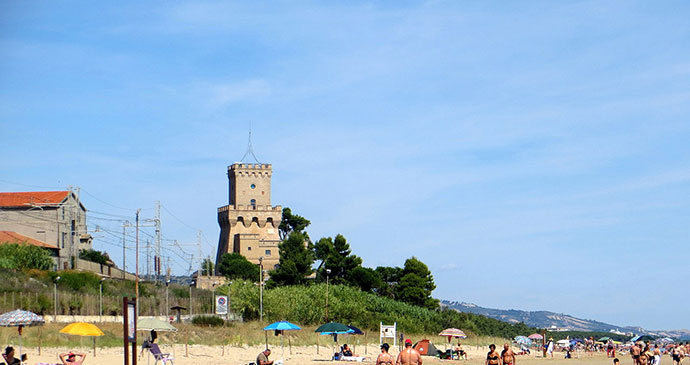
The beach at Pineto was awarded a Blue Flag in 2008 © Luca Aless/Wikimedia Commons
The amiable town of Pineto is arguably one of the prettiest on the Teramo coast. Outside of the hectic summer season it is peaceful and an excellent place to lounge around and recharge your batteries. In 2008 its beach was awarded a Blue Flag, but it narrowly missed out in 2012.
Unlike in many other coastal towns here, the town does not extend to the coast itself, but is separated from the beach by a railway line and a pine grove (from which the town gets its name) planted by Luigi Filiani. This lack of beachfront development combines with the dry Mediterranean hills that frame the town to make it both attractive and serene.
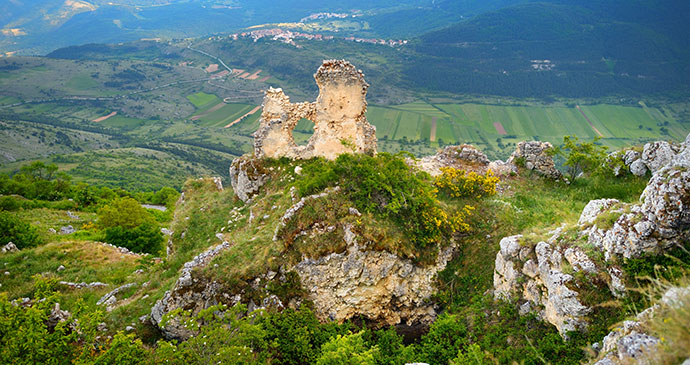
The Rocca Calascio Fortress is 1,500m above sea level © MNStudio, Dreamstime
Rocca Calascio Fortress
This great castle-fortress ( admission free ) is truly imposing and is perhaps one of the most magical sights in Abruzzo. Set at 1,500m above sea level, it’s the highest fortress in Italy and one of the highest in all of Europe. The exact date of construction is not known, but the castle (particularly the central tower) was reinforced in the mid 15th century. The stone fortress, a military stronghold, is notable for its symmetry and the quality of its construction, given the difficulties of building a castle in such an exposed and elevated location. The military reason for building a fort in this position was to give a sweeping view of Abruzzo, and it still has just about the best views to be had in the region, especially at dusk.
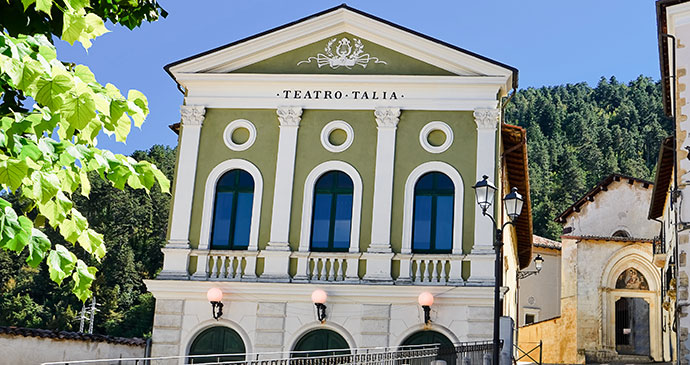
The Talia Theatre in Tagliacozzo © adamico/Shutterstock
Tagliacozzo
A picturesque town of serene lanes and alleys, Tagliacozzo is dotted with medieval and Baroque palazzi. One of the larger settlements in the area, it is renowned for its fairly intact medieval core. The town is not far from Abruzzo’s westernmost border with Lazio and is dramatically situated, as the name suggests ( taglia means ‘cut’), cut sharply into the side of a hill. This means that its streets – most of which you’d not dare try to navigate let alone fit into by car – can be very steep, which makes the town all the more captivating.
Related books
For more information, see our guide to Abruzzo :
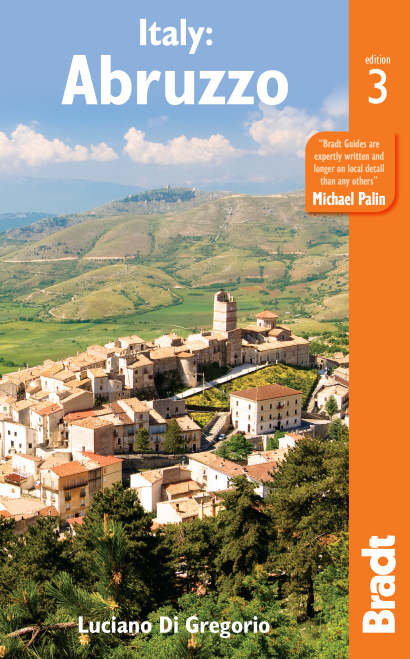
Related articles
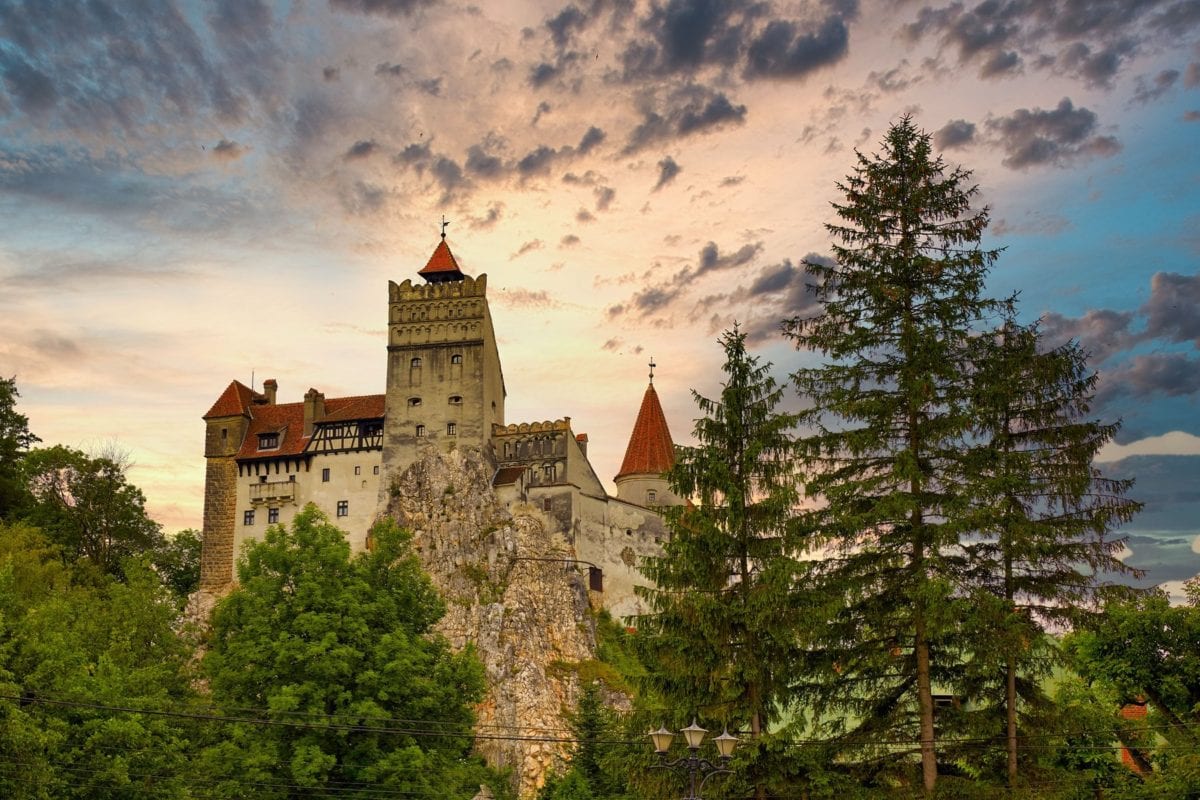
An Englishman’s home: Europe’s most impressive castles
From complex histories to spectacular architecture, castles have so much to offer.
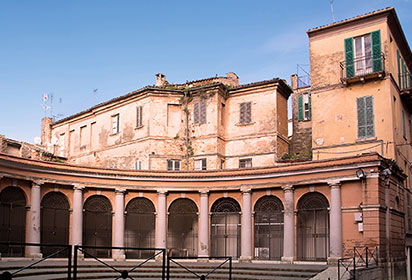
Making the most of a long weekend in Abruzzo
You’ve made it to Abruzzo but you’ve only got a weekend to spare. Here’s how to make the most of a long weekend in the region.
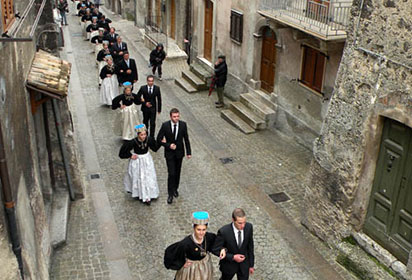
Scanno: At the forefront of fashion?
Scanno is particularly well known for its traditional costume.

A taste of Abruzzo
From pasta to pizza and everything in between, Abruzzo is a paradise for foodie enthusiasts.
Home » Blog » What to see in Abruzzo, a list of the 12 best places
- February 7, 2018
What to see in Abruzzo, a list of the 12 best places
Fabrizio Lucci
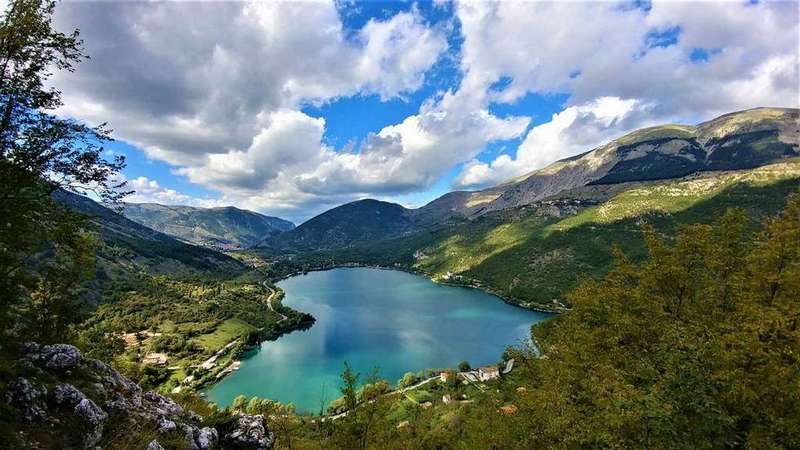
We will now take you on a trip across this incredible region just to give you an idea of what you should expect… And fall in love with.
So what to see in Abruzzo ? Here’s a list of the 12 best places .
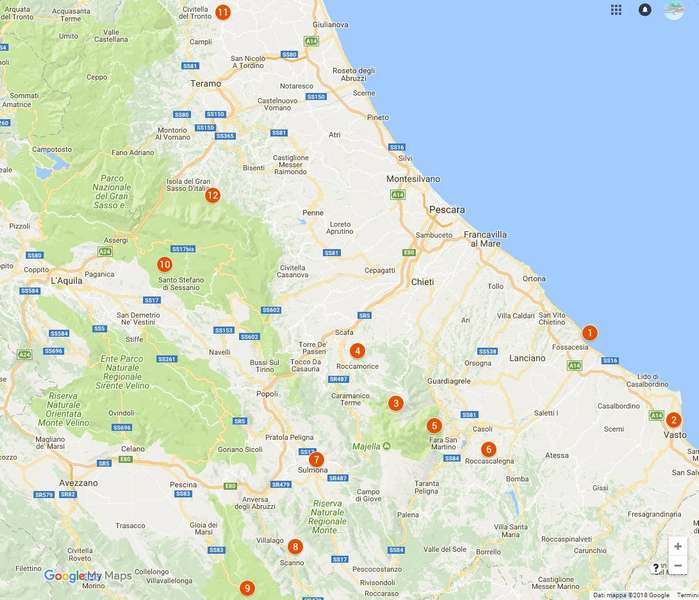
See the full map here .
1. The Trabocchi Coast with its unique fishing platforms
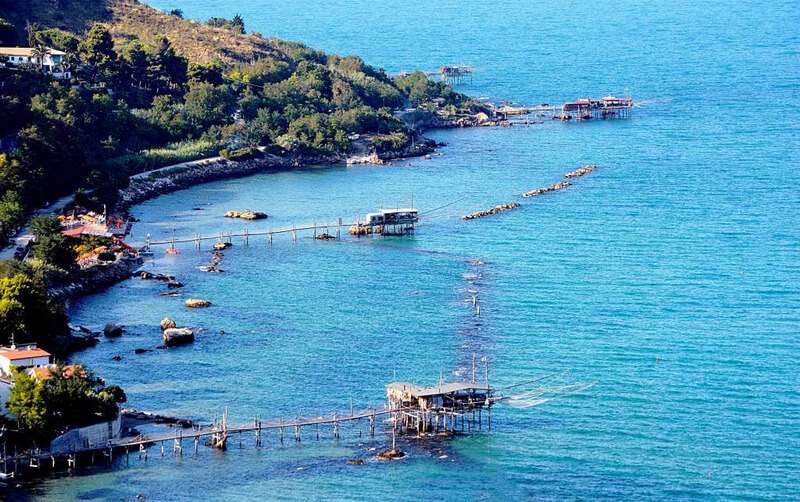
So yes, you can also have lunch or dinner over there!
All our tours include a visit to this charming fishing houses, where you can take part into a fish cooking class and enjoy a wonderful meal.
Another enchanting and still well-preserved gift from the past is the Abbazia of San Giovanni in Venere . Sited on a hill near Fossacesia and built on the site of a Roman temple, it is a wonderful abbey and holy site of art, peace and prayer, a great example of romanic and Italian gothic style. Its privileged position offers an incredible view of the Adriatic sea from north to south.
2. Vasto, the ancient Roman town and its enchanting beaches
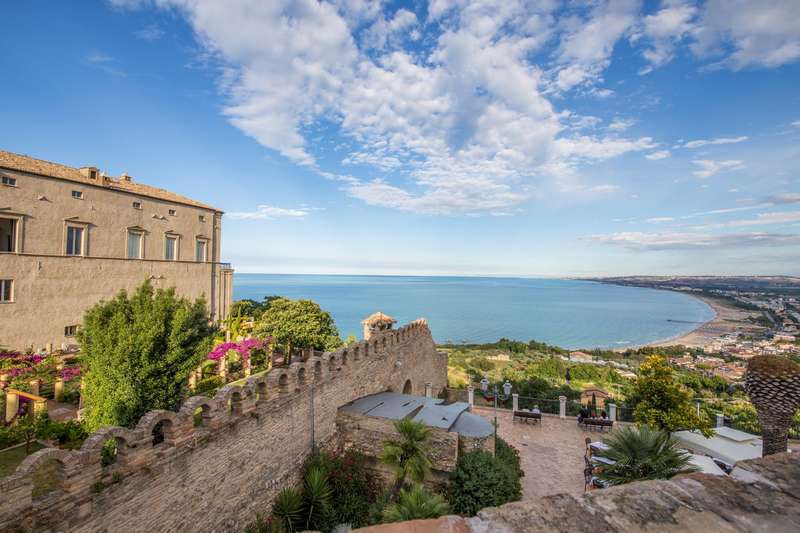
Vasto is a hilltop town overlooking the Adriatic sea in southern Abruzzo. The old centre is a lovely medieval spot with beautiful buildings dating from the 15th century.
Taking a walk from Piazza Rossetti , you will see the Caldoresco Castle , the San Giuseppe Cathedral with its Romanesque facade, and Palazzo d’Avalos : here you can visit its museums and Neapolitan-style gardens. If you keep wandering through the narrow alleyways you will find yourself speechless in front these ancient buildings and the view over the gulf.
Vasto is also well known for the variety of its beaches . Going downhill from the ancient centre you will reach Vasto Marina, a popular holiday destination full of many beach resorts. If you keep going north along the coast, nature will surprise you with a rocky spot and its crystal clear water: this is hidden gem of San Nicola .
Further along the coast, past the lighthouse at Punta Penna ( the second tallest lighthouse in Italy ) is another, even quieter, beach, by a nature reserve at Punta Aderci , which was listed as one of the 10 most beautiful Italian beaches for 2018 by the The Telegraph UK . Vasto is a stop-over of all our tours, and we will make sure you will leave it with the greatest memories.
3. Passolanciano-Majelletta, skiing and hiking with a sea view
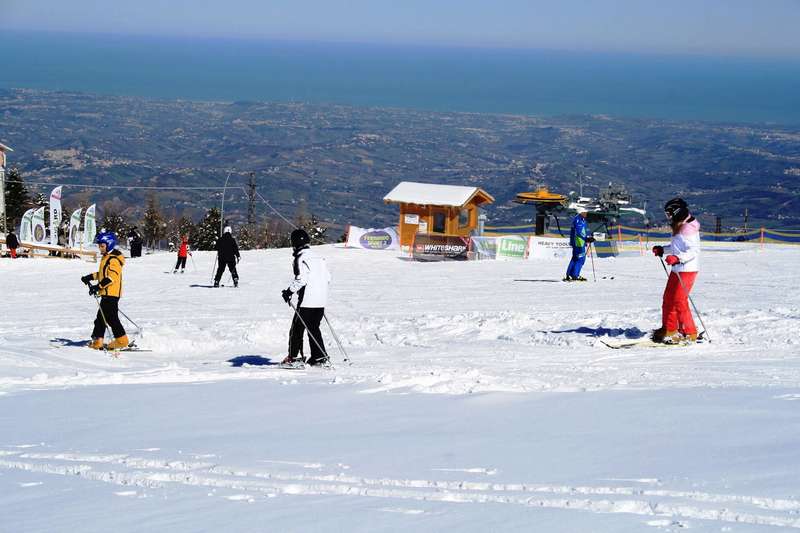
Have you ever skied with a sea view? Passolanciano – Majelletta is a ski resort that offers a unique scenery at almost 2000 meters above sea level, overlooking the Adriatic coast.
This area is also a great place for hiking, walking through incredible sceneries and discovering solitary and remote hermitages set in the rocky mountainside.

4. The stunning landscapes and treasures of Majella National Park
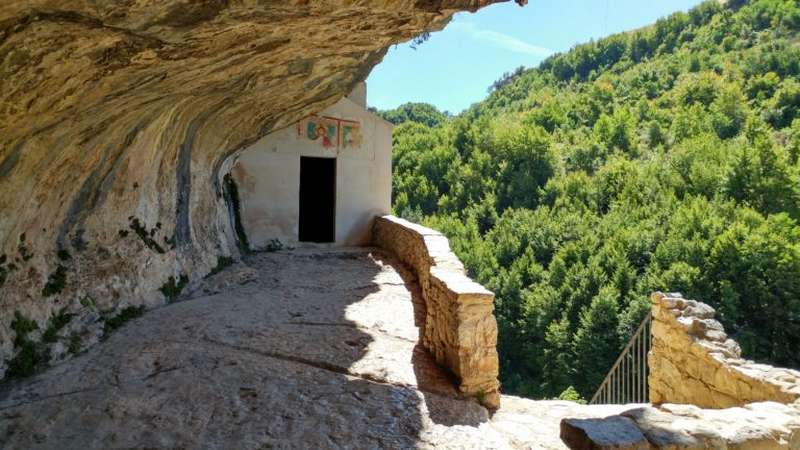
Majella National Park is one of three national parks of the region, together with National Park of Abruzzo, Lazio and Molise , and Gran Sasso and Monti della Laga National Park .
It is one of the best preserved apennine ecosystems, made of nearly 100 square miles of immaculate mountains and canyons to enjoy.
In the warmer months, its hiking trails are the ideal activity for those who love the great outdoors.
Our Cultural, Culinary & Walking Experience Tour in Abruzzo will guide you through the beauty of this area: we will reach the Hermitage of San Bartolomeo in Legio , Abruzzo’s most famous rock face retreat , just outside the town of Roccamorice , c arved into the mountain and immersed in the silence of the surrounding woods, and the Hermitage of Santo Spirito , one of the most important monasteries of the Majella.
They are both so evocative that, around 800 years ago, the future pope Celestino V chose them as the places for his meditation and prayers.
5. Fara San Martino, the kingdom of Italian pasta
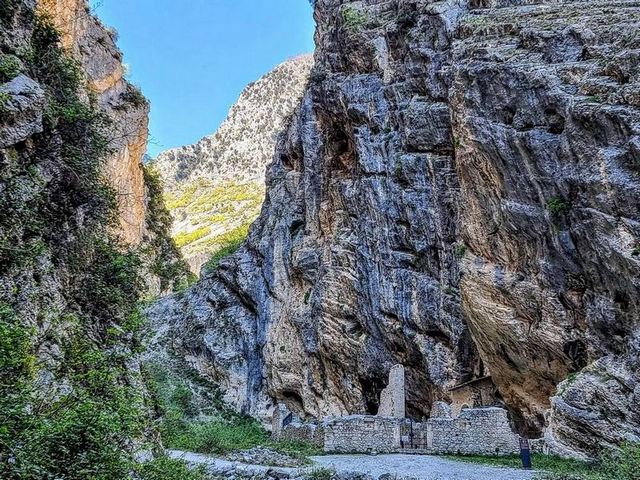
Abruzzo also has a long history of pasta-making . Located in the Majella National Park, the quaint village of Fara San Martino is known for the distinctive flavor and quality of its pasta. It is home to three of the most widely recognized high-end pasta brands, De Cecco, Delverde and Cocco.
We cannot share the secrets of how they make it (actually, nobody knows them!), but we will still be able to teach you the best techniques to make it on your own if you wish… You just have to take part into one of our cooking classes!
Fara San Martino is also known for its “gole” , located a few minutes away from the town, one of the longest Italian canyons (9 miles), a wonderful path for walks and picnics.

6. The medieval atmosphere of Roccascalegna and its castle
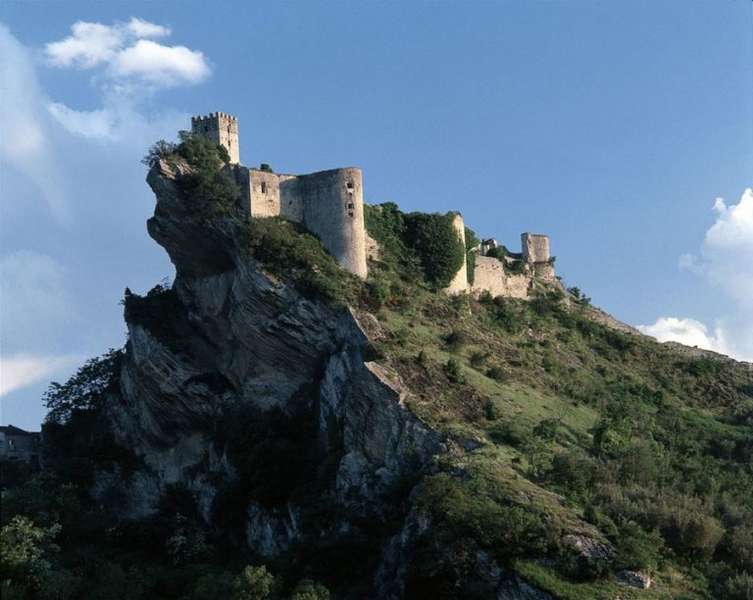
There are more than fifty castles in Abruzzo alone, but this is definitely one of the most impressive.
It is a must see spot for anyone who visits Abruzzo.
7. Sulmona, the capital of “confetti”
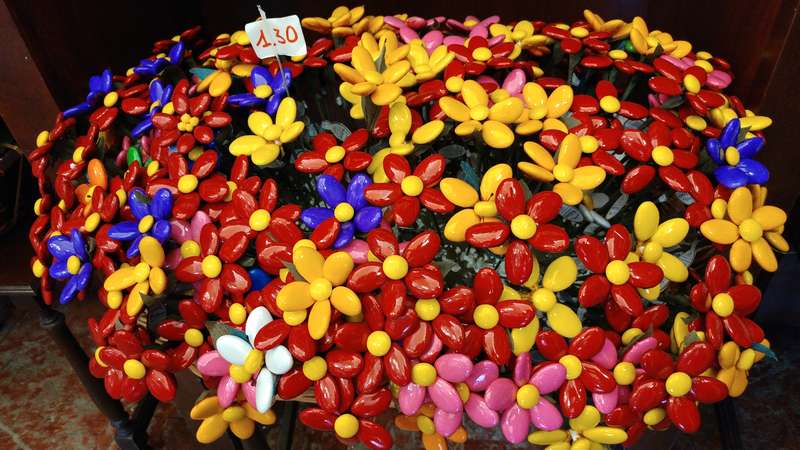
Sulmona is a charming town located at the foot of the Majella, surrounded by mountains, where ancient history and a strong tradition for colorful sweets live together making it one of the most famous villages in Abruzzo.
Originating as Sulmo, a town of the Peligni (an ancient Italic people), it was later a Roman possession and was the birthplace of the 1st-century Roman poet Ovid .
Nowadays, it is famous for being the capital of sugared-coated almonds, known as “confetti” in Italian. Its streets are adorned with colorful confetti bouquets, which you can buy in any imaginable flavor – Nutella, tiramisu, ricotta and pear, fruits of the forest, hazelnut, and anything you can think about.
8. The magical village and lake of Scanno

The same lake touches Villalago , a tiny village located 15 minutes away from Scanno, mostly known for the Hermitage of San Domenico , a small church surrounded by peace and the beauty of nature.
9. Abruzzo National Park, deep in the heart of nature
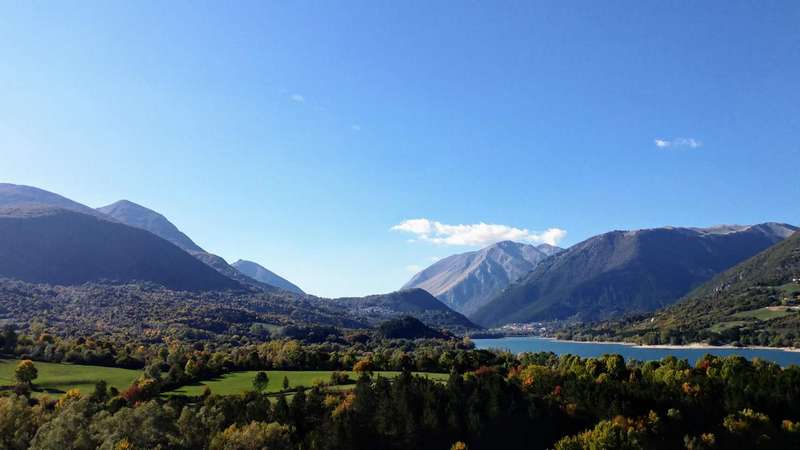
It is home to 25 towns, of which two of the most widely known are Pescasseroli – a popular ski resort in winter an excellent base camp in warmer months to explore the plant and wildlife of the forest landscape – and Civitella Alfedena , located in an area inhabited by the Appennine wolf and lynx.
The Park is the ideal destination for anybody who wants to experience a break from crowded cities and get immersed in the heart of nature, taking a walk or a drive through the fascinating paths from where it’s quite common to see the local fauna.
10. The fabulous hamlets and panoramic views of Gran Sasso
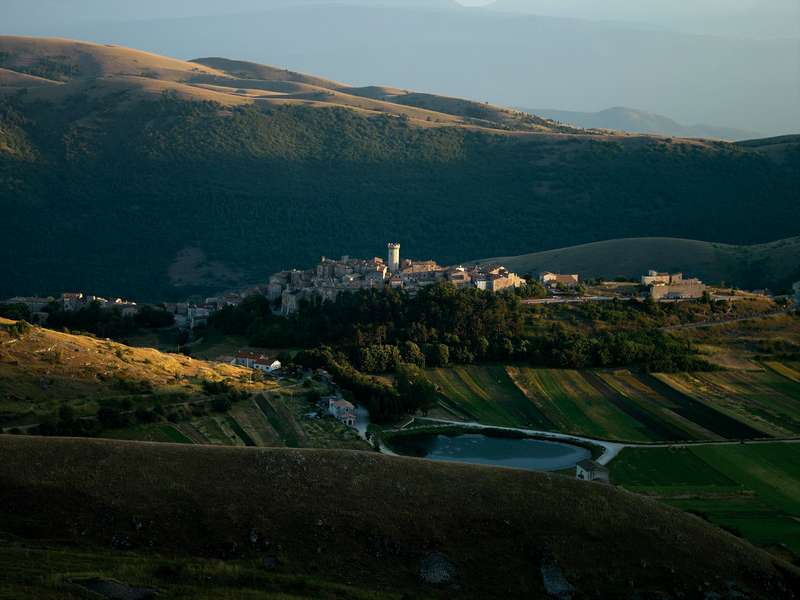
Gran Sasso d’Italia is a mountain massif located in Abruzzo. Its chief peak, the Big Horn , is the highest mountain of central Italy. It is located in the Gran Sasso and Monti della Laga National Park , another great spot for excursions and “hamlet-hunting”: we will now introduce you to three gems that are definitely worth a visit.
Have you heard of “extended hotel”? In Italian we call it “ albergo diffuso ” and Santo Stefano di Sessanio is one of the greatest example of this peculiar way of being a tourist and a local resident at the same time.
In order to protect the ancient architecture of the village that was mainly left in abandonment, in the last 15 years many houses and structures have been restored and converted into vacation homes. This means you will basically breathe the medieval atmosphere just like it was in old times.
A few minutes away from Santo Stefano di Sessanio there is another not-to-be-missed stop in the area: it is the 12th Century military fortress of Rocca Calascio , proudly standing in the middle of nowhere, and offering the most glorious views of the surrounding countryside and mountains. No wonder why, among others, it was chosen as the set for The Name of the Rose , with Sean Connery, and Lady Hawke , with Michelle Pfeiffer.
Talking about panoramic sceneries, Campo Imperatore (“Emperor’s Field”), the largest and highest Alpine meadow of the region, is another must for visitors to Abruzzo. The magic, history, colors and harmony of the surroundings will leave you speechless all year round.
11. Civitella del Tronto and its impressive fortress
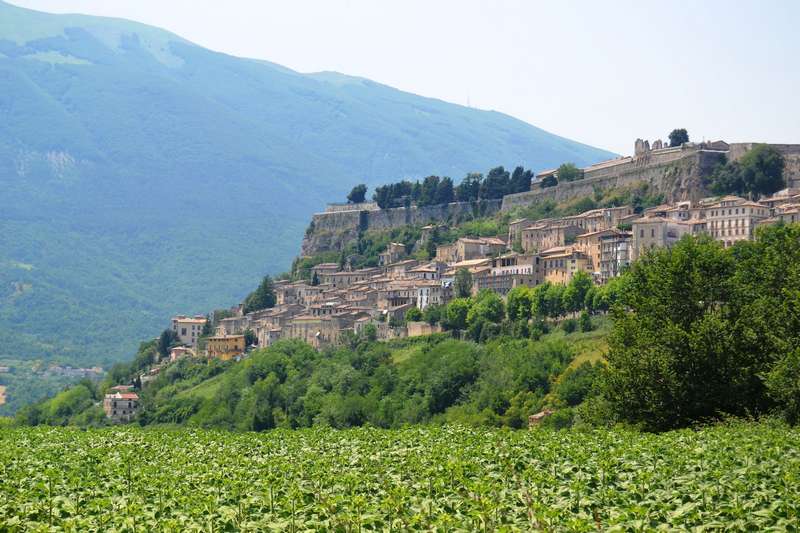
Civitella del Tronto is another enchanting town in the Gran Sasso e Monti della Laga National Park . It is home to the largest fortress in Italy and the second largest in Europe, that offers 360° views over three different mountain ranges, the village below and the Adriatic sea: absolutely stunning.
After admiring this incredible military architecture, you can wander down the hill and explore all the streets and alleys of the small village and try to fit into the smallest street of Italy, that is called “ruetta”… We will be happy to teach you how to pronounce it!
12. Castelli, the home of world famous hand-painted ceramics
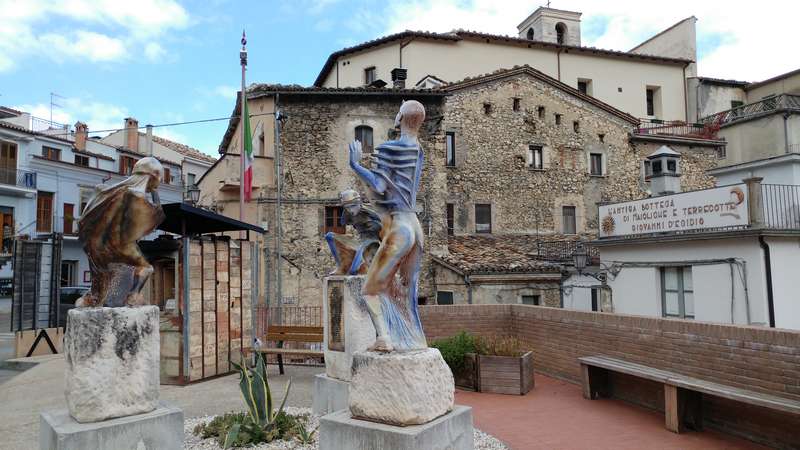
Castelli (located within the Gran Sasso e Monti della Laga National Park ) is the capital of Abruzzo’s version of decorative ceramics, which were collected by the nobility of Europe for centuries.
Majolica is the name given to pottery with clear colored glazes and these brightly colored hand-painted pieces are famous for their characteristic “pentacromia,” a five-color palette of yellow, green, blue, orange, and brown.
There are plenty of shops and factories to visit, and if you would like to make your own Castelli masterpiece, you just need to take part into one of the culture and art tours of Abruzzo .
Ready to Go?
So if you’re tired of the same-old same-old city tours of Rome or Venice, why not experience the authentic Italy of Abruzzo?
Get in touch today to help bring your dream tour into focus – wouldn’t you love to see the Adriatic sea from the mountains or to have a lunch suspended over the sea? And if you’re not quite ready to make an enquiry, sign up for our free email course to learn everything you need to know about planning a tour of Abruzzo.

Love Italy? You've come to the right place.
Enter your details to get travel inspiration, curiosities and amazing offers delivered to your inbox
I authorise the processing of personal data transmitted pursuant to the Italian & EU law on privacy 679/2016
20 thoughts on “What to see in Abruzzo, a list of the 12 best places”
Congratulations and thanks for this great picture of Abruzzo. Keep up the good work !
Many thanks for your nice words David, keep following us. Fabrizio
My grandfather from antrodrocco
This company is amazing. It is unlike any other tour I have ever been on. Fabrizio is a thoughtful, friendly, well educated guide. He will personalize your tour to cover your areas of interest. The groups are small so you do not feel herded or hurried. The food experiences are authentic with an amazing variety of area specialties. Fabrizio is from Vasto and is especially proud of his native area and wants to share his culture with his guests. You could not do better than this tour to a much less “touristy” area of Italy. Grazie Febrizio.
Dear Gerry, many thanks for your wonderful words. I’m really happy to read them, grazie mille and ciao for now, Fabrizio.
Every word is true. Abruzzo is magical and Fabrizio is the most conscientious guide you can imagine. Go to Abruzzo and experience the best time of your life with Fabrizio. Ciao amico Fabrizio!
Dear Pamela, many thanks for your wonderful words. I’m really happy to read them, grazie mille and ciao for now amica mia:-), Fabrizio.
Many thanks for your wonderful words. I’m really happy to read them, grazie mille and ciao for now, Fabrizio.
Is there any hill towns with sea views? 15 miles or so from the coast.
my hometown, and our base, Vasto, is an hill town with sea view, it is 2.5 miles from the coast. Click here to discover more: https://italiasweetitalia.com/vasto-abruzzo-an-evocative-itinerary-between-memories-and-beautiful-spots/
Many thanks for your interest,
Fabrizio I am considering a trip to Abruzzo in 2023, my family is from Luco Dei Marsi and Opi… possibly Civitella Alfedna (if my ancestry research is correct). Can you recommend how to add these places into a trip..
Ciao Andrea
Ciao Andrea,
many thanks for your comment and it si nice to know that you are “abruzzese”.
I’m sending a private e-mail to your.
Best regards
Do you have experience with Alfedena? My grandfather is from there so coming to Abruzzi I’d like to see Alfedena.
Buongiorno Ivie,
many thanks for sharing with us your family information.
I just sent you an email.
Grazie and ciao for now
Thanks for your beautiful information
Buongiorno Fatima, thank you for your kind words!
We will be in Sulmona Sept 4 to 7 2024 . 4 people can we set up a tour with you? My Grandfather was born in Sulmona.
Thanks, Donna
Ciao Donna,
many thanks for contacting me.
I’m sending you an e-mail.
I would be happy to let you discover (y)our culture, traditions, food, landscapes and people through one of our tours of Abruzzo that you can discover here: https://www.italiasweetitalia.com/italian-cookery-holidays-calendar-and-booking/ .
Thank you and ciao for now
Hello Fabrizio,
My husband and I are staying in Castel di Sangro this June 20-24, 2024 for the SIM festival, then plan to explore more of Abruzzo. Would love to explore some possible tour ideas with you.
Grazie, Barbara
Buongiorno Barbara,
How wonderful to hear that you will be coming to Castel di Sangro in June!
On our website, you will find all the available tours to explore Abruzzo with me, with updated dates even for 2025: https://italiasweetitalia.com/full-calendar/
I wish you a stay in Abruzzo full of unforgettable memories.
Ciao for now
Leave a Comment Cancel Reply
Your email address will not be published. Required fields are marked *
Save my name, email, and website in this browser for the next time I comment.
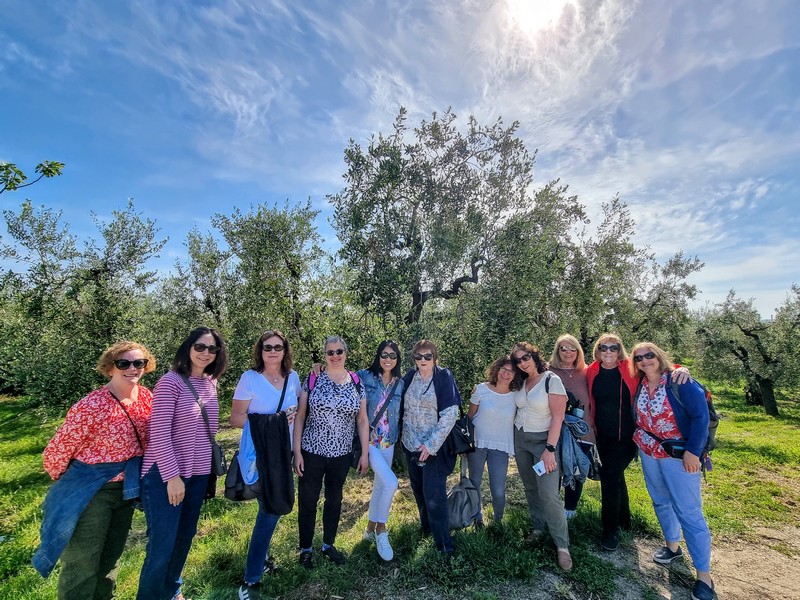
Travelers stories: Shawn and her Only Women Travel in Abruzzo
Since we started our adventure with Italia Sweet Italia we have always shared our passion for Abruzzo and tried to instill it in our guests.
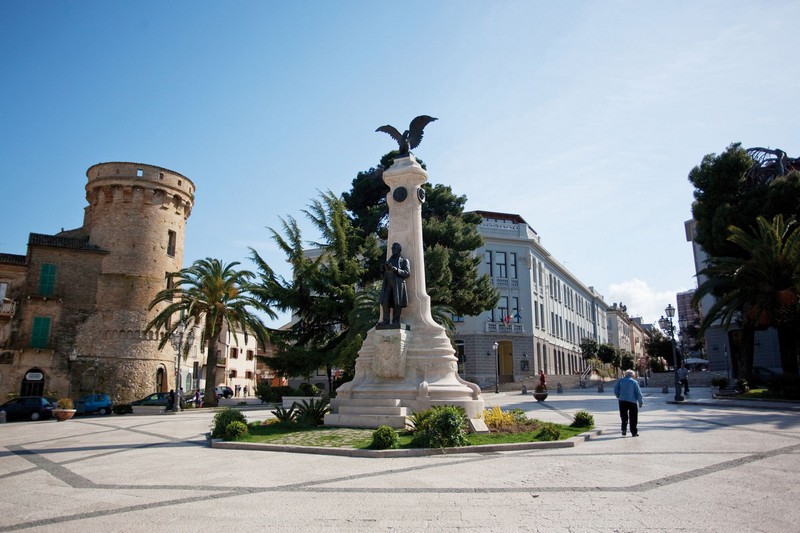
Celebrating the Legacy of Gabriele Rossetti: Piazza Rossetti, Cultural Hub of Vasto
Gabriele Rossetti, a distinguished Italian poet, writer, and patriot of the 19th century, is renowned for his significant contributions to Italian literature and culture. His
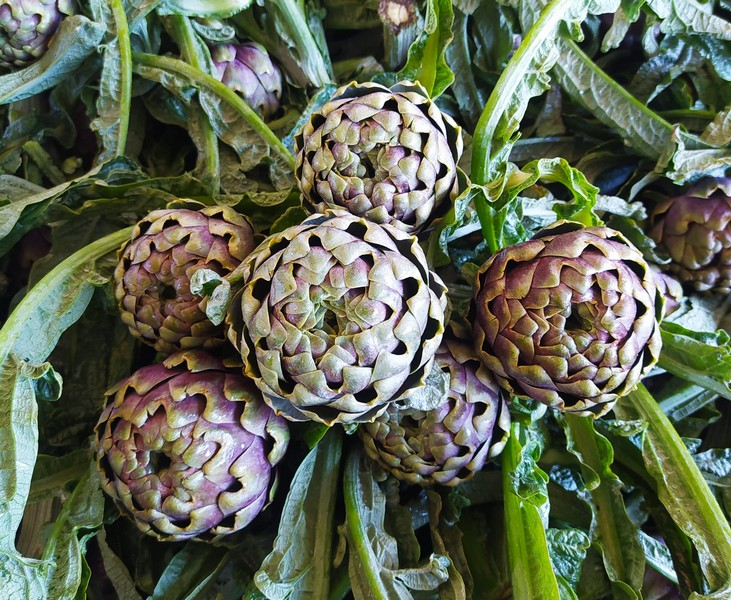
Cupello: The Heart of Flavor – The Tradition of Mazzaferrata Artichoke
In the heart of Abruzzo, amidst the fertile hills of the province of Chieti, lies a village that tells centuries of history and passion: Cupello.
Are you ready to experience Abruzzo and Beyond?
The abruzzo, puglia & matera experience €3,565, cultural, culinary & walking experience in abruzzo €1,985, food, culture and wellness in the hidden emilia romagna €2,595.
- Emilia-Romagna

If you have any questions or an authentic Italian vacation idea for yourself or a group that you would like to discuss with Italia Sweet Italia please do get in touch with Fabrizio by any of the methods below:
- Mobile | WhatsApp (call or text): +39 349 8630483 (Fabrizio)
- E-Mail: [email protected]
Click here to Schedule a Free Consultation with Fabrizio to Discover more about Abruzzo and our Tours
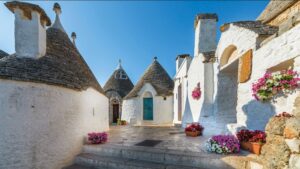
The Abruzzo, Puglia & Matera Experience
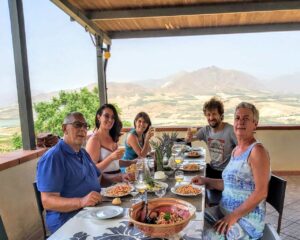
Culture and food trip in authentic Sicily

Cultural, Patron Saint Celebrations & Grape Harvest Experience in Abruzzo
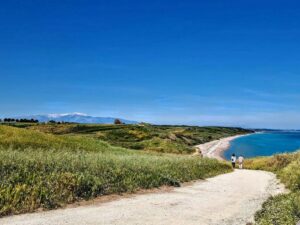
Cultural, Culinary & Walking Experience in Abruzzo
© 2023 Italia Sweet Italia Holidays S.R.L. Unipersonale | Partita Iva/Codice Fiscale: 02811920699 | Via Circonvallazione Histoniense n. 501/A – 66054 Vasto (CH) – Italy | Terms of Use
Download Free cooking booklet
Discover our authentic recipes from Abruzzo passed down over the years for generations
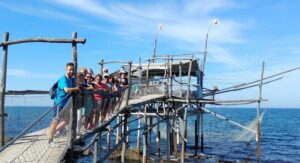
Discover Authentic Italy With Fabrizio: How to Plan an Amazing Tour of Abruzzo
Our 6-part free email course will walk you through everything you need to know about planning - and enjoying - an amazing tour of abruzzo..
- Chef Interviews
- Restaurants and Dining
- Specialty Food
- The Hamptons
- New England
- Interior Design

Top 6 Travel Hacks for the Ultimate Korean Adventure
What car type should you pick if you rent a car…, why tokyo should be your next bucket list destination, chilling adventures: essential considerations for traveling to extreme cold destinations, from compostable plates to cutlery: complete solutions for creating a sustainable…, 15 easy-to-pack travel snacks for your next trip, pleasure & health: improve your life with a high-quality tea, the mother’s day gift guide, the best bakeries in london, a timeless european journey: italy, france, and the uk, top day trip destinations from birmingham by train, planning your entertainment for a uk getaway, pet friendly hotels across the hamptons, restaurants that serve brunch on the south fork year round, 12 essential hamptons restaurants, hamptons passover and easter restaurant dining specials, coffee shops to know across the hamptons, how to spend the perfect 24 hours on the north fork, 15 essential north fork restaurants, where to stay on shelter island, get to know the beaches on the north fork, the must-try brunch restaurants on the north fork, a once in a lifetime road trip through new mexico, escape the crowds with these 5 underrated spots in silverton, oregon, the perfect day trip to temecula valley in california, 6 must-do activities on your maui holiday, how to maintain a snow-white smile, planning the perfect housewarming party: 10 tips to get started, how to tidy up your living space and outdoors after a…, how to handle injuries from broken sidewalks in austin, the best 2-day travel itinerary for abruzzo, italy.
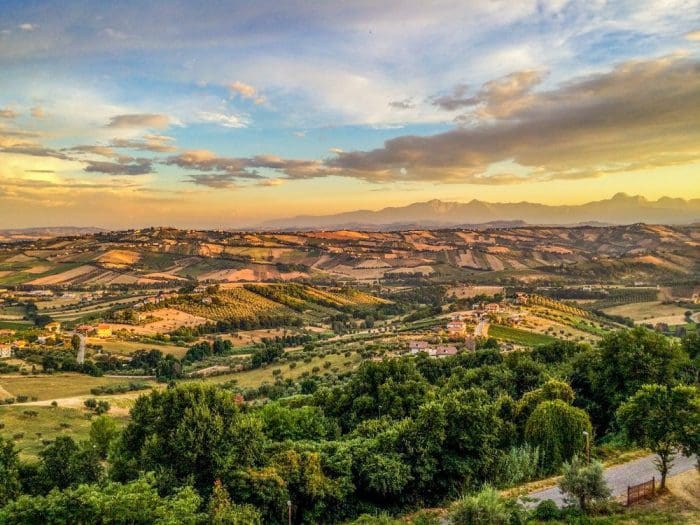
Abruzzo is a region of central Italy that boasts stunning landscapes ranging from the Apennine Mountains to the Adriatic Sea. The region is rich in history, culture, and traditions, and it is renowned for its excellent cuisine, wine, and hospitality. Here is a suggested two-day travel itinerary for Abruzzo, including tips on how to travel from Rome, the best places to visit, the best food to try, and where to stay.
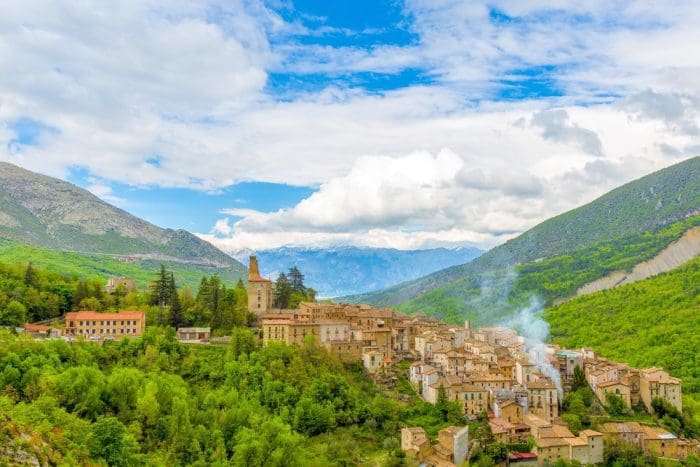
The easiest way to travel to Abruzzo from Rome is by train or car. If you choose to take the train, the journey will take about two hours, and you can catch a train from Termini station in Rome to Pescara station in Abruzzo. If you prefer to drive, it will take approximately two and a half hours, and you can take the A24 highway.
Sulmona is a charming town located in the heart of Abruzzo, famous for its sugared almond confectionery, known as “confetti.”
The town is also home to the Romanesque church of San Panfilo and the impressive Medici aqueduct. Enjoy lunch at a local trattoria, and don’t forget to try some confetti for dessert.
Scanno Scanno is a picturesque medieval town situated in the Majella National Park. The town is known for its traditional stone houses and narrow streets, and it offers stunning views of Lake Scanno. Take a stroll through the town, visit the Church of Santa Maria della Valle, and stop by the Museum of Popular Arts and Traditions.
Pescara Pescara is a lively coastal city located on the Adriatic Sea, known for its beautiful beaches, seafood restaurants, and nightlife. Enjoy a relaxing evening at the beach, dine at a local restaurant, and stay overnight at one of the many hotels in the city.

Chieti is a historic town located on a hill overlooking the Pescara River valley. The town is home to the National Archaeological Museum of Abruzzo, which showcases the region’s ancient history and culture. Visit the Cathedral of San Giustino, the Church of Santa Maria Maggiore, and the Roman Theatre.
Lanciano Lanciano is a medieval town located in the foothills of the Majella Mountains, known for its delicious cuisine and excellent wine. Enjoy lunch at a local restaurant, and don’t miss out on trying the local pasta dish called “maccheroni alla chitarra” and the traditional lamb stew.
Santo Stefano di Sessanio is a beautiful medieval village located in the Gran Sasso e Monti della Laga National Park. The village is known for its stunning views of the mountains, traditional stone houses, and the impressive Rocca fortress. Take a walk around the village, visit the Church of Santo Stefano, and enjoy a coffee at a local café.
L’Aquila is the capital city of Abruzzo, located at the foot of the Gran Sasso Mountains. The city is known for its Renaissance architecture, beautiful churches, and traditional cuisine. Enjoy a leisurely stroll through the historic city center, visit the Basilica di Santa Maria di Collemaggio, and dine at a local restaurant.
Where to stay
There are many excellent hotels and guesthouses in Abruzzo, ranging from luxury resorts to traditional B&Bs. Some of the best options include the Hotel Villa Maria in Pescara, the Palazzo Tour d’Eau.
Small Towns and Villages of Abruzzo
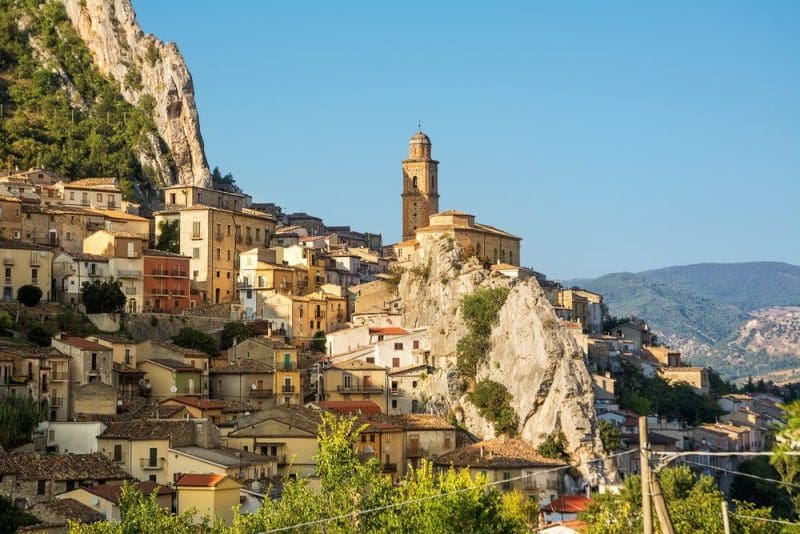
Vasto is a beautiful coastal town located in the province of Chieti, in the southern part of Abruzzo. The town is situated on a hill overlooking the Adriatic Sea, and it is known for its stunning beaches, historic landmarks, and lively atmosphere. Here is some information on what to do and see in Vasto:

Vasto Old Town
The Old Town of Vasto is a charming and picturesque area, with narrow streets, historic buildings, and stunning views of the sea. You can visit the Cathedral of San Giuseppe, the Palazzo d’Avalos, and the Museum of Sacred Art and Crypt of San Michele Arcangelo. Take a stroll through the town, explore the alleys, and admire the stunning architecture.
Vasto Marina
Vasto Marina is the seaside area of Vasto, with miles of sandy beaches, crystal clear waters, and plenty of seaside resorts, restaurants, and bars. You can enjoy sunbathing, swimming, or watersports, and sample the delicious seafood dishes served in local restaurants. Don’t miss out on trying the “brodetto vastese,” a traditional fish stew made with a variety of local fish and shellfish.
Punta Aderci Nature Reserve
Punta Aderci is a stunning nature reserve located near Vasto, with a beautiful stretch of coastline, sandy beaches, and a rocky promontory. The reserve is home to a variety of flora and fauna, including sea turtles, dolphins, and rare bird species. You can hike along the trails, explore the coves and cliffs, and enjoy the stunning views of the sea.
Trabocchi Coast
The Trabocchi Coast is a beautiful stretch of coastline that runs along the Adriatic Sea, from Ortona to Vasto. The coast is known for its unique fishing structures called “trabocchi,” which are wooden platforms built on stilts that extend into the sea. The trabocchi were used by local fishermen to catch fish, and many of them have been restored and transformed into restaurants.
Vasto Wine Tour
Vasto is also known for its excellent wines, particularly the Montepulciano d’Abruzzo and the Trebbiano d’Abruzzo. You can take a wine tour to discover the local vineyards, taste the wines, and learn about the winemaking process. Some of the best wineries in the area include Tenuta Terraviva and Cantina Frentana.
Where to Stay in Abruzzo
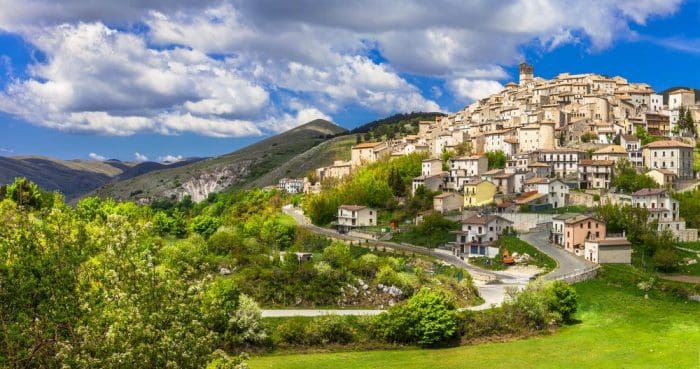
Vasto has a wide range of accommodation options, from luxurious hotels to cozy guesthouses and B&Bs. Some of the best places to stay in Vasto include the Hotel dei Sette, the Hotel Acquario, and the Hotel San Marco.
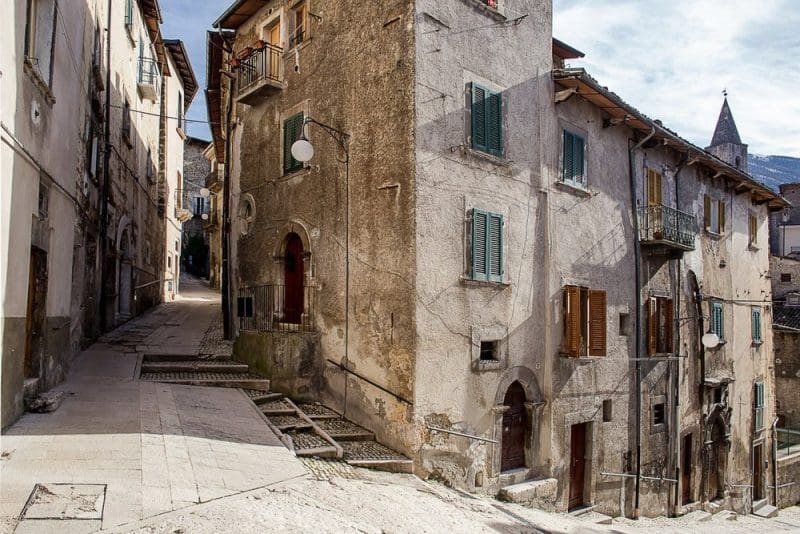
Wineries of Abruzzo
Abruzzo is known for its excellent wines, and there are many wineries in the region that offer wine tastings, vineyard tours, and other wine-related activities. Here are five of the best wineries in Abruzzo:
Cantina Zaccagnini
Cantina Zaccagnini is located in the village of Bolognano, in the province of Pescara. The winery is known for its Montepulciano d’Abruzzo, one of the most famous wines of the region. The winery offers tours of the vineyards and the cellars, as well as wine tastings accompanied by local food specialties.
How to get there
Cantina Zaccagnini is located about 30 km from Pescara. The easiest way to get there is by car or taxi.
Masciarelli
Masciarelli is a well-known winery located in San Martino sulla Marrucina, in the province of Chieti. The winery produces a variety of wines, including Montepulciano d’Abruzzo, Trebbiano d’Abruzzo, and Cerasuolo d’Abruzzo.
Masciarelli is located about 40 km from Pescara. The easiest way to get there is by car or taxi.
Tenuta Terraviva
Tenuta Terraviva is a family-run winery located in the town of Vasto, in the province of Chieti. The winery produces a variety of wines, including Montepulciano d’Abruzzo, Trebbiano d’Abruzzo, and Pecorino. .
Tenuta Terraviva is located about 60 km from Pescara. The easiest way to get there is by car or taxi.
Valle Reale
Valle Reale is located in the town of Popoli, in the province of Pescara. The winery produces a variety of wines, including Montepulciano d’Abruzzo, Trebbiano d’Abruzzo, and Cerasuolo d’Abruzzo.
Valle Reale is located about 40 km from Pescara. The easiest way to get there is by car or taxi.
Cantina Frentana
Cantina Frentana is located in the town of Rocca San Giovanni, in the province of Chieti. The winery produces a variety of wines, including Montepulciano d’Abruzzo, Trebbiano d’Abruzzo, and Passerina.
Cantina Frentana is located about 50 km from Pescara. The easiest way to get there is by car or taxi.
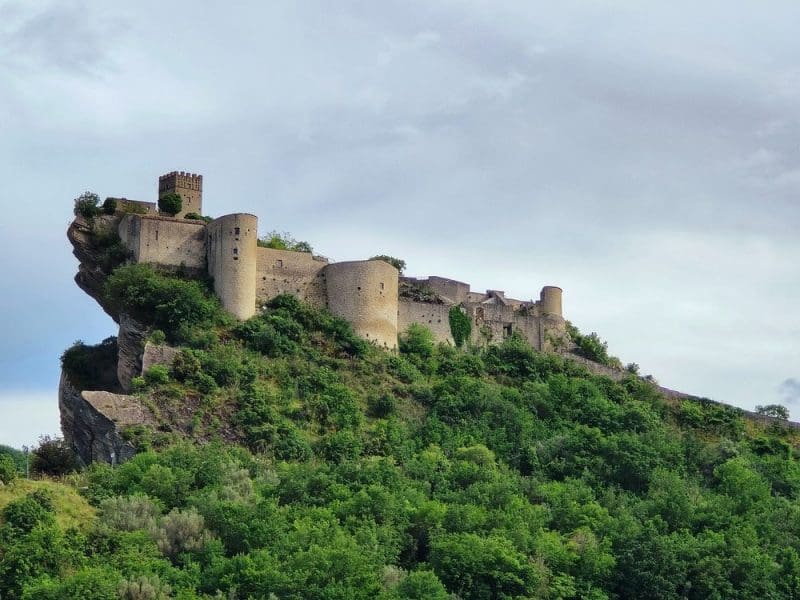
A Guide to Pecorino Wine of Abruzzo
Pecorino is a white wine grape variety that is grown primarily in the central Italian regions of Marche, Abruzzo, and Umbria. In Abruzzo, Pecorino is primarily grown in the province of Teramo. The grape produces wines with a distinct floral and citrus aroma, and a slightly herbal and mineral flavor.
Pecorino wines from Abruzzo are usually dry, with medium to high acidity and a light to medium body. They are often described as having flavors of lemon, lime, grapefruit, and peach, with a slightly bitter finish. Pecorino wines from Abruzzo are typically enjoyed young, within a few years of their vintage.
When purchasing Pecorino wine in Abruzzo, it is a good idea to visit the wineries themselves, as this will give you the opportunity to taste the wine and learn more about the winemaking process. Many of the wineries in Abruzzo also offer guided tours of the vineyards and the cellars, which can be a fun and educational experience.
RELATED ARTICLES MORE FROM AUTHOR
What car type should you pick if you rent a car gold coast vacay, popular categories.
- Lifestyle 868
- Food And Drink 331
- United States 208
- Wellness 157
- Interior Design 102
- The Hamptons 87
- Privacy Policy

- What to see in Abruzzo: 10 unmissable places
- Places and Tours
What to see in Abruzzo ? Between mountains, national parks, and villages to discover, you will be breathless. Come and discover it with us.

Abruzzo is one of the Italian regions where it is possible to admire the spectacular strength of Mother Nature . Lakes, mountain rivers, nature reserves. But the region of Abruzzo is also a land rich in history, an important bastion of the Kingdom of Naples on the border with the papal possessions. So are you ready for our adventurous journey?
10. The Fortress of Civitella del Tronto: on the edge of the kingdom
.jpg)
The Fortress of Civitella del Tronto (Teramo) is one of the most important engineering works on the Italian peninsula. Built from the fifteenth century by the Aragonese, the Fortress was later enlarged and modified by the Spanish Habsburgs and the Bourbons, representing an important bastion on the border between the Spanish Viceroy and the Papal State. Currently the structure is entirely viable and houses an interesting Museum of Weapons.
9. The Gran Sasso and Monti della Laga National Park: the force of nature
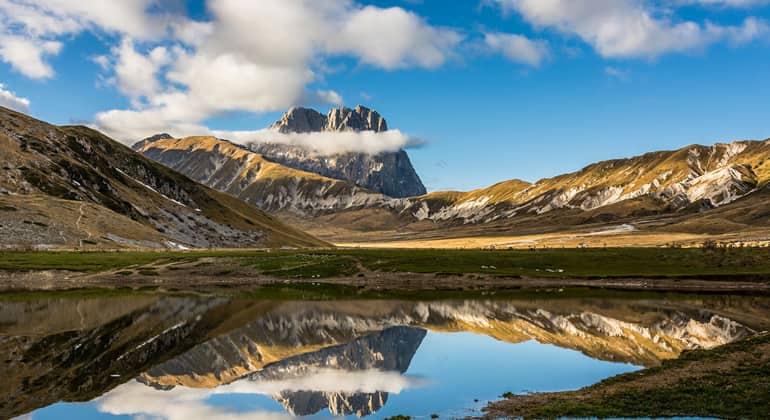
For nature lovers and hikers, the ideal destination to reach is the Gran Sasso and Monti della Laga National Park, the third largest in Italy. Here you can admire the typical animal species of the area, such as the Apennine wolf, the Abruzzo chamois and the Marsican brown bear. Here you can forget about the chaos of the metropolis, among snow-capped peaks and endless meadows...

8. The Majella National Park: between History and Nature
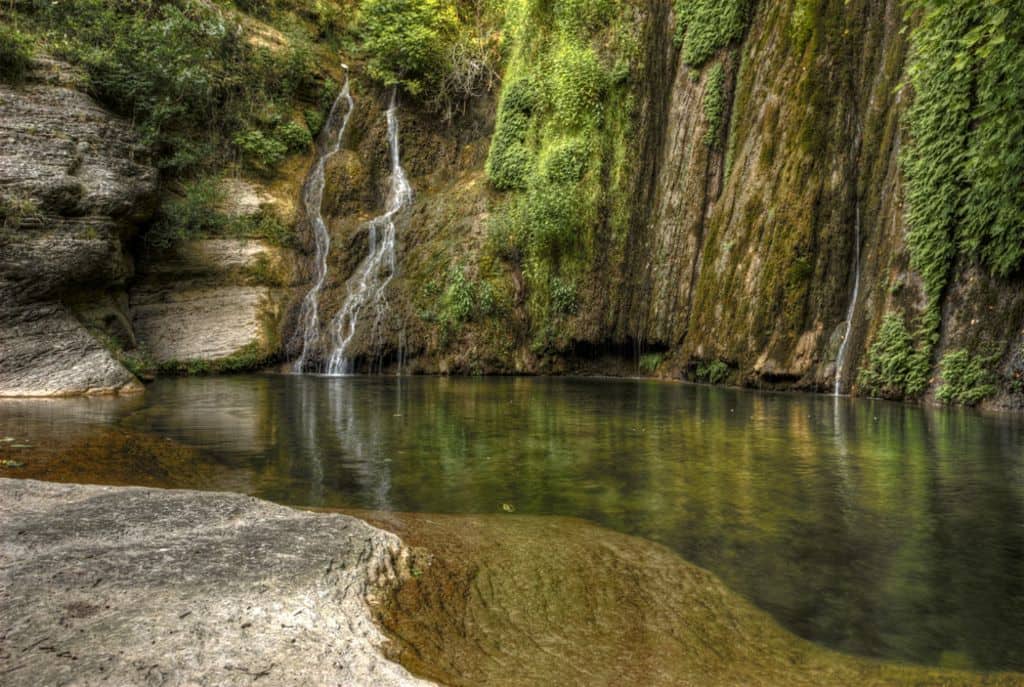
The Majella National Park is another unmissable event for nature lovers traveling to Abruzzo . The park, established between 1991 and 1995, extends between the provinces of Chieti, L'Aquila and Pescara and offers a vast range of attractions. From the scenic beauty of the Apennines, to the historical and archaeological ones, the park offers a vivid and deep cross-section of Abruzzo history and nature.

7. The abbey of San Giovanni in Venere: the triumph of Christianity
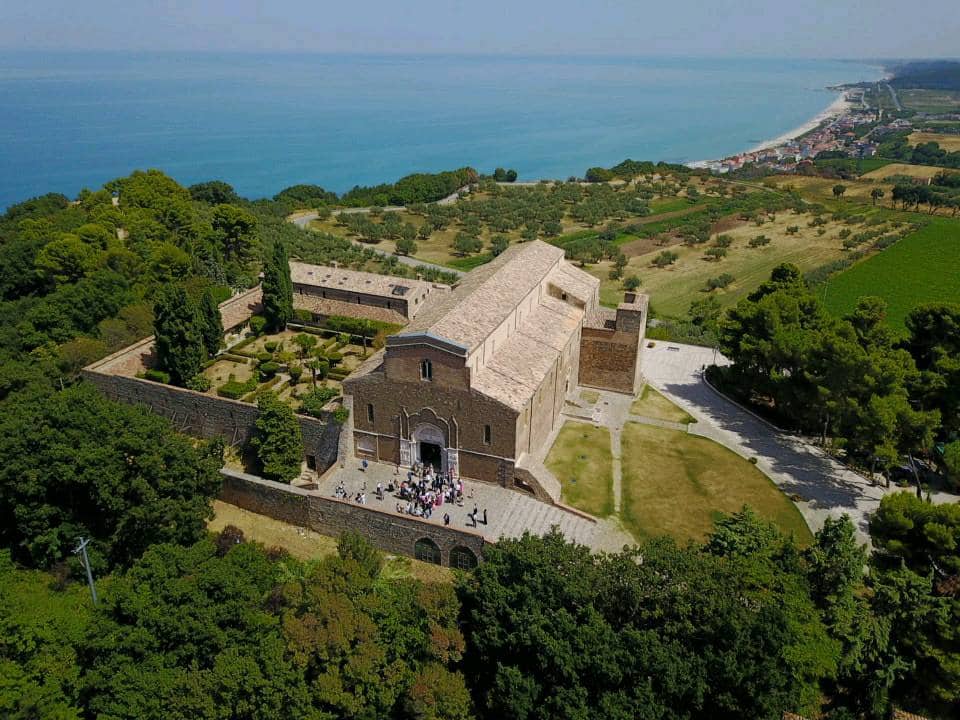
For lovers of art and monuments, the trip to Abruzzo will certainly have as its goal the Abbey of San Giovanni in Venere in Fossacesia, in the province of Chieti. The great monastic complex, which owes its name to a pre-existing pagan temple dedicated to Venus, has a rich and articulated construction history, from the interventions promoted by the hermit Martino in the 6th century, to those sponsored by the abbot Oderisio in the XII.
6. The National Park of Abruzzo, Lazio and Molise: respecting nature

The National Park of Abruzzo, Lazio and Molise , is one of the most important and ancient natural reserves of the Italian peninsula. Its history, in fact, begins way back in 1917, to reach our days. His mission? Preserve, enhance and promote the precious Abruzzo natural heritage. What are you waiting for then? Backpacker and packed lunch, and watch the Marsican bear!
5. The strength of the spirit: the hermitage of San Bartolomeo in Legio
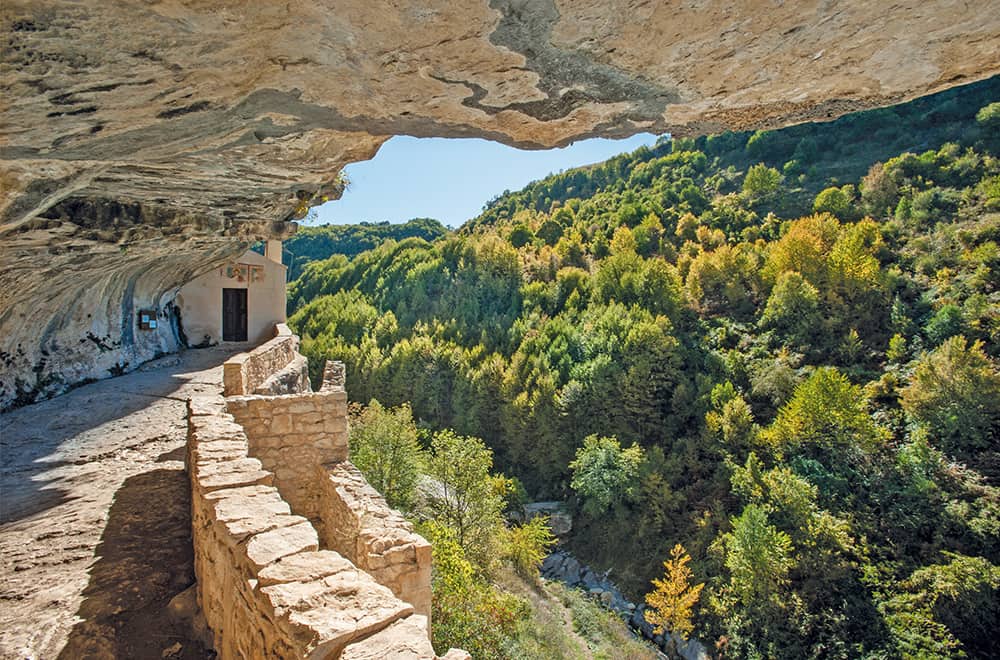
The hermitage of San Bartolomeo in Legio is one of the most evocative and mystical places in the Abruzzo region. The hermitage is located in the municipality of Roccamorice (Pescara) surrounded by the Maiella and Morrone woods. The building was built in the 13th century by Pietro da Morrone, the future Pope Celestino V, who lived there with some disciples between 1274 and 1276. Here you will deeply feel the strength of the spirit and faith...
4. The National Museum of Abruzzo: history of a region
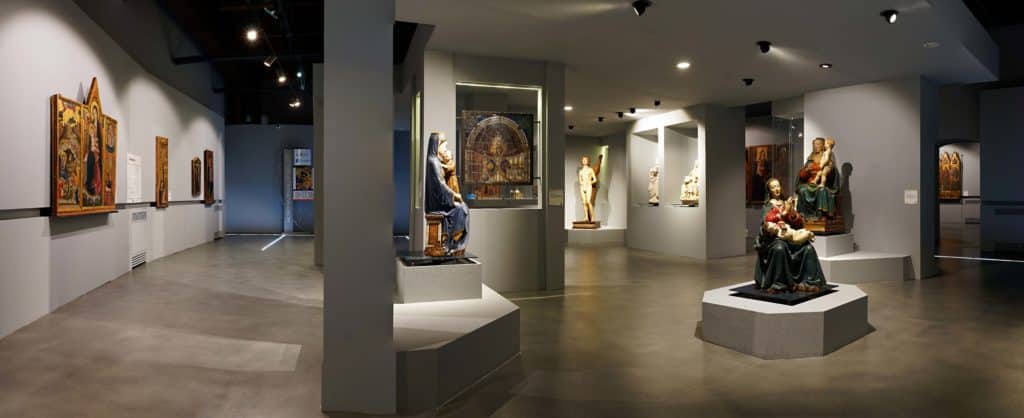
For those wishing to learn more about the history of the Abruzzo region, a must is a visit to the MuNDA, the National Museum of Abruzzo . The museum is now temporarily housed in the former slaughterhouse of Borgo Rivera, in the presence of the magniloquent Fontana delle 99 cannelle, waiting for the restoration of the original site to be completed: the 16th-century Castle of L'Aquila, nicknamed the Spanish Fort, where, in its 41 rooms, the story of an entire region was told.
3. In the bowels of Abruzzo: the Stiffe caves
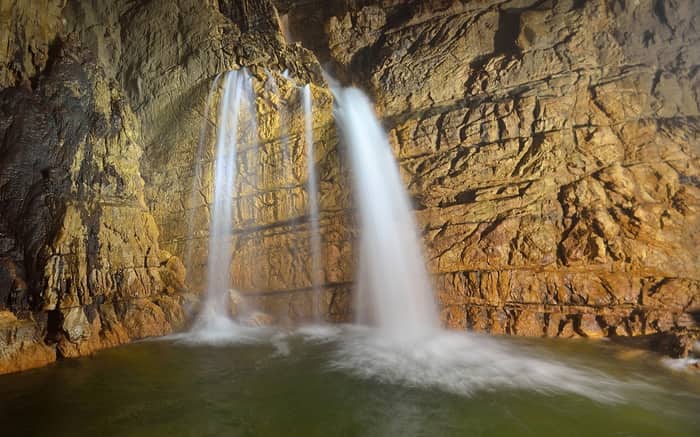
If you want to penetrate the deepest bowels of the Abruzzo region, to fully grasp its vital breath, you should definitely visit the Stiffe Caves (L'Aquila). Among the most important karst phenomena of the Peninsula, the Stiffe Caves are hundreds of thousands of years old, and have a depth of several hundred meters ... Arm yourself with compasses and courage and have a good trip!
2. The Calanchi di Atri Nature Reserve: the wounds of Abruzzo

Among the many wonders that Abruzzo offers us, among the most characteristic, is the Calanchi di Atri Nature Reserve , in the province of Teramo. The Calanques are a particular phenomenon of soil erosion, and appear as huge and deep furrows on the side of mountains and hills. But in spite of the arid conformation, the Calanques are rich in animal species and vegetation: badgers, porcupines, tamarisks, licorice, etc ...
1. The Heart of Abruzzo: Lake Scanno
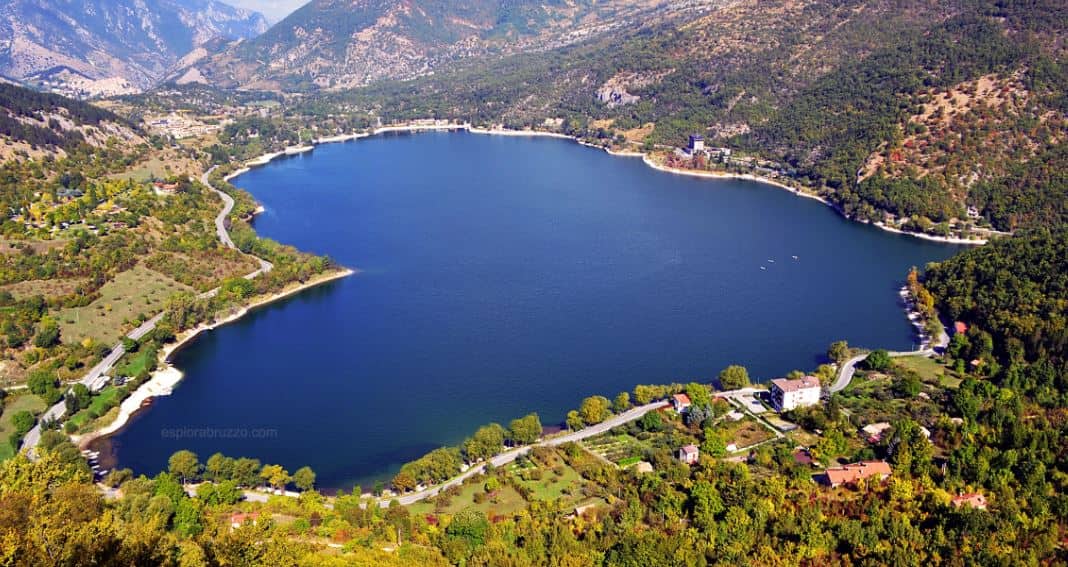
If you are in Abruzzo and you want to visit a fabulous place, your ideal stop is surely the lake of Scanno (L'Aquila), set between the Marsican mountains and the valley of the Sagittarius river. Here you will feel the divine presence of Nature like nowhere else, here you will find yourself, in contemplation of such wonders. And if you pay attention, you will see that the lake has the shape of a Heart ...

We recommend

- Hidden Gems
- Popular Classics
- Travel Tools
- Photography
- Vintage Pieces
- Digital Prints
Is Abruzzo Worth Visiting? Best Things to Do and See
- May 22, 2024
Situated in central Italy and on the opposite coast of Rome is the undiscovered region of Abruzzo. The region is sprawling with natural wonders, national parks, charming villages, an underrated gastronomy scene, and incredible beaches. What does it lack? An overwhelming scene of tourists, cheap souvenir shops, and overpriced slices of pizza.
With all it has to offer, Abruzzo just might be Italy’s best-kept secret . In this guide, discover the best things to do, places to visit and all the reasons why Abruzzo is 100% worth visiting.
Abruzzo is Authentic
It’s not overrun by tourists, abruzzo is affordable, it has everything you’d want in one region, national parks, the trabocchi coast, rocca calascio, medieval villages, abruzzesi food & wine, 1. hit the bike path along the adriatic coast, 2. dine at a trabucco for a unique seafood experience, 3. visit the bear and wolf wildlife sanctuaries, 4. tour the charming hilltop towns and villages of abruzzo, 5. swim in the sangro river, 6. spend the day at the beach, 7. explore the gran sasso and the maiella national park, 8. hike to rocca calascio, 9. ride the italian trans-siberian railway, 10. visit the capital of pasta, 11. book a wine tasting tour, by train and bus, guided tour, the best time to visit abruzzo, italy, final thoughts: is abruzzo worth visiting, abruzzo, italy travel resources.

❗️ This post was 100% written by a human author based on real-life experiences without the use of AI-generated content or images.
Reasons Why Abruzzo is Italy’s Best Kept Secret
Comparatively, Abruzzo is one of Italy’s least influenced regions by another culture or country. For example, the northern regions of Italy are heavily influenced from neighbouring countries such as Austria and Switzerland. In the south, Sicily was once ruled by the Arabs and remains of this time period still heavily linger among the island. Naturally, these types of fusions have impacted various Italian regions and are reflected in food, traditions, and even language.
Abruzzo is unique because it has for the most part been left untouched. Its culture is very much authentic to the quintessential Italian lifestyle that we as foreigners have heard so much about.

As an entire region, Abruzzo is still considered a hidden gem when it comes to places to visit in Italy. It is rare to visit a town, historical landmark or attraction in Abruzzo and find yourself among tons of other tourists, tour buses or crappy souvenirs being sold. Tourism in Abruzzo is not obnoxious . The integrity and experience of any place you’ll visit in the region is intact. This is something that definitely can’t be said for other popular places in Italy like Tuscany, Rome or Venice.
Of course, it is not a ghost town by any means. In the summer, many travellers begin to gather on the coastline. Still, the crowds aren’t unbearable and you will almost never sense that you are in the middle of a tourist trap.

The prices in Abruzzo are much lower than what you’d come across in popular tourist hot spots in Italy. It is not inflated to take into account mass tourism. Pricing for accommodation, groceries, and going out to eat are incredibly reasonable. Especially when compared to any region of Italy that’s north of Rome. If you’re looking to visit Italy on a budget, Abruzzo ranks as one of the top destinations in Italy where basic necessities cost the least. You can find a caffè (espresso) for €1 and place to stay for under €50/night.
Abruzzo is guaranteed to impress any type of traveler because it simply has everything . This is a bold statement but it’s true! Picturesque rolling hills filled with vineyards and farmland? Check. Epic mountain ranges and national parks ? Multiple. A long stretch of coastline with sandy beaches ? Yes!
One of Abruzzo’s most intriguing features is the number of fairytale-like hilltop towns you’ll come across without even trying. Abruzzo is severely underrated for its medieval ruins and well-preserved historic villages .
Let’s not forget about the foodies and wine lovers who will also easily fall in love with Abruzzo at first sight. Ever heard of Montepulciano d’Abruzzo and arrosticini ? Oh, you will now!
What more could you ask for from a trip to Italy?

What Is Abruzzo Known For?
There are a few places and symbols of Abruzzo that the region is most known for (both within Italy and worldwide). If you’re short on time or just want the overview, stop here for the best of the best.
The Abruzzo National Park is among the most well-preserved conservation and wildlife areas in Italy . It is home to various animal species including bears, wolves, foxes, deer and more. Outdoor lovers flock to the Abruzzo National Park for hiking, mountaineering, biking, and its ski resorts for winter sports.
Throughout Abruzzo, you’ll also find additional national parks including the Gran Sasso National Park, Maiella National Park, and the Sirente-Velino Regional Park. Abruzzo’s national parks are considered to be part of central Italy’s Apennine Mountains .
Frequently known as the “green lung of Europe,” Abruzzo is home to 75% of the living species found throughout Europe, all in one concentrated region. Nearly half of the entire region is dedicated to wildlife and nature reservation.
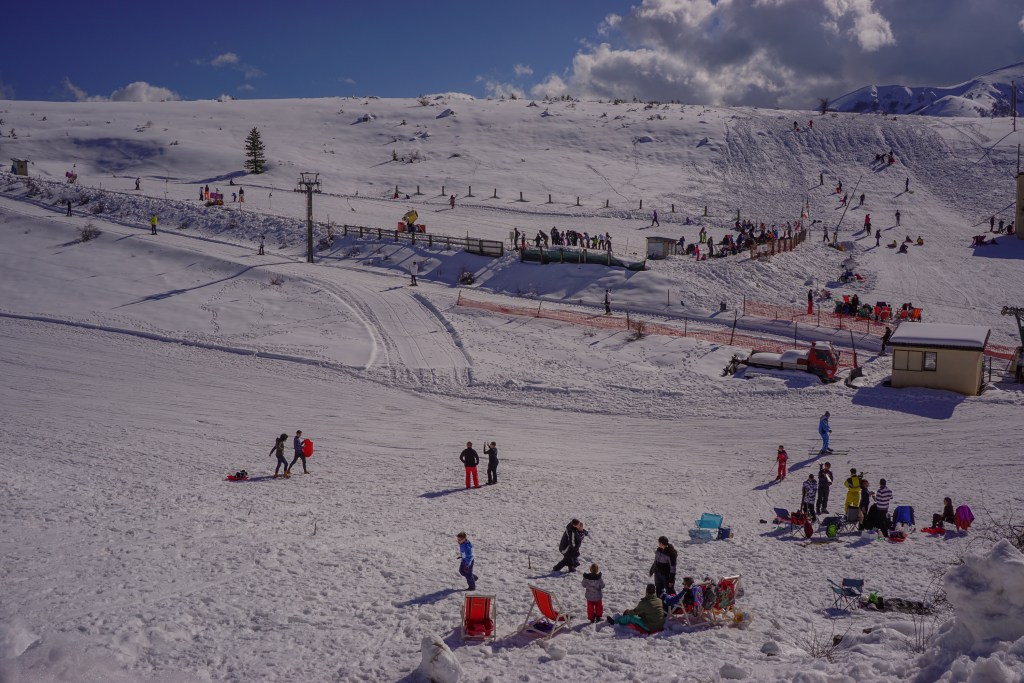
Alongside the Adriatic Sea, Abruzzo’s famous Trabocchi Coast extends 54 km (33 miles) long. This is where you’ll find the region’s best beaches. It is also renowned for the historic fishing structures (known as the trabucco ) which still stand today and define the coastline’s landscape. Many tourists zone in on the Trabocchi Coast as a unique dining destination. A handful of trabucco structures are now converted into incredible seafood restaurants which allow diners to enjoy a meal directly out on the water.
→ Read More: Best Beaches and Restaurants on the Trabocchi Coast ←

Each region of Italy has a symbol to its name and Rocca Calascio is definitely Abruzzo’s. At 1,500 meters above sea level , the castle is among the highest fortifications in Italy. More famously, it’s also been used as a film set in the movie Ladyhawke . The fortress is believed to have been constructed in the 10th century and overlooks into the distance of the region as well as the mountain peaks of the Gran Sasso. The Rocca Calascio has undoubtedly become the most picture perfect “must see” attraction in Abruzzo.
→ 🏰 Book a tour to Rocca Calascio ←
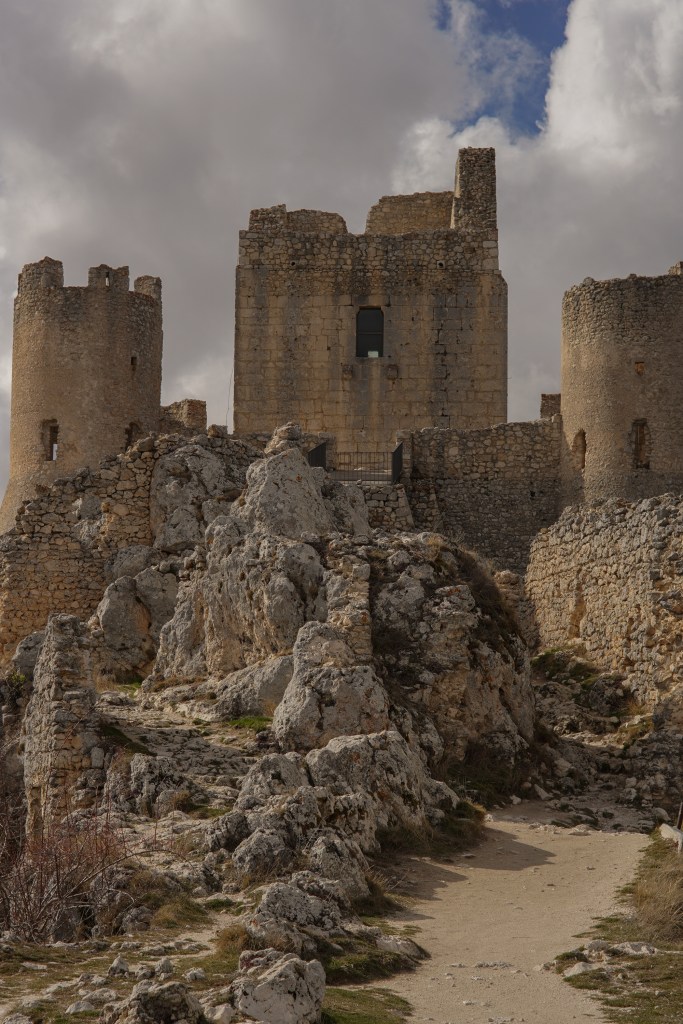
The large number of medieval villages ( borghi medievali in Italian) are a reason alone why Abruzzo is worth visiting. While tourists overrun the small streets of Tuscan towns, the historic communities in Abruzzo are just as impressive, ancient and picturesque. Best of all, they’re not touristy. Given the mountainous landscape of Abruzzo, a majority of the historic towns are also constructed on hilltops and cliffsides for that extra dramatic touch.
→ Read More: The Best Towns in Abruzzo, Italy ←
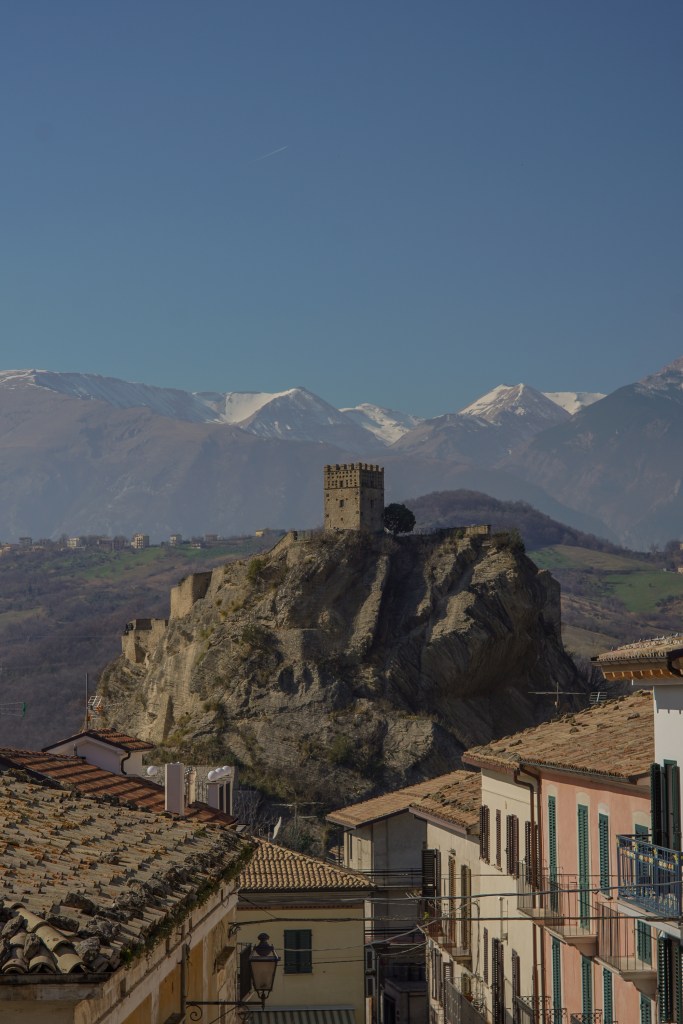
Like each region in Italy, Abruzzo has a staple cuisine and distinct products that are worth traveling to Abruzzo for. First, the type of wine for which Abruzzo is famous is Montepulciano d’Abruzzo . It is primarily defined by its very dark red, almost burgundy, color and hints of fruit. The beloved Montepulciano d’Abruzzo is among the top red wines consumed in all of Italy.
You’ll find a handful of unique dishes for which Abruzzo is known, but without a doubt, arrosticini is the most favored. Derived from centuries-old tradition, arrosticini is more than just skewered lamb meat that you won’t be able to get enough of. It is sold fresh at nearly every butcher shop and frequently found at town events or cooked at home for parties.
Abruzzo is the birthplace of Maccheroni alla Chitarra (also known as spaghetti alla chitarra), a type of pasta shape. However, this pasta goes beyond just the shape and is more about how it’s made. This pasta is produced on a specific tool with a component that resembles the strings of a guitar , hence the name of the pasta.
→ 🍝 Book a home cooking demonstration of Abruzzesi cuisine ←
11 Best Things to Do in Abruzzo, Italy
Known as the Via Verde della Costa dei Trabocchi , this epic bike path stretches almost 50 km along the Adriatic Coast . It is among the most beautiful scenic bike paths in all of Italy and runs in parallel with the best beaches in Abruzzo. There are plans to continue the extension of the Via Verde Bike Path but for now, you can seamlessly ride from Ortona to San Salvo Marina.

The Trabocchi Coast received its name thanks to the historic fishing huts that are posted up and down the coast of Abruzzo. A trabucco is built out of wood with various pulley systems that were originally intended for fishing , a method that is centuries old. They are located offshore, directly within the sea water and constructed to withstand even the harshest of storms .
Today, a majority of the trabucco sites have been converted into seafood restaurants and allow diners to have one of the most unique and immersive gastronomy experiences. This memorable novelty is among the most popular reasons why Abruzzo is worth visiting.

Endangered bears and wolves are protected within the Abruzzo National Park. Although wild sightings are increasingly rare throughout the region, there are places in Abruzzo where you can intentionally go to see wildlife. The Area Faunistica dell’Orso Bruno is a conservation area for bears that have been rescued and are now kept in semi-free captivity. The preservation area is open to the public with guided tours and located at the base of the Maiella Mountain.
Near Lake Barrea is where a similar wildlife conservation is located, but for wolves. The Area Faunistica del Lupo includes a museum in addition to a vast outdoor area where you can witness the wolves in their natural habitat.
For any wildlife enthusiasts or travelers with kids, these are a must-do activity while visiting Abruzzo.

Towns and villages with origins as early as the 11th century are not difficult to find in the region of Abruzzo. In fact, these historic communities are one of the most intriguing reasons that make visiting Abruzzo worth it. Visiting the old towns of Abruzzo is the closest experience to stepping back in time because much of the exterior infrastructure in town centres has not changed .
Not only are the comunes full of history, a great majority of them are interestingly constructed in the most striking locations . You’ll see countless villages built on top of hillsides, rocky mountains and into cliffs.

The Sangro River is among the longest rivers in the Abruzzo region and drains into the Adriatic Sea. Historically, it is also famous for being a battleground during World War II, defined by a prominent clash between the British Army and German forces established along the Gustav Line.
Today, the river is drama-free and one of the most beautiful places to cool off during the summer. The Sangro River runs through many towns within Abruzzo, but one of the most breathtaking natural pools is located in the town of Villa Santa Maria . If you’re looking to take a break from the beach or go where the locals do, this is a must-see spot in Abruzzo.

Among the most renowned reasons why Abruzzo is worth visiting is the Trabocchi Coast and its gorgeous beaches . With a combination of hidden coves, pebble beaches, and even sandy beaches, there is no shortage of places to spend the day under the sun. If you’re the type who enjoys a good beach club, you’ll find an abundance of them in one of Abruzzo’s more popular beach towns like Fossacesia Marina and Marina di Vasto .
The beaches in Abruzzo are also commonly blocked by wave barriers made out of stones. This means the water is kept relatively calm and shallow, ideal for families with young children .

The Gran Sasso National Park is enormous, covering three different provinces of the Abruzzo region and is the third largest national park in Italy . The highest peak among the Gran Sasso massif is the Corno Grande , which sits just over 2,900 meters above sea level and is the tallest summit in the Apennines Mountains. Within the heart of the national park is Campo Imperatore , an incredibly beautiful plateau that reaches 1,900 meters.
Largely located in the Chieti province, the Maiella National Park is comprised of peaks, more than half of which are over 2,000 meters tall. It is a paradise for hikers , trail runners, and horseback riding with almost 130 various trailheads . Over 2,200 different types of flora and fauna grow within the Maiella National Park.

As one of the most celebrated symbols of the region, Abruzzo’s Rocca Calascio has been deemed so picturesque that it’s even featured as a film setting in a handful of productions. The medieval fortress is located about the nearly abandoned village of Calascio and is known to have origins from the 10th century . Reaching the fortress requires a short trek because the path to the top is only accessible on foot.
Rocca Calascio is free to visit and offers panoramic views of Abruzzo’s valleys and the surrounding mountain peaks of the Gran Sasso. Without question, it’s one of the most picture-perfect sceneries in the entire country.

Beginning in the town of Sulmona, travelers can jump on a historic train from the 1930s and ride through the scenic landscape of the Maiella National Park. The dreamy ride takes you through mountains, tunnels, around lakes and through forests.
The Italian Trans-Siberian Railway journey first made its debut in the late 1800s but is not a novelty experience for riders looking to step back in time. It is one of the highest train rides in Italy , reaching an altitude of 1,269 meters at the Pescocostanzo station.
The historic train is one of the most unique reasons that make Abruzzo worth visiting. To view the upcoming dates of the Italian Trans-Siberian Railway, head here .

The unassuming town of Fara San Martino is often known as the Capital of Pasta. Nestled at the base of the Maiella Mountain, the town is home to one of the most prominent pasta factories which produces world-known brands like De Cecco and Delverde .
Both of these pasta companies share the same secret when it comes to their production – the water. The town of Fara San Martino is located on the bed of the Sorgenti del Fiume Verde (green river) which is a source of spring water. This particular water is used in the manufacturing process at the nearby pasta factories, which clearly, makes a world of difference!

Abruzzo’s native wine is Montepulciano d’Abruzzo, which is typically grown in the vineyards along the Adriatic Sea. It is described by its bold and deep red color , dry and non-acidic taste, and high alcoholic flavor. Although it is one of the most common red wines consumed throughout Italy , it is not a fancy type of wine, which rightly reflects the Abruzzo region in its personality. It’s a dependable wine, wholesome, modest, and well-rounded.
If you’re a wine lover, make sure to book a wine tasting and vineyard tour at one of the top rated wineries in Abruzzo .
- Vini Naviganti
- Dora Sarchese
- Tenuta Ferrante
- Azienda Agricola La Vinarte
- Cantina Orsogna
- Il Feuduccio
- Contesa Azienda Agricola
How to Get to Abruzzo Italy
Although the main city of the Abruzzo region is L’Aquila, the only international airport is in the city of Pescara . The Abruzzo Airport serves flights to Abruzzo from major cities within Europe and can be super cost effective with low budget airlines like Wizz Air and Vueling. However, flying to the Abruzzo Airport is unfortunately only beneficial during the summer and flights are often not even available during the winter.
→ ✈️ Find flights to Pescara Airport ←
Alternatively, you can much more easily find flights to Rome or Naples in order to reach Abruzzo. Rome and Naples both have larger international airports which serve direct flights from outside Europe, like the U.S.
L’Aquila and the western side of Abruzzo is easily accessed from Rome or even Naples by train. The capital of L’Aquila can be reached by railway in less than two hours from Rome . From Naples, there is a direct train ride to Isernia (Molise region) that only takes 1.5 hours.
→ 🚉 Find routes and train tickets to L’Aquila from Rome ←
On the east side of Abruzzo, the train tracks run along the entirety of the Adriatic coastline. This means, reaching Abruzzo from northern or southern Italy is straightforward. You can even catch a direct train to Venice from Pescara!
Bus transportation throughout the region is widely taken advantage of by locals who are simply commuting on a regular basis. For long-haul bus rides that get you to Abruzzo from other parts of Italy, search for routes through Flixbus .
Getting Around Abruzzo
Getting to Abruzzo by train or bus is the easy part. Once you are there, then comes the challenge of efficiently getting around the region, which frankly, isn’t easy with the use of public transportation. To make Abruzzo worth visiting, it’s recommended you tour the region by car . Driving around Abruzzo will ensure you’re able to visit the region’s national parks, outdoor attractions, hidden gems, and remote villages. Abruzzo is unfortunately not at the point where traveling around without a car is convenient (unless you’re open to a lot of bicycling).
→ 🚙 Find an inexpensive rental car for your Abruzzo trip ←

Abruzzo’s popularity is growing, and there are now guided tours you can book which include transportation. This is a great solution for those who are perhaps visiting Rome but want to include a bit of Abruzzo into their existing itinerary. For anyone who is particularly set on not renting a car, a guided tour is the best possible solution for exploring Abruzzo with the least amount of effort .
→ 🚐 Book a multi-day tour of Abruzzo from Rome ←
A large majority of the Abruzzo region is located at high altitude. During the winter season, it can get very cold and snowfall is typical . Unless you are specifically interested in winter sports and visiting Abruzzo’s ski resorts , winter in Abruzzo can be limited for travel.
To take advantage of nature at its fullest, Abruzzo is most worth visiting during the summer season. Temperatures are not uncomfortably high which makes spending time outdoors in the sun very pleasant . The summer months are the ideal time to visit Abruzzo’s national parks, the beaches, lakes and hiking trails.
For experiencing art, culture, and festivals, it’s advised to visit Abruzzo in the month of August . It is guaranteed that you’ll find an event to attend each day of the week, located in a different town or village throughout the region. Unquestionably, August in Abruzzo is the time of year that the region feels the most alive .
→ ☀️ Search for summer flights to Abruzzo Airport ←

Whether it’s your first time in Italy or your tenth, the answer is YES, Abruzzo is worth a visit. These are the top reasons why you should begin planning your trip to Abruzzo.
- The region is comprised of everything that makes for the perfect travel destination . Mountains, beaches, medieval villages, vineyards and coastal cities – all in one place!
- The Gran Sasso National Park, Abruzzo National Park, and Maiella National Park are among the most beautiful in Italy and favored among outdoor lovers .
- Montepulciano d’Abruzzo wine and arrosticini are alone some of the top reasons why Abruzzo is worth visiting.
- Comparatively, Abruzzo is not a tourist destination , which makes it feel enormously more genuine and enjoyable .
- Hotels, vacation rentals, groceries, and restaurant prices are affordable and make Abruzzo a fantastic choice for anyone looking to visit Italy on a budget.
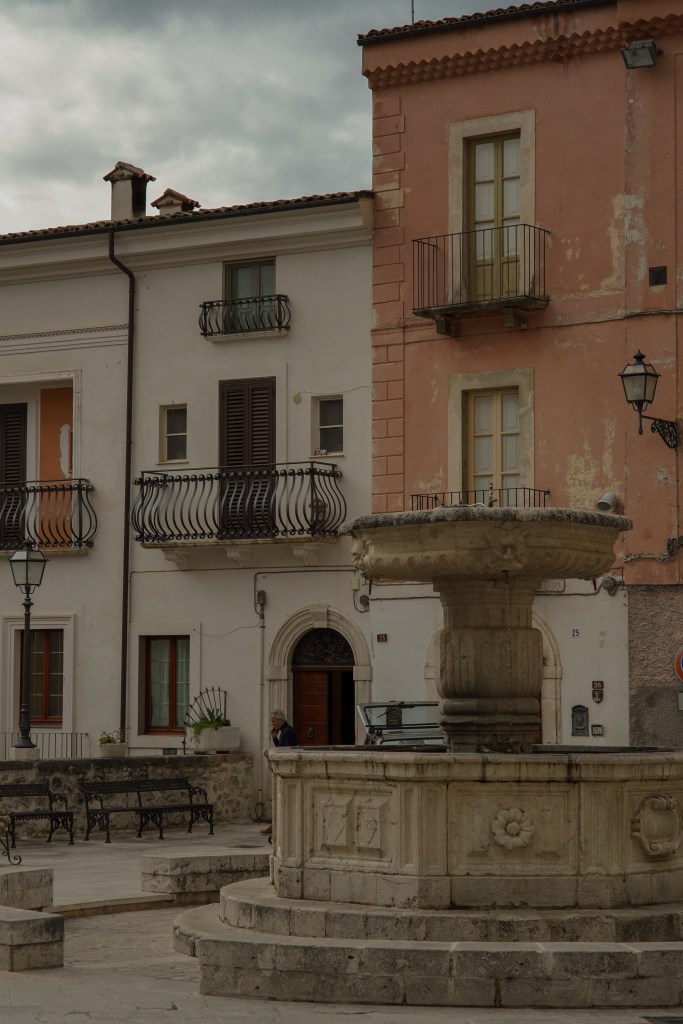
Affiliate Disclaimer: Please note that some links found in our posts are affiliate links. Should you choose to purchase through these links, we may receive a small commission at no extra cost to you.
Share this:
2 thoughts on “is abruzzo worth visiting best things to do and see”.
Pingback: Rocca Calascio - Visiting The Most Beautiful Castle in Abruzzo
Pingback: How to Get to the Abruzzo Region in Italy - Adventures of Ace
Leave a Reply Cancel reply
Discover more from adventures of ace.
Subscribe now to keep reading and get access to the full archive.
Type your email…
Continue reading

Touropia Travel
Discover the World
12 Best Places to Visit in Abruzzo, Italy
By Jamie Gambetta · Last updated on May 4, 2024
Unassuming, unheralded, or underrated. However you see it, Abruzzo is a beautiful and historic playground that you can discover as the world ventures elsewhere.
Its proximity to Rome makes travel easy, without overwhelming the trio of national parks, alpine villages, and coastal hideaways. The nature within Abruzzo makes it a haven for hikers and explorers, plus skiers when the temperature drops.
The mountains which are so stunning were seen as natural fortresses for the region’s towns. These villages and cities tucked away along mountain ranges, have connections to pre-Roman times. Their culture, craftsmanship, and recipes survive as the generations pass.
As travelers venture further north in Abruzzo, Italy, or to the western coast, take time to explore a place as raw and wild as any in Italy.
12. Civitella del Tronto
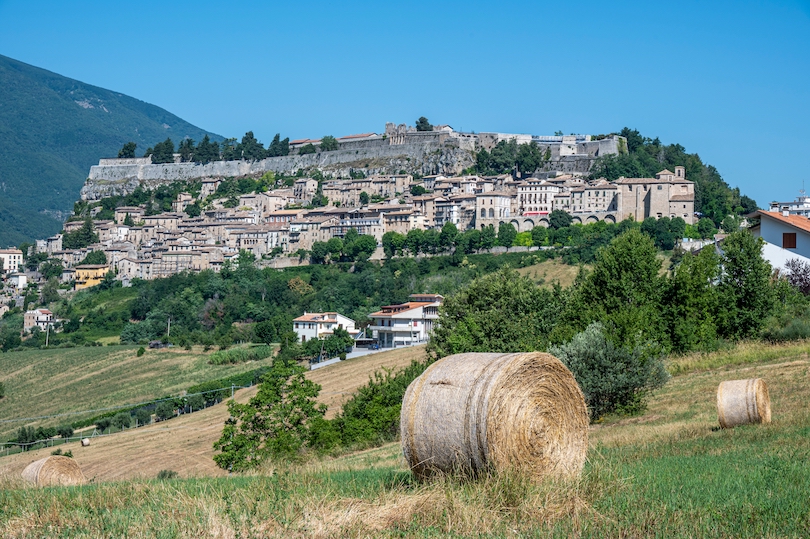
Home to the highest fortress in Italy, Civitella del Tronto is a trip back in time. In the 1860s, the fortress helped the city become the last bastion of resistance against Victor Emmanuel’s plans to unify Italy.
Much of Civitella del Tronto is encased in the Bourbon Fortezza, whose origins can be traced to the 11th century. Its almost 700 years of defending the town allowed its cobbled streets to blossom with sightly buildings, delicious cuisine, and gravity-defying stairways.
One of these stairways rises steeply out of the valley to the fortress entrance. Soon you’ll pass the old Governor’s house and the Church of San Giacomo where the parapets guide you around the fort’s entirety.
11. Sulmona
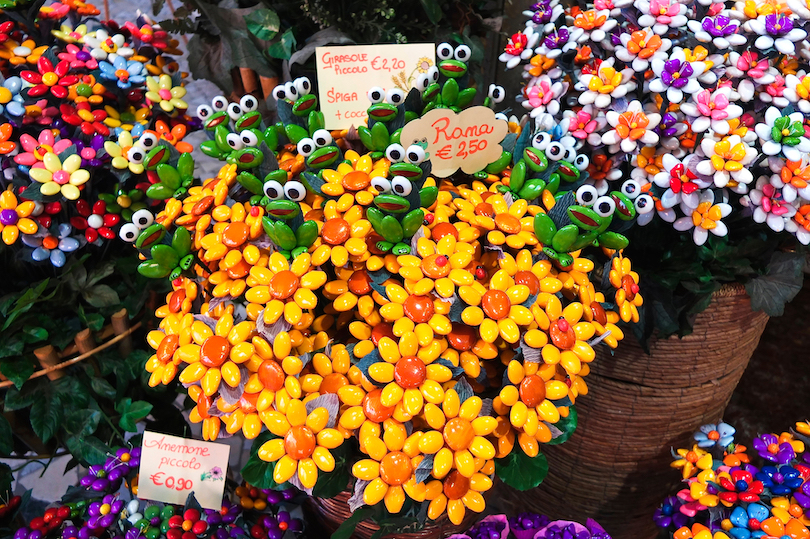
With a history that began with the ancient Italic people of Peligni, Sulmona has been around for thousands of years. Once it fell under Roman possession, it became known as the birthplace of Ovid, a 1st-century Roman poet.
Fast forward to now and Sulmona is synonymous with confetti. No, not the kind that blasts into the sky. Instead, Italian confetti is a collection of colorful, flavored almonds.
Designed in all sorts of artistic fashions, including colorful bouquets, the streets of Sulmona are laden with confetti. While you wouldn’t want to eat those, head into the town’s many shops to find delicious confetti featuring fruit flavors, Nutella, hazelnut, and even tiramisu.
10. Trabocchi Coast
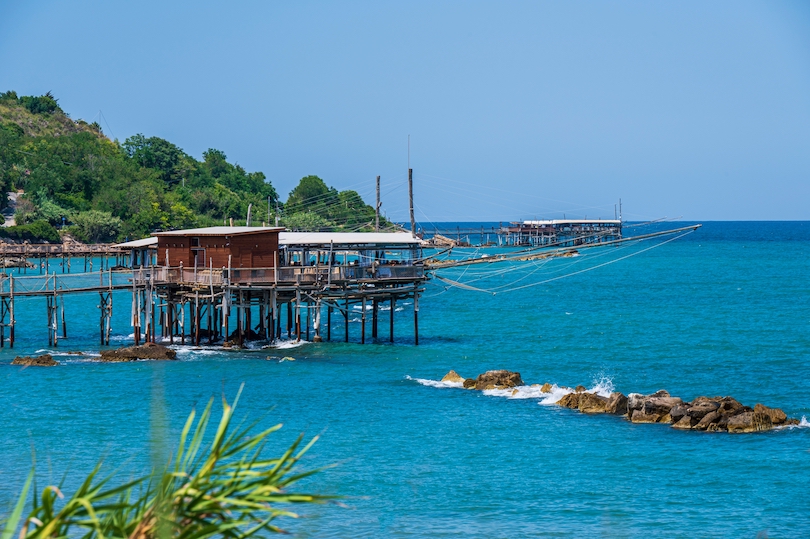
Connecting Ortona to San Salvo, the Trabocchi Coast, is beautiful and fascinating. The name derives from the centuries-old fishing net designs that are spread along the coasts 70 kilometers (43 miles).
These “nets” are in face lengthy wooden platforms that run into the Adriatic. From the end of them, fishermen could essentially deep sea fish. As old as many are, they stand before you, some with their own restaurants.
A memorable coastal drive takes you from town to town with an endless blue sea to enjoy along the way. Other highlights include the Abbazia of San Giovanni. The gothic abbey is set upon an ancient Roman temple looking out to the sea.
9. Majella National Park
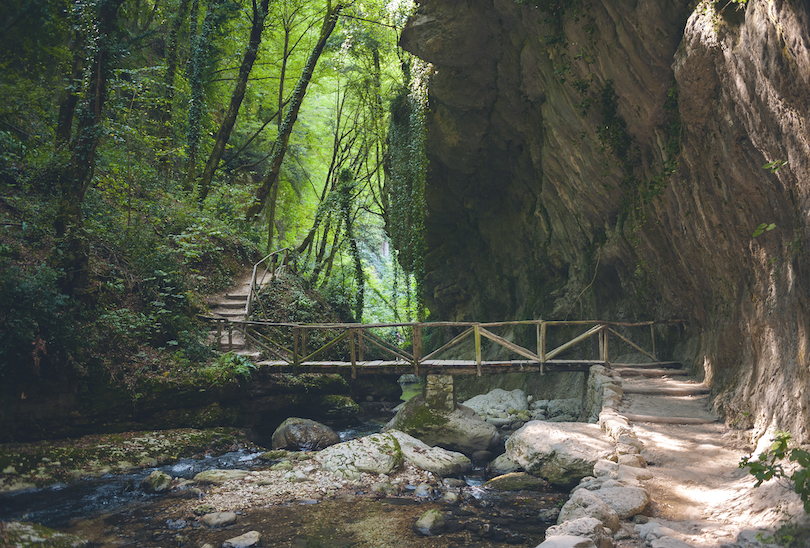
One of three national parks in the Abruzzo region, Majella National Park, features spectacular Apennine mountain scenery. Among the high peaks are jaw-dropping valleys where vast canyons have carved their way ruggedly through the otherwise pristine landscape.
Under the delightful Italian sun, lather on the sunblock and make your way down the park’s miles of hiking trails. The extensive system guides you to postcard-worthy views, with each step bringing the chance to discover Majella’s rich natural diversity.
One trek to add to your Majella National Park itinerary is the jaunt to the Gorges of Fara San Martino. A brief hike takes you to a natural rock entrance where a vast valley spreads out before you and you’ll uncover the ruins of the historic Benedictine Abbey of St. Martin. If you’re still energetic, continue on to Mount Amaro, the park’s highest peak.
Aside from nature, this national park is packed with ancient culture and archaeology. Aside from the abbey, there are roughly 40 hermitages that were first developed to house monks.
8. Roccascalegna
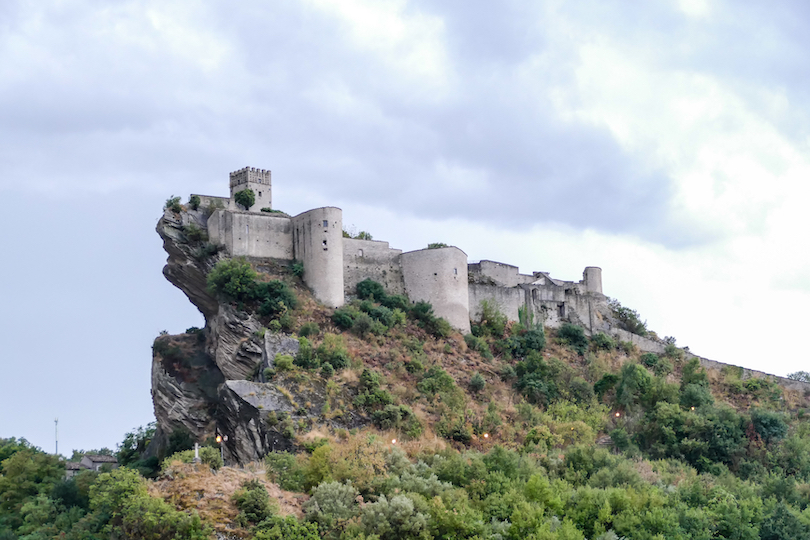
A 16th-century castle in Roccascalegna will redefine what you can expect from medieval architecture. Rising out of an angled limestone cliff, the Castle of Roccascalegna sits in an impressively precarious location.
Lying in the valley beneath is a small village whose origins can be traced to the 7th-century. Designed to protect it, the aptly named Castle in the Sky looked over the village and helped slow the rise of invaders. The very folks that led people to think of Roccascalegna as Death Valley.
The castle’s most famous inhabitant was the Crow Baron, Corvo de Corvis. He was an evil ruler who forced high taxes and made all new brides spend their first night of marriage with him. A fact that would eventually lead to his downfall, with a newlywed plunging a knife into his heart.
Today, you can visit the castle’s keep, courtyard, and prison.
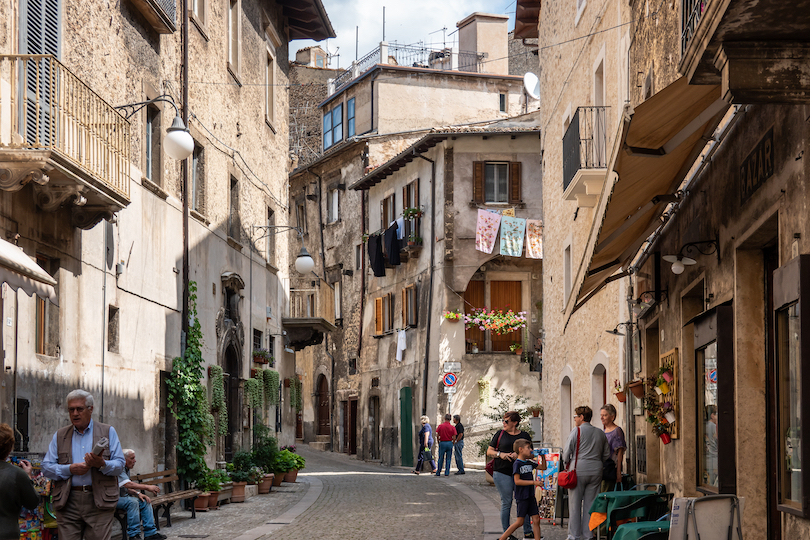
The alpine town of Scanno is known as the Pearl of Abruzzo. In many ways, it combines the best parts of the region into one, featuring medieval architecture, surrounded by mountains and fresh alpine air.
In the 15th century, thanks to agriculture and a talented community, Scanno was a wealthy town. Today, its buildings tell the tales of the era’s past but the old skills and craftsmanship survive.
As you explore the ancient streets of Scanno, shops selling handmade ricami (lace work), orafa (goldsmiths), and high-end ceramics are direct descendants of a time when affluent goods were in high demand.
The maze of streets makes Scanno a great place to get lost. But be sure to find time to see the Sarracco Fountain and the Church of Santa Maria Dalla Valle.
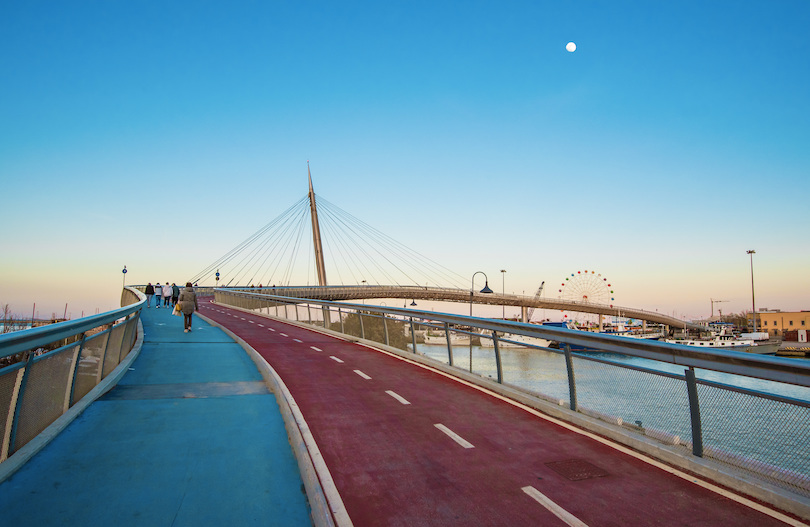
L’Aquila may be the capital, but Pescara is the biggest city in Abruzzo. Famous for its golden coast, line with marinas that jut out into the Adriatic, Pescara is the place to develop a terrible tan line.
Compared to other parts of Abruzzo, Pescara is refreshingly modern. Its now lively waterfront owes its recent developments to its predecessors being heavily bombed during the Second World War.
Boasting just shy of 20 kilometers (12 miles) of pristine waterfront, Pescara is a buzz of action during the summer months. The beaches are lined with umbrellas, locals reading in the shade, and hordes of swimmers making use of the refreshing Adriatic that is just as easy on the eyes.
As the sun falls behind Pescara, restaurants quickly fill out and the DJ beats flow out of nearby nightclubs into the happening streets.
5. Roccaraso Ski Area
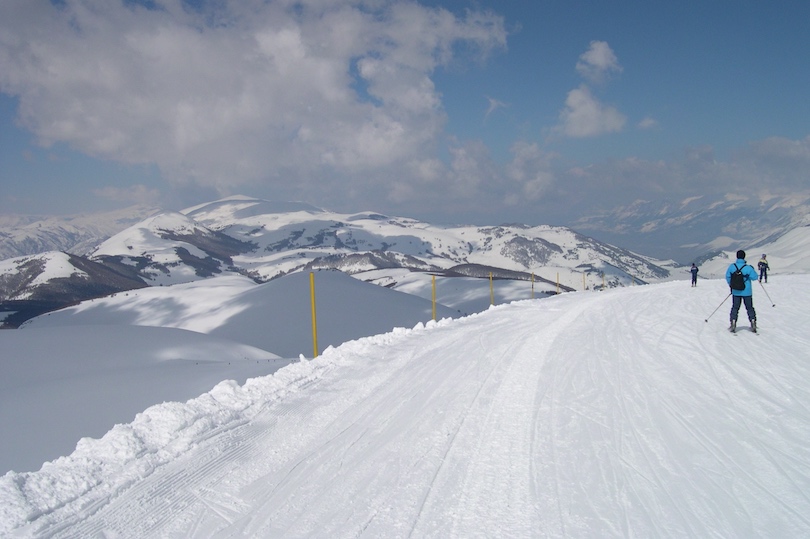
Come winter, do as the locals do, and visit the Roccaraso Ski Area. While international tourists venture further north to France and Switzerland, Roccaraso is home to a ski culture that is pure Italian.
With little outside interests (aside from those in Rome and Naples), the ski area has developed its own way of doing things. Once we are sure you’ll appreciate it. Roccaraso is the most popular of Abruzzo’s budding slopes. It covers all abilities, from beginners to experts with over 1000 meters (3,200 ft) of vertical.
In town, you’ll find a relaxing cafe culture, bars for après-ski, and shops for when the slopes aren’t calling out. In addition, Roccaraso connects with other ski resorts, vastly increasing the amount of downhill and cross-country trails all on the same pass.
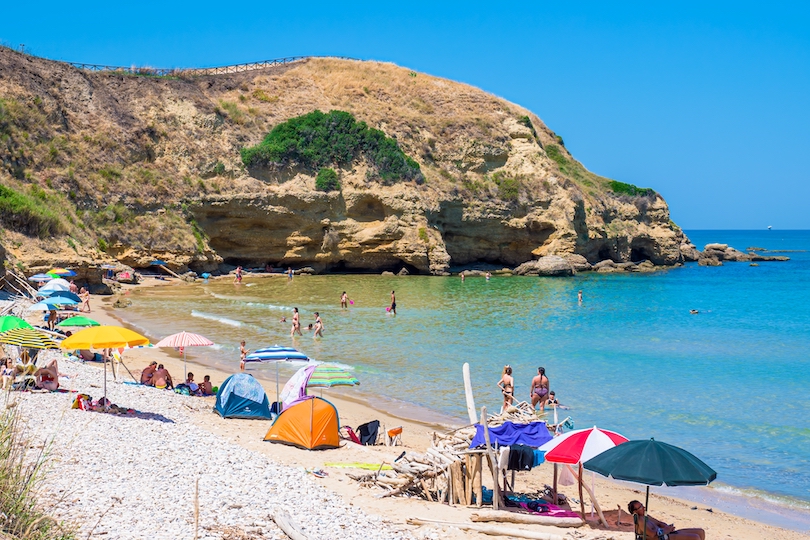
Overlooking the vast and scenic Adriatic Sea, Vasto is as charming as it is unassuming. Its eye-catching coastal location makes it a great beach getaway along Italy’s east coast. While its architecture adds plenty of medieval brilliance to the mix.
From the Adriatic Sea, the coastal hills rise quickly towards the center of Vasto, which sits elegantly along the peak. With great views around every corner, Vasta is a joy to discover on foot. Fortress walls blend in with spots of gorgeous green vegetation and narrow streets guide you by 500-year-old buildings.
At the heart of Vasta’s history is the stunning Caldoresco Castle and the San Guiseppe Cathedral. Their delightful Romanesque facades will stop you in your tracks. After a day of walking, stop by Piazzo Rossetti for an afternoon espresso surrounded by a quaint local atmosphere.
Beyond the center of town, Vasto offers lovely beaches. Pick between the resort-laden Vasta Marino or go off-trail and seek out the crystalline waters of San Nicola.
3. Gran Sasso National Park
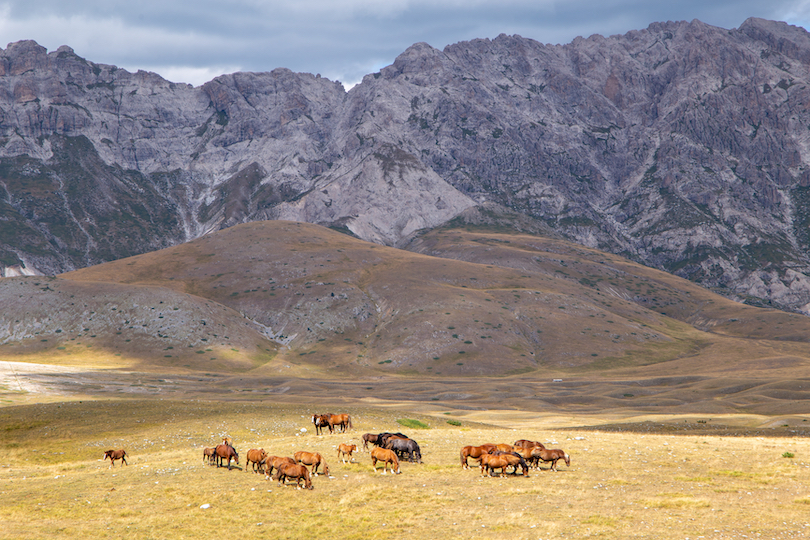
Epitomizing the beauty and personality of Abruzzo, Gran Sasso National Park is spectacular yet unheralded. As one of the biggest national parks in Italy, Gran Sasso boasts astonishing scenery. Its towering mountains have taken inspiration from the Swiss Alps, and its alpine lake offers a hint of Patagonia.
Home to three mountain ranges, there’s plenty of exploration for travelers to embark on. Hiking, mountaineering, and rock climbing are the main sports when the sun is high and warm. Come winter, snow falls heavy and climbing shoes are switched for snowshoes and cross-country skis.
One hike not to miss takes you from the valley floor to the above treeline and into the alpine tundra. Clouds waft by and after a hearty 8-hour trek, your feet bring you to the park’s tallest peak. At almost 3,000 meters (9840 ft), the peak’s 360-degree views will be a memory for years to come.
2. L’Aquila
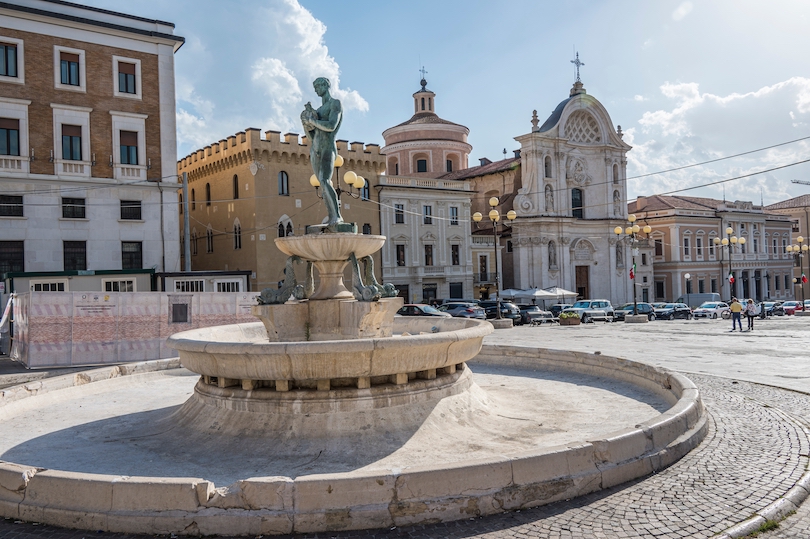
As the capital of Abruzzo, there’s no missing L’Aquila. The town’s center is surrounded by medieval fortress walls while the broader landscape has a different kind of encasing. Just beyond L’Aquila are four towering peaks.
Set in a beautiful yet small valley, L’Aquila is laden with history, gorgeous architecture, cultural highlights, and amazing food. The town’s well-kept buildings feature Renaissance and Baroque-style facades, and behind each door lies something more captivating.
L’Aquila’s rich heritage has survived into the modern era. Conservatories, symphonies, churches, and historic academies peel back the curtain on life here, long before the 21st century. A highlight is the National Museum of Abruzzo. Housed in the 16th-century San Giorgio castle, the museum focuses on pre-Roman era artifacts, Renaissance works, and historic religious art.
1. Abruzzo National Park
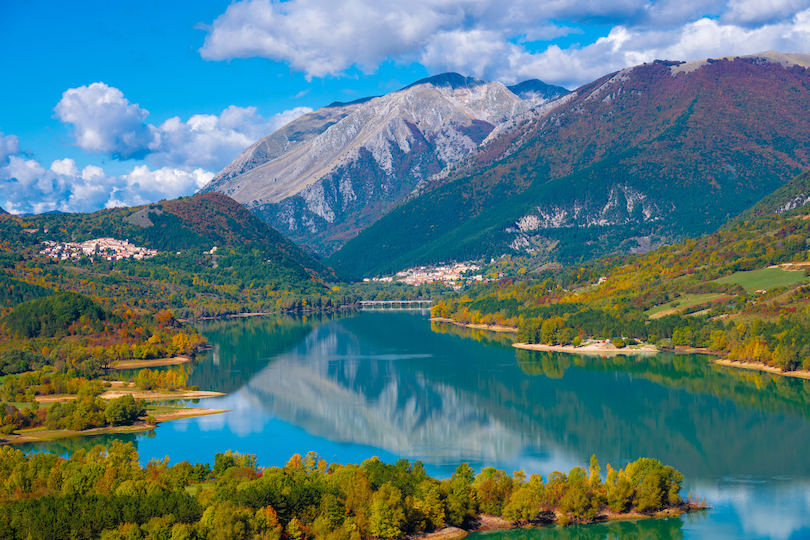
Wild animals, epic hikes, and ancient history come to the fore in Abruzzo National Park. In Italy’s most protected region, this national park is the centerpiece. Just two hours from Rome, you’ll feel a world away, in a raw paradise where bears and wolves linger.
Spotting either is not an easy task. But in such a wild and lively landscape, evidence of both lies around every corner. Thus, Abruzzo National Park is a perpetually unfolding journey. One you can embark on along the park’s well-maintained trail system.
Guided or on your own, seek out the hundreds of miles of trails that lead you into a wilderness where evidence of human interference becomes almost null. The primeval forest full of beech tree words hides various ecosystems and mountain huts fit snugly within the surrounding landscapes.
The park’s huts are the perfect spot to kick back after a day of exploration. Hosts cook up a feast of Abruzzo cuisine, which is notoriously hearty.
Map of Places to Visit in Abruzzo, Italy
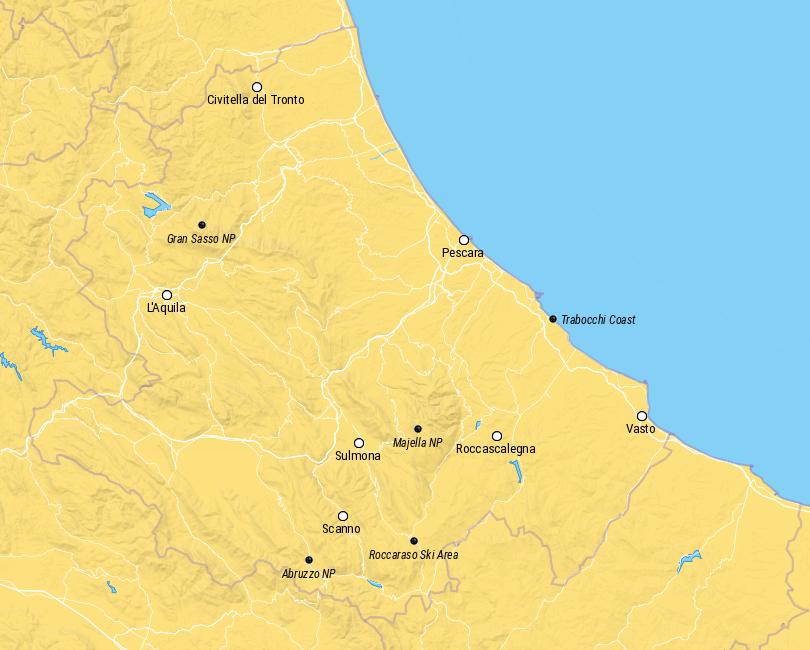
Share this post:
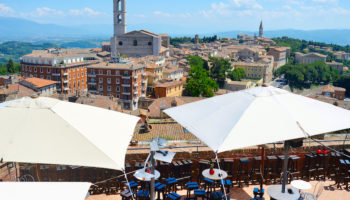
10 Most Underrated Destinations in Italy
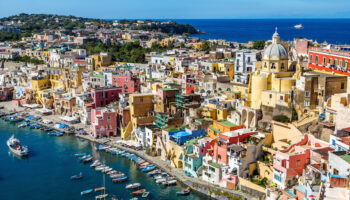
10 Most Beautiful Italian Islands
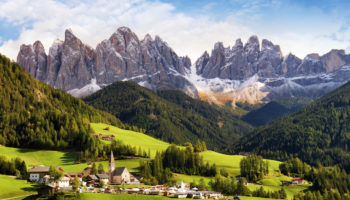
20 Most Beautiful Regions of Italy
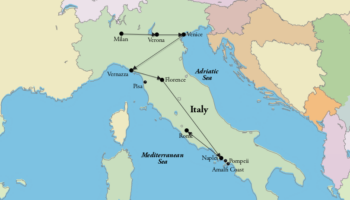
How to Spend 2 Weeks in Italy: DIY Itinerary
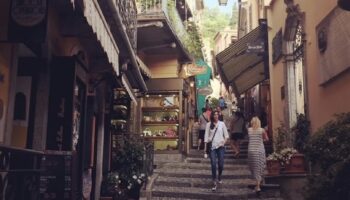
Visiting Lake Como: Villas, Vistas and Tranquil Bliss
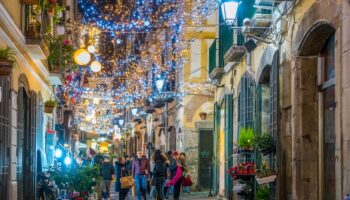
17 Best Things to do in Salerno, Italy
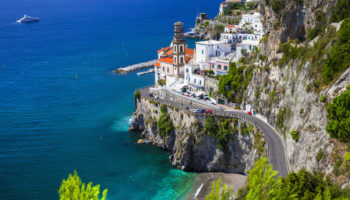
8 Best Day Trips from Sorrento
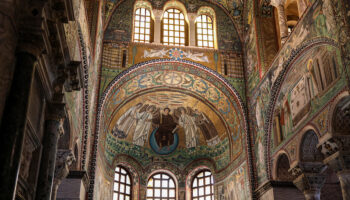
17 Best Things to do in Ravenna, Italy
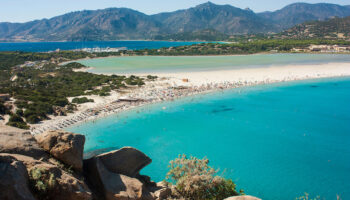
14 Best Things to do in Sardinia, Italy
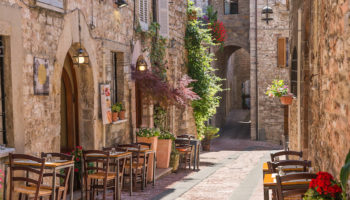
12 Best Places to Visit in Umbria, Italy
Reader interactions, leave a reply cancel reply.
Your email address will not be published. Required fields are marked *
This site uses Akismet to reduce spam. Learn how your comment data is processed .

Vacation Countdown App

The Charming Villages of Abruzzo: The Best-Kept Secrets of Italy
We’re reader-supported. When you buy through links on our site, we may earn an affiliate commission.
Central Italy’s best-kept secret, Abruzzo, is seeping with authenticity and old-world charm. Just two hours outside of Rome, and largely unknown to international travelers, this crown jewel of Italy is filled with nostalgic Italian villages that have remained preserved throughout time and offers visitors everything that they are looking for in an authentic Italian experience.
The region’s cuisine, landscape, heritage, and wines depict one of the last old-world destinations in Italy. Abruzzo’s remarkable variety of flavors and aromas, reaped from the produce of its uncontaminated mountainous areas, offer a diverse cuisine that appeals to the most discriminating taste buds.
Destination Abruzzo in Central Italy
This stunning destination welcomes travelers with rich, wild landscapes filled with olive grove draped hillsides, rolling acres of vineyards, the vast white sandy beaches of the Adriatic Coast, and awe-inspiring peaks of the Apennine Mountains. Prepare to uncover these breathtaking landscapes of some of the most charming and idyllic villages of Abruzzo, Italy , where nature converges with a rich history, ancient traditions, and unparalleled flavors.

Central Italy is where Abruzzo is located, making it the perfect home base to explore other regions of this picturesque country. The region of Abruzzo has a medieval atmosphere and covers a vast area with plenty to see and do. You can explore medieval villages perched atop rocky cliffs, drive through the pristine countryside filled with vineyards and olive groves, or enjoy the stunning Adriatic Sea. The top of Abruzzo is dominated by the jagged peaks of the Apennines, which are perfect for hiking or skiing, while its coastline offers miles of beautiful beaches and seaside villages to visit. Travelers will always find what to do in Abruzzo no matter how many days they spend exploring this wonderful region.
Wander through the narrow alleyways of one of Abruzzo’s most beautiful hilltop towns. With an expansive view of the Adriatic Sea, the town brims with medieval architectural wonders that date back to 15th century Italy.
Take in the views where the crystal blue waterways of the Adriatic meet warm golden beaches with a backdrop of medieval structures, art, and cultural centers, and even a palace. Visit the Palazzo d’Avalos palace, which houses a quartet of museums including the Museo Civico Archaeologica. After looking at ancient bronzes and glasswork as well as 19th-century art, make sure to immerse yourself in the beauty of the nearby Neapolitan-style garden.
Descend on the charming town of Sulmona located at the foot of the majestic Majella National Park. This lovely village is one of the most famous of Abruzzo’s villages, made popular for its sugary coated almonds, commonly known as “confetti.” The quaint streets bustle with vendors who boast vibrant bouquets and artfully sweet arrangements available in a wide array of succulent flavors. Learn all about the traditions of throwing confetti at weddings that were born here. Despite a devastating earthquake that hit the historic village in 1706, you’ll find medieval architecture and a spirit throughout the village that has stood the test of time.

Visit Abruzzi’s capital of vibrant ceramics known as “majolica,” which were collected by the elite of Europe for hundreds of years. Select some magnificent pottery and bring part of nostalgic Italy back home. Sealed with clear colored glazes, brightly colored hand-painted adornments, and a signature color palette, these works of art are certain to get your attention. Travelers can even take a cultural tour of the area and learn how to make their very own “Majolica” masterpiece.
Enter into the pages of a fairy tale when you arrive in the scenic, magical hill town of Scanno. Take a canoe adventure through Scanno lake, which formed when a landslide from the mountainside blocked the natural course of the river than ran through it. This enchanting medieval town is known for its magnificent crystal blue lake and its precarious alleyways, baroque architecture, and its costumed inhabitants. Take home a special memento of an intricately laced pattern embroidered on pillows made within the village borders.

Sneak into the tiny village of Villalago and discover the sacred, small church, The Hermitage of San Domenico. Unlock access from the outside, stroll past the altar and climb a few steps and discover the hidden sanctuary. Find your zen and connect with the world at this peaceful spot surrounded by serene views of the bluest waters and the pure beauty of nature.
Roccascalegna
Take a trip back in time to the 16th century with an excursion to the medieval village of Roccascalegna. Seemingly frozen in time, this medieval castle stands elevated on a gravity-defying ledge of limestone. This is only one of the more than fifty awe-inspiring castles that will amaze you on your journey through Abruzzo.

Civitella del Tronto
Travel to the site of the largest Italian military fortress and experience the wildly breathtaking panoramic views that peer over three majestic mountain ranges, a charming village, and the vast blue reachings of the Adriatic Sea. Explore the architecture and venture down the hillside and stroll through the streets and winding alleyways of the beautiful village that it oversees.
Fara San Martino
Discover pasta in Italy’s kingdom of pasta, Fara San Martino! Look no further for extraordinary pasta and Italian cuisine. This producer of the highest quality pasta brands prides itself on its distinctive flavors and ancient pasta-making techniques. Gaze at the wide, beautiful valley of the Verde River, whose waters combine with other special ingredients to make the world-famous pasta. Enjoy your dinner with wine from the region.
Explore the village’s stunning Canyon of St. Spirito. Once inside, stretch your arms out and touch two distinct mountains as you hike to the 13th-century Monastery of St. Martino in Valle along beautiful terrain.
Santo Stefano di Sessanio
The mountain village of Santo Stefano di Sessanio is one of the most charming in all of Abruzzo. This medieval village, located in the province of L’Aquila at 1250 meters above sea level, is within the Gran Sasso and Monti della Laga national park. The village has been abandoned for many years, but recent restoration efforts have brought new life to the town. There are now several restored buildings, including a hotel and vacation homes. The village hosts a festival each year in September celebrating its delicious lentils. If you’re looking for a charming and off-the-beaten-path village to visit in Italy, Santo Stefano di Sessanio is a great choice.
The Climate in Abruzzo – What is the best time to visit?
The climate in Abruzzo is largely Mediterranean, which means that summers are very hot and winters are mild. Spring and autumn are the most popular times to visit an Italian village in this region because the temperatures are comfortable enough for long walks along the beach, checking out a hiking trail through the mountains, or enjoying some Italian dishes or lunch with wine outside. The average high temperature in July is around 86 degrees Fahrenheit, while the average low in January is around 38 degrees Fahrenheit. Although it does not rain as much as other regions in Italy, October and November can be very wet months.
There is no perfect time to visit Abruzzo because every season offers something different and beautiful to see and do. Travelers who want to enjoy the best of what the region has to offer should plan their vacation during either spring or fall when there are mild temperatures and less crowds. Summer is an ideal time for those who want to be surrounded by the warm sea and sunshine of Italy’s coasts.
Accommodations in Abruzzo
There are plenty of unique accommodations in this central Italian region. You can stay in beach hotels, farmhouses, cute villas, or even a 17th-century castle.
Abruzzo offers a wide range of accommodations to fit any budget and preference. Whether you want to enjoy a luxurious stay in the Italian countryside, or live like a local and spend their nights tucked away in an agriturismo (Italian for “farm”), you can find it all in Abruzzo. With so many options available, it can be difficult to choose where to stay in Abruzzo, but no matter what travelers decide, they’re sure to have an amazing and unique experience.
Finding the best places to stay in Abruzzo is easy with this form because you can sort through hundreds of properties and choose the ideal one for your needs and budget.

Getting Around in Abruzzo, Italy
One of the best ways to get around Abruzzo is by car . The roads are winding and the scenery is gorgeous, so it’s the perfect place to take a leisurely drive. If you’re not comfortable driving in Italy, there are also plenty of buses and trains that will take you around the region.
If you’re looking for a more adventurous way to travel, Abruzzo is a great place to go hiking or mountain biking. There are trails for all levels of hikers, and the views from the top of the mountains are absolutely incredible.
Books about Abruzzo
If you’re looking for a deeper understanding of Abruzzo, its history, and its culture, there are several books that we can recommend.

Counting Castles in Abruzzo: A Journey Through the Land of Enchantment is an excellent resource that covers everything from the region’s history, art, and architecture to its food and wine.

Walking in Abruzzo is a must-have guidebook for trekking in Abruzzo, especially in the Maiella and Gran Sasso national parks as well as Sirente-Velino regional park.

Italy Abruzzo (Bradt Travel Guide) is the best English-language guidebook to this beautiful and increasingly favored part of Italy. It covers all of the major destinations in Abruzzo, from the bustling city of L’Aquila to the stunning medieval villages in the National Park of Gran Sasso e Monti della Laga. The guidebook also includes information on where to eat, what to see and do, access details for how to get around the region, as well as background on Abruzzo’s biodiversity, culture, history, traditions, cuisine, literature, and landscape.
Similar Posts

10 Unique Sights to Visit in Tulum, Mexico
With its turquoise beaches and lovely cenotes, Tulum, Mexico, is a must-visit destination for solo travelers, nature and beach lovers.

Best Islands in Croatia – Four Islands for Travel Lovers
Discover the best places to visit in Croatia. Here are our suggestions of some of the most beautiful islands, beaches and towns that you’ll find on your travels around this gorgeous country.

22 Best Things To Do in Vienna, Austria
Looking to plan your visit to Vienna? Check out this list of the best things to do in the city, from visiting iconic landmarks to exploring nature parks and indulging in delicious pastry.

10 Best Restaurants in Tulum, Mexico
Read this article to learn why these are the best restaurants in Tulum, Quintana Roo, Mexico, why we like them and where you can find them.

A Complete Guide to Solo Travel Costa Rica
If you’ve always wanted to travel on your own, here’s a complete guide for planning a solo trip and having an amazing time in Costa Rica.

How to Enjoy an Exotic Vacation Without Going into Debt
5 tips on how to save money while planning a debt-free exotic vacation. Learn how to find discounts, hire travel agents, shop out of season & more.

Climate - Abruzzo (Italy)

Plains and hills
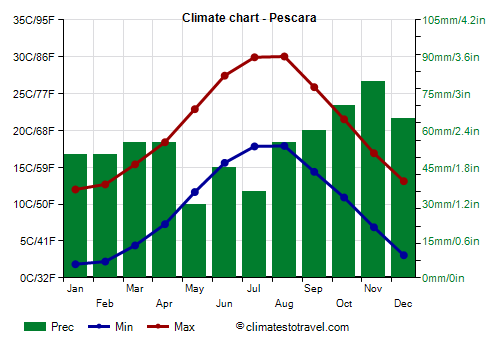
10 THINGS YOU WANT TO KNOW WHEN TRAVELLING TO ABRUZZO
Abruzzo in October: Travel Tips, Weather, Food & Wine
Abruzzo in October – At a Glance
- What’s the weather like?
- What to pack ? What to wear in Abruzzo during October ?
- What food is in season in Abruzzo in October ?
- What are some things to do in October in Abruzzo ?
- What’s happening in Abruzzo during October ?
- What wineries to visit during the Grape Harvest in Abruzzo?
- Is October a good time to visit Abruzzo ?
- Agriturismo where you can stay
Abruzzo in October – What to Expect?
October is a calm season in Abruzzo. It signals the start of the autumn and offers vibrant colors, panoramic views, and villages where you can experience local life and the seasons’ grape and olive harvest. It’s a peaceful and relaxing time to discover the authenticity of the region and avoid any bustle of high-season tourism. To us, October as well as September, are the best months to travel to the Abruzzo region and you will discover why…
Is Abruzzo crowded in October?
As mentioned, October is a quiet month, especially at the seaside where you can still enjoy pleasant temperatures (more info below). Although we avoid swimming at this time of the year, there can still be some occasion to sunbathe and take a little color. In Abruzzo, in October it is easy to find great accommodations at affordable prices. Although you may find some seaside establishments closed, you can still find superb accommodation and usually 30 – 50% cheaper than August and July. In addition, the hinterland is very quiet and you can feel as though you have the small villages all to yourself to explore.
Weather in Abruzzo Italy in October
Expect the temperature to range from 69F (21C) during the day on the coastline and 51F (11C) during the night in the hinterland.
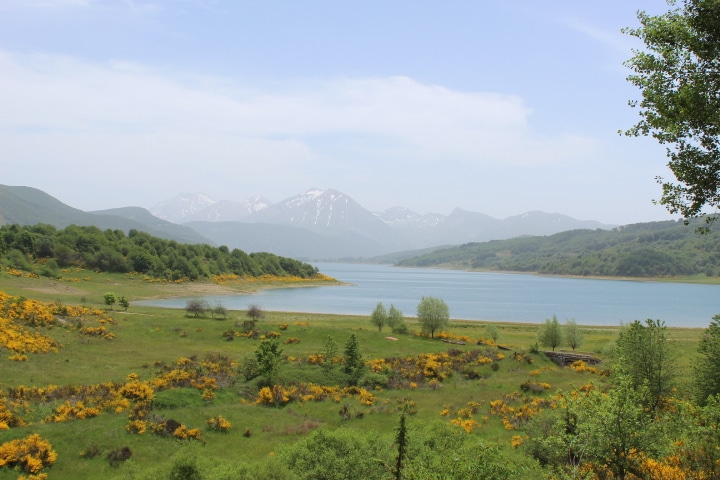
Given its contrasting geography, Abruzzo has two distinct climates, one being in the mountains villages between 500-700 meters (1640-2296), and the other along the coastline. October is a perfect month to visit wineries, olive mills, embark on some great cooking classes, discover the medieval villages and marvel over Autumn’s rich colors.
What to pack for Abruzzo in October?
Be prepared to carry heavier clothing as the weather can be unpredictable. Always carry a rain/wind jacket, hiking shoes, and suitable trekking gear, as the region offers many activities and areas to explore.
What to Wear in Abruzzo in October?
For the beach and coastline .
Although October can still be sunny, it is not a month for the full-blown beach activities. You can walk along the beach, maybe take a little sun on warmer days, but often expect wind and waves – great if you like surfing or kitesurfing!
For the countryside & hills
I would suggest wearing a sweater, a light jacket and some sneakers/trekking shoes for a comfortable walk in the vineyards during the wine-grape harvest.
For the mountain
Be sure to bring along good trekking shoes, a backpack, a sweater, a wind/rain-proof jacket and layers to keep you dry and warm. If you decide to hike, bring along mountain-sport clothing, along with your standard essentials like hat, small binoculars (if you have any) to spot falcons, eagles and other animals such as bears, wolves and other various wildlife you might encounter in the three National Parks of Abruzzo.
Prices in Abruzzo in October
October in Italy is the low season and Abruzzo will not disappoint! Generally speaking, if you dine out or stay in hotels, you won’t end up paying a fortune compared to staying in other parts of Italy. Rest assured in Abruzzo you will still get an authentic Italian experience through wine, food, culture, art, and nature. So expect normal prices during October!
Foods in Season in Abruzzo in October
Fruit, vegetables & nuts.
In October it is a good opportunity to buy and sample fresh, in-season Abruzzo-grown organic fruits and vegetables such as grapes, pears, apples, chestnuts, walnuts, hazelnuts, ‘peperoncini’ chilies, broccoli, cauliflowers, aubergines, spinach, pumpkins, carrots and leeks.
There are varied chestnut forests in Abruzzo, especially on the mountainside. For those lucky enough to know the free public spots, you can grab the first fruits. You’ll know them by their covered spiky shell, which at the beginning of October, will begins to change color then fall from the tree.
Best to taste them hot roasted over a flame on a cool autumn evening.
Olives – Olive Harvest
The olive picking season in Italy is limited to a few weeks between the end of September and beginning of October, each year. It is a bit uncertain when the harvest will start, so it’s hard to make plans. In Abruzzo, we are lucky as with both mountains and seaside, our olive harvest lasts longer and the olives in the mountains tend to ripen later than on the coast.
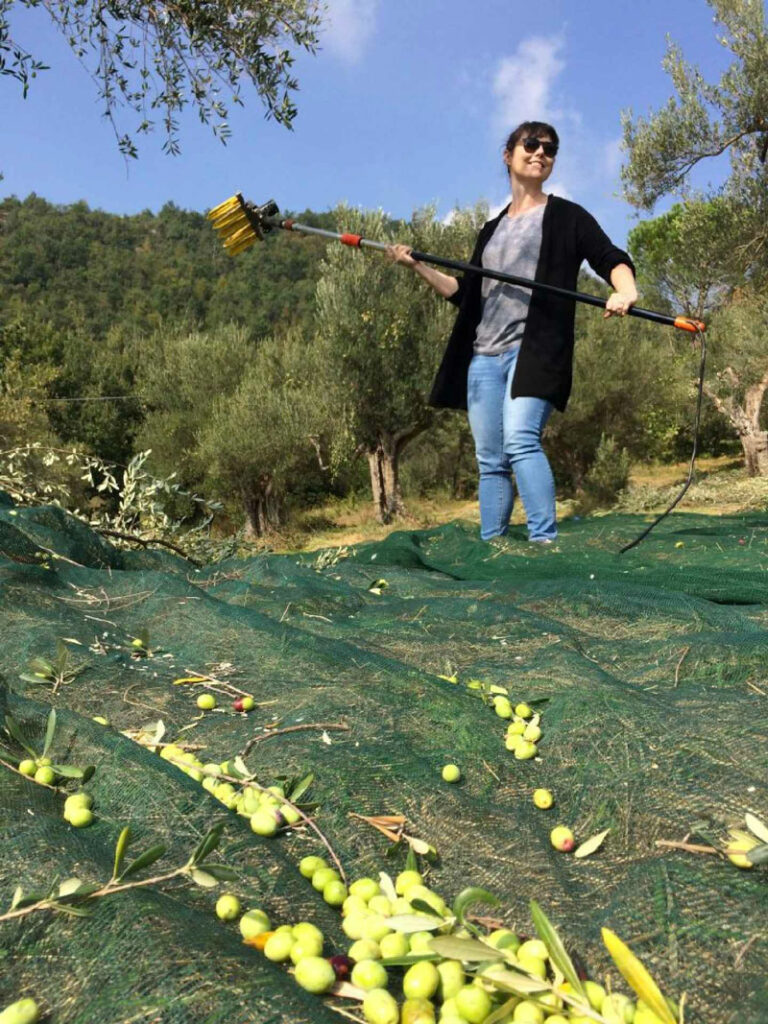
Why don’t you join the locals in an olive harvest experience ? If you’re curious to know more about Extra Virgin Olive oil, you should read this helpful guide 25 important things you need to know about olive oil .
Did you know that Abruzzo produces one of the best varieties of saffron in the world? It’s true! Even the world’s best chefs source Abruzzo saffron. Abruzzesi’s saffron dishes range from the classic risotto to specialty cuisine with mutton, desserts, and liquors too.
T he DOP (Protected designation of Origin) certified saffron from Navelli, is considered the best saffron in the world. You can join us to harvest ‘the world’s most expensive spice’, but only between October and November. If you are in Abruzzo and would like to join us, drop us a line .
Vendemmia in Abruzzo
September is the official month when the Vendemmia starts, however, in some places high up on the hills and mountains you are still able to find wineries harvesting the grapes up to the first two weeks in October. Have a look in the events section below for the latest update on wineries that encourage participation during the harvest.
Thanks to its vast parks and nature, Abruzzo sprouts a variety of wild animals. October is the season to find wild game on menus, especially the ‘cinghiale’ wild boar, as well as (but less commonly) venison, hare and pheasant.
Porcini & Wild Mushroom
October, depending on the season, is THE month for picking and eating wild mushrooms. Although we recommend not picking wild mushrooms by yourself, but rather rely on a local expert.
You would also need a license and in some cases a special permit to partake. Picking wild mushrooms requires a lot of walking up and down steep mountain terrain, which can be challenging, so we organize this kind of experience upon request for small groups. If you would like to eat fresh mushroom, then our top recommendation for the best restaurant in Abruzzo is Ristorante Da Enrico in Rocche di Civitella, a small town in the province of Teramo. Here Chef Enrico exercises his passion and specializes only in mushrooms! You will have ample dishes to choose from, including bounteous preparations like pickled, fried, raw, grilled, roasted, stuffed, and soups, all guaranteed to satisfy!
Truffles in Abruzzo in October
On the 15th of October the truffle season opens again with the ‘uncinato’ and white truffles.
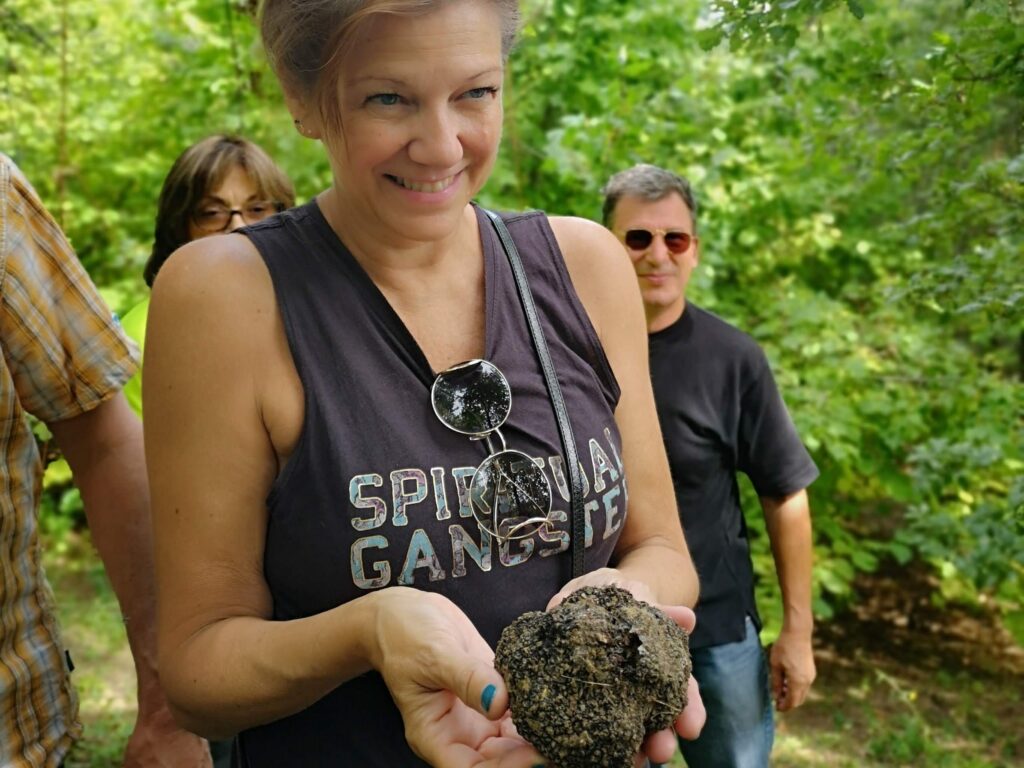
If you wish to experience the mysterious hunt, join a truffle expert on the ultimate truffle hunting experience in Abruzzo. If you’re curious about truffle, you can read the ultimate guide for truffles in Italy.
Traditional Dishes from Abruzzo to try in October
There are so many different products and delicious meals to try in Abruzzo in October. Some of them are:
- ‘Scrippelle’, ‘crepes’ or ‘crespelle mbusse’ – Crepes filled with parmesan and wet in hot chicken broth. This is one of the signature dishes of our Nonna Amina.
- Pasta e Ceci – a traditional Italian dish with chickpeas and very popular in Abruzzo especially when made with ‘tagliolini’ or ‘sagne’ pasta. Discover Nonna’s Chickpeas recipe !
- ‘Formaggio Fritto’ – this tasty fried cheese, is the most common antipasto in Abruzzo. You too can try this recipe at home. Trust us, it isn’t fatty as it sounds! It’s actually very light compared to other fried dishes in Europe.
The Best Traditional Dishes from Abruzzo
There are some further ‘must-trys’ which can be enjoyed all year round:
- ‘Arrosticini’ (pictured above), Abruzzo’s tender, char-grilled mutton and/or lamb skewers
- ‘Porchetta’ (pictured above), the region’s famous slow-roasted suckling pig is available in every town in Abruzzo, especially during the farmers’ market days. You can enjoy it inside a crunchy panino (always ask for the ‘crosta’ crust) and it’s best paired with Gassosa (sparkling lemon soda) from Campli .
- ‘Chitarra con pallottine’ – Abruzzo’s national dish, handmade thin squared spaghetti. Believe it or not, made with a guitar-like instrument! Join Nonna & Marino in their kitchen to make this traditional pasta from Abruzzo.
Things to do in Abruzzo in October
You could also gift yourself an overall unique experience…Visit our large traditional home-kitchen to make the Spaghetti ‘alla Chitarra’, organize a tour to visit our bee-farm , make cheese at a local farm, taste the best wines from Abruzzo, or even meet the locals at the weekly farmers market .
If you’re looking for a custom-designed personal experience in the Abruzzo region, we can help – don’t hesitate to drop us a line
For more on the best food festivals in Abruzzo in October keep reading below!
What’s happening in Abruzzo in October?
Due to the current Covid-19 restrictions, many events in October have been postponed or rescheduled, so I highly recommend enquiring with your hotel guest-services staff or the local tourism information point or guide upon arrival.
Abruzzo scheduled activities October
Food & local festivals in abruzzo in october & current events.
Normally October is a month with fewer festivals compared to the other months. Here are some of the festivals that will be organized this year:
- 11th October – Wine Harvest (See the section below)
- Updating more events along the month
Grape Harvesting Abruzzo October
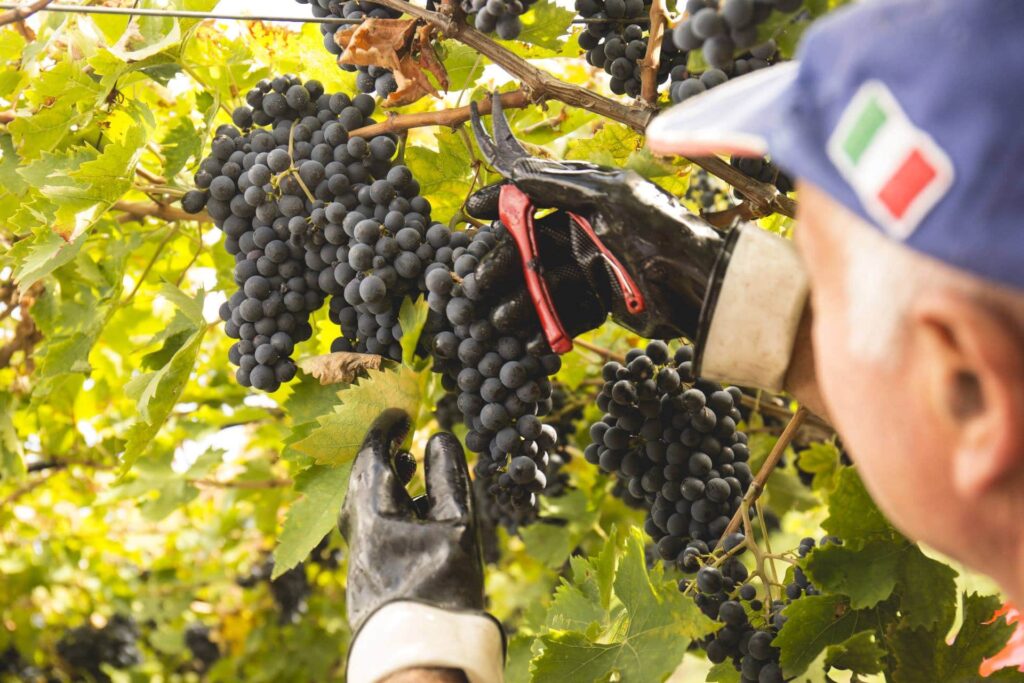
Here is a list of wineries in Abruzzo which are organizing the wine harvest and welcoming tourists to participate.
- Dora Sarchese – Ortona
- Tenuta del Priore – Collecorvino
- Contesa – Collecorvino
- Villa Medoro – Atri
- San Lorenzo – Castilenti
More events and festivals to come, sign up to our newsletter to stay up to date.
Why should you visit Abruzzo in October, or at all?
During October in Abruzzo you will be totally immersed in the harvest season with the ‘dolce’ aroma of roasted chestnuts, the scent of fresh grapes. Although the weather can be slightly unpredictable, it remains quite warm and sunny for most of the month. The slower pace of October makes it perfect to explore the rich artistic side of Abruzzo. From the historic churches, museums and the beauty of its hilltop villages, you can witness the authentic Abruzzo landscape dressed in warm autumn shades. Visiting during October also means tasting new wine & olive oil, hunting truffles and an additional chance to immerse yourself in the local culture.
From finely prepared saffron & truffle delicacies to gorgeous autumnal scenes, here’s why October is one of the best months to Visit Abruzzo…
Contact us today for a Private Authentic Abruzzo Experience.
Privacy Overview
Get the FREE Guide: How to Connect with Locals in Italy - Click Here!
- Jan 6, 2022
- 11 min read
Italy Off the Beaten Path: Best Towns in Abruzzo
Updated: Dec 15, 2022
When you’re planning to travel Italy off the beaten path, you want to choose authentic places where you can immerse yourself in the culture, connect with locals, eat amazing dishes, and experience the genuine spirit of the place that rings so much louder without all the crowds of Italy’s famous sights.
Well, I’ve just returned from three weeks in the Abruzzo region and I have to say, it’s a territory that off the beaten path travelers will deeply appreciate for its ancient stone villages, breathtaking scenery, phenomenal nature, and delectable cuisine!
If you want a glimpse at what a visit to this region might be like and what the best towns in Abruzzo are, then sit back with a cup of coffee and enjoy this list of some of my favorites! I’ve divided it up by area; North, South, East and West, which also roughly corresponds to the official Provinces of Teramo, Chieti, Pescara, and L’Aquila, respectively.
I’ve also included special treats throughout this blog post.. some of my best tips on specific things to know and places to go for those unique hidden gems I know you’re searching for! So, my off the beaten path travel buddies, prepare to fall in love with one of Italy’s most hidden gems..these 19 incredible towns in Abruzzo are waiting to solve your wanderlust!
Map of the Best Towns Off-the-Beaten-Path in Abruzzo
Best towns in northern abruzzo (province of teramo), civitella del tronto, pietracamela, best towns in eastern abruzzo (province of pescara), caramanico terme, best towns in southern abruzzo (province of chieti), guardiagrele.
Best Towns in Western Abruzzo (Province of L’Aquila )
Santo Stefano di Sessanio
Castel del monte.

One of the best things about Italy off the beaten path is the historic sites visitors get to enjoy all to themselves. Civitella del Tronto in northern Abruzzo is dominated by Italy’s largest fortress and Europe’s second largest. The weapon museum inside the fortress is worth the visit, let alone the views from the top!
Don’t Miss: Down in the village, follow signs to “Vicolo Stretto” and “ruetta d’italia la via più stretta”. You’ll find yourself at the most narrow alley in Italy! Hope you haven’t been eating too much pasta. ;)
Nearby: You can hop over into Umbria with a 30 minute drive further north to visit the beautiful off the beaten path town of Ascoli Piceno.

This town is famous throughout Abruzzo and beyond for its stunning ceramics. Aside from the jaw-dropping backdrop of tall snowy mountains, the best part of Castelli is walking through the artisan shops where you can buy all kinds of handmade ceramic objects and even see the artisans at work!
Don’t Miss: The ceiling inside of San Donato Church is made of ceramic tiles, but you may need to ask a local who’s got the key to open up for you.. Oh the joys of Italy off the beaten path!

Jaw dropping mountain views, winding cobblestone streets, and even a waterfall right in town made Pietracamela one of my very favorite towns in Abruzzo! I couldn’t stop imagining this mountain town all decorated for Christmas and bustling with out of towners taking a break from skiing. It would be the idyllic holiday setting! But this town is charming in any season and the perfect stop after a hike nearby.
Nearby: Keep climbing the road past Pietracamela to Bar Prati di Tivo where you can enjoy a frothy hot cocoa in a fun atmosphere surrounded by the mountains of Gran Sasso National Park!

If you’re interested in the best towns in Abruzzo for both the beaches as well as the mountains, Teramo might be a good base to consider. Its origins date back to the Phoenicians, so there’s no lack of interesting history (don’t miss the Roman amphitheater). Teramo is the capital of the province of Teramo, so you can find a bit more activity here than in the surrounding smaller villages.
Don’t Miss: The weekly market on Saturdays from 8:00 - 2:00pm. Come hungry, porchetta awaits!
Nearby: A stop by Tenuta Cerulli Spinozzi is well worth it. Pick up some olive oil and Cerasuola or Montepulciano d’Abruzzo wine and wander through the gorgeous vineyards. You might want to contact them in advance to see if there will be any fun events during your stay! I got to participate in the celebration of the chestnut harvest with a guided tour of the impressive winery.

I wasn’t lucky enough to see this beautiful town in daylight during my trip to Abruzzo, but I was certainly dazzled by its cathedral which is covered with 15th century frescoes by Andrea de Litio. However, I will go back for the panoramic views during daytime (Atri is just 6 miles from the Adriatic sea).
Known for: You’ll find shops selling the local specialty, licorice, which has medicinal properties useful for gastrointestinal disorders.

When it comes to Italy off the beaten path Italy, sometimes you hit the jackpot of hidden gems and sometimes you find yourself in a bizarre setting you didn’t expect. Azzinano certainly had me scratching my head yet totally loving it at the same time. This miniscule village in Abruzzo has covered its walls in unique mural paintings that are meant to capture traditional games that children played in the past. Though there isn't any reason to visit Azzinano besides the unusual murals, I certainly appreciate the creative effort to keep the culture alive!

Known as the city of bricks, Penne is one of Abruzzo’s best little off the beaten path towns. The San Francesco gates are the most beautiful way to enter Penne, and there are many elaborate palazzos (some in desperate need of restoration and care) and scenic views. The town is beautiful to just wander, but some worthy sights are the Romanesque Church of Sant'Agostino (later redone in the Baroque style), Palazzo Bono-Pilotta, and Palazzo Castiglione De Leone as well as the main cathedral. The Civico-Diocesano Museum is full of paintings, sculptures, and precious artifacts that help you realize just how ancient Penne really is!
Don’t Miss: Fornace del Bono is a unique cultural space dedicated to ceramics and jazz. Check out the underground space with low lights, old architecture, and relaxing jazz.

Considered the capital of Majella National Park, Caramanico Terme is an easy bouncing off point to see the nearby Orfento Valley, the Celestine hermitages, and the Hermitage of San Giovanni where the famous Pope Celestine V retired in solitude. This off the beaten path town is known for its therapeutic waters, so when you’re tired of hiking, you can visit one of the many spas in town.
Known For: Natural hot spring spas
Don’t Miss: Pick up food for the trail at Bar La Sorgente , or sit down and stay for the arrosticini , grilled sheep skewers famous in Abruzzo!
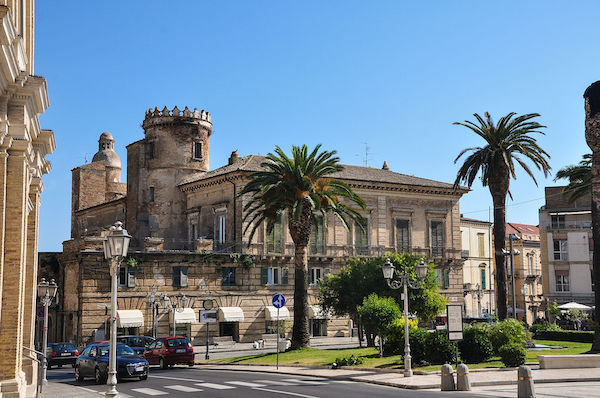
This town in Abruzzo overlooking the sea couldn’t be prettier. The historic center is beautiful and lively and even has a gorgeous promenade along the edge of the city overlooking the stunning panorama. If you crave a bit more culture and activity when you travel off the beaten path in Italy, Vasto would be a great base.
Nearby: Vasto is close to many beautiful “trabocchi” along the coast, traditional wooden fishing structures jutting out into the sea. Some even welcome guests onboard for an unforgettable lunch or dinner featuring insanely fresh seafood! It’s an experience in off the beaten path Italy that you won’t forget!

Inhabited since prehistoric times, Guardiagrele is prized for its cultural importance both because of its history and its art. My favorite thing about this village is the Museo dell’Artigianato (free entry) which houses the winning works from an annual contest for the best ceramics, woodworks, jewelry, ironworks, sculpture, copperware, lacework, and glasswork. It’s well worth some of your time! If you walk through the streets of Guardiagrele slowly and deliberately, you can stumble upon many working artisan studios still carrying on these traditions.
Nearby: If you have a sweet tooth like me or just enjoy discovering foods from off the beaten path Italy, you won’t want to miss Bottega del Bocconotto . Bocconotti are shortbread pastries with various delicious fillings.
Also Nearby: Cascata di San Giovanni is a 4.2 mile hike to a tall waterfall for you adventure seekers!
Best Towns in Western Abruzzo (Province of L’Aquila)

The capital of Italy’s Abruzzo region, L’Aquila is a lovely city hugged by snow-capped mountains. The streets are flanked by Renaissance and Baroque buildings that open onto large, elegant piazzas. There are many cultural institutions there, in part due to it being home to the University of L’Aquila.
Don’t Miss: Fountain of the 99 Spouts
Nearby: Just a 15-20 minute drive from the center of L’Aquila is a secret worth the extra hoops you may have to jump through in order to see it. Beneath the Chiesa di San Michele Arcangelo (San Vittorino) are hidden catacombs you can visit underground. They are fascinating and the tour by the priest is quite memorable! You’ll have to call the priest to open it up for you, though. Just send me a message in advance and I’ll help you out! [email protected]

This off the beaten path town is beloved throughout Abruzzo. And that may be in part due to its unique story which involves a Swedish-Italian millionaire who fell in love with what was previously a ghost town and paid for the entire village to be restored— around 4.5 million euros. Now that’s love! Though it has become a draw for tourists and is full of B&Bs, this medieval village is still a fun place to visit (and there aren’t SO many tourists in the region of Abruzzo afterall).
Known For: The luxury “diffused hotel”, Sextantio Albergo Diffuso, whose rooms are scattered throughout the village and connected by a central reception area. If the original inhabitants only knew what people are paying to sleep there now!
Nearby: Little Tibet , a plateau at Campo Imperatore that has been dubbed Little Tibet as it resembles views of the Himalayas.

One of Abruzzo’s larger towns, Sulmona offers quaint cafes, a beautiful cathedral, and a beautiful piazza with an arched aqueduct, fountain, and big snowy mountains in the background. I was here during winter, but I could imagine how this off the beaten path town must come to life in the summer, especially for its historical event, the Giostra Cavalleresca, when you can see jousting on horseback along with parades, banquets, and other festivities!
Known For: You’ll find shops throughout the town selling confetti, candied almonds gifted at weddings. Confetti from Sulmona is so famous that royal British weddings have ordered their confetti from Sulmona.

One thing that makes off the beaten path Italy so special are the quiet cobblestone streets where you can still notice signs of times past. Fontecchio is plentiful in this regard, from the fountain in town surrounded by stone seats where the women would sit waiting their turn to water their livestock, to the tall clocktower with the city gate underneath. You can even spot a stencilled portrait of Mussolini (propaganda graffiti from Mussolini’s reign) on one of the walls of Piazza San Nicola. This village has a sweet and quiet atmosphere and lies amidst tall rounded mountains that create beautiful views.
Don’t Miss: I Campi di Mais in Piazza del Popolo, a wool and textile shop run by Antonella.

Oh, Scanno! Another one of my very favorite off the beaten path towns in Abruzzo! Perched on a hilltop in the mountains, the village has a unique atmosphere where you almost feel you’ve stepped back in time. The village is wonderful for wandering and full of unique and beautiful architecture and views across the valley. The nearby Lago di Scanno (heart shaped from a certain perspective) makes Scanno a popular summer retreat.
Nearby: Though Lago di Scanno is better-known because of its size and heart shape, I fell in love with Lago di San Domenico which is more wild, features an arched bridge, a hermitage, and walkable trails. The bright aqua water is gorgeous!
Known For: Delicate filigree jewelry. A few shops where you can find filigree jewelry and artisan traditions are:
Oreficeria Di Rienzo Armando
Bottega Orafa Luigi Fronterotta
Il Gioiello del Tombolo
Laboratorio La Casina d’Oro
Also Known For: Scanno is also known for its Pan dell’Orso (Bear’s Bread), a typical cake made with honey and almonds and covered in chocolate.
Don’t Miss: If you’re fascinated by the traditions of off the beaten path Italy, visit the Wool Museum (Museo della Lana) where you can learn about the life of the shepherd.

Driving the curvy and scenic roads from Scanno to Barrea through some of the highest parts of the mountains, I truly felt I was wayyy off the beaten path in Italy! Barrea’s best feature is of course, the view over the beautiful Barrea Lake. But this lake didn’t actually exist until after WWII!
Don’t Miss: Castello di Barrea and its views from the tower at the top of the village.
Nearby: On the drive from Scanno to Barrea is Lo Scoiattolo , an authentic rifugio (lodge) with a large fireplace to keep you cozy and traditional dishes. You can also just stop in for a coffee or drink on your way!

There are so many ancient stone villages in Abruzzo, which is partly what makes off the beaten path Italy so enticing! Castel del Monte certainly fits that category, with its 360 degree views of Abruzzo’s impressive mountains and its Medieval and Renaissance history. There are mysterious tunnels under the village which are said to be related to old witch folklore, walking through tem apparently wards off spells!
Don’t Miss: "Night of the Witches" (La Notte delle Streghe) is an event in August where locals re-enact scenes of witchcraft from sundown to midnight.
Nearby: You absolutely can’t miss a visit to Rocca di Calascio at sunset. Local transportation and getting there depends on the season, so be sure to ask around and understand how much time it will take you to arrive. In November I was able to park in a very small lot on the road to the castle, but didn’t realize I then had a 30-45 minute walk ahead of me before actually arriving. However, when I’m in Italy, things tend to magically work out and I arrived at the Rocca 15 minutes before sunset. Others whose timing wasn’t as lucky were still walking up when it was already dark. Don’t be them, you’ll be missing out on a memorable moment!

Capestrano has been inhabited since the 6th century BC by the Picene people who created the “Warrior of Capestrano”, a 2-meter tall stone statue of a king which was found in the 1920s in a field. But that’s not the only fascinating history in this off the beaten path town. Just on the edge of town, the facade of the Benedectine Abbey of St. Peter ad Oratorium features a Sator Square , five-word square palindromes (can be read forwards or backwards) that have been found in just a few important cities such as Pompeii, Rome, and Siena. Capestrano is less than an hour from L’Aquila and is dramatically perched on a hilltop, which makes it all the more scenic, and the piazza is especially charming on market day. For gelato-addicts like me, you’ll be happy to know that Capestrano is also one of the few small villages that has a gelateria..you should have heard my squeal of excitement when I spotted it!
Don’t Miss: Castello Piccolomini is one of my top favorite castles in Abruzzo. It’s small, taking only about 30 minutes to visit, but the views are breathtaking. (Especially in Fall when the vineyards below turn orange and yellow!)
Also Don’t Miss: If you’re into diving, Capo d’Acqua Lake hides two mills from the middle ages submerged at the bottom of the lake.

This village is so humble and quaint, yet offers such a memorable visit with its meandering cobblestone streets, beautiful views over the valley, and architectural details. Much of the town is abandoned which adds a sense of mystery, but there are still many living here during the warm months and keeping Navelli alive. (Thank goodness!) This area is famous for saffron, so be sure to pick some up!
Don’t Miss: Navelli’s Palio degli Asini (Donkey race) takes place in August in conjunction with the harvest of chickpeas.
Nearby: The Oratorio of San Pellegrino in Bominaco is an artistic treasure worth seeing. Inside, the oratory is covered with amazing frescoes. When you arrive, there is a sign with a number to call for someone to come open up for you and give you a tour. Be sure to give a 5-10 euro tip for their trouble, not bad for a private tour of an ancient site.
Also nearby is an archeological site called Peltuinum, a Roman settlement that was very important to the transumanza, the movement of sheep from the mountains to the plains and vice versa.
Did you enjoy this guide to the best towns in Abruzzo? Want to learn more about off the beaten path Italy? Click here to get authentic Italy in your inbox!
Recent Posts
8 Unforgettable Reasons To Visit Puglia Next Year
Unique Cultural Traditions in Italy: The Transumanza
Florence’s Off-the-Beaten-Path Jewel: The Historic Florentine Silk Factory
Hi, thank you for your post! Any recommendation on what cities (or places) you stayed while exploring Abruzzo?

The Italian region with beautiful landscapes and ancient villages – but few tourists
I taly has welcomed visitors since time immemorial. But not all of Italy: some regions have remained impervious to the Grand Tourists of the past and the Instagrammers of today. Who, for example, visits Abruzzo, a region east of Rome and south of the Marche ?
Very few is the answer – but why so secret? Poverty, for one thing, and the sheer wilderness of the mountains for another. The region was too high and too isolated for vines and olives, and the medieval trade and rich history that fostered the cities – and art – of Tuscany , Umbria and Sicily.
And yet things are now changing, albeit slowly (houses here can still be had for under €10,000). Travellers are finally learning that its mountains, still the haunt of wolves and bears, are the finest in Italy outside the Alps, that its coast is gloriously wild in places, and that many of its ancient villages are timeless and traditional in the best sense. And if visitor infrastructure is still in its infancy – part of the region’s charm, of course – newer destination hotels are gradually opening , and the food, as ever in Italy, is superlative.
The new Tuscany? The new Umbria? Not quite. But a place to visit now before everyone else? Definitely.
The landscapes
Glorious mountain landscapes are Abruzzo’s principle lure. The Apennines – the Italian peninsula’s rocky spine – reach their highest point here in the peak of the Gran Sasso (9,553ft/2,912m), still home – just – to one of Europe’s most southerly glaciers.
Gran Sasso is also the name given to one of three immense massifs in the region, the other two being the Monti della Laga to the north and the Maiella to the south. All three have national park status, as does a fourth enclave, the Parco Nazionale d’Abruzzo on the region’s western flanks.
For those who only know the more benign aspect of the Apennines in Tuscany, Umbria or Liguria, it is hard to appreciate the sheer scale of Abruzzo’s mountains or their wild impenetrability. Wolves and even bears still roam here and vast, beautiful tracts of the region are accessible only on foot, following ancient transhumance trails, or with a patient – but hugely rewarding – odyssey on high mountain roads.
Most people visit the Parco Nazionale d’Abruzzo, partly because it is closest to Rome (81 miles/130km via the A2 motorway and the towns of Frosinone and Sora) and partly because it is among the best administered of Italy’s national parks. You’ll also find more in the way of hotels, facilities and marked biking and hiking trails here, notably in the main centres of Pescasseroli and smaller Opi, plus pretty, medieval Scanno just outside the park borders.
In the Monti della Laga, travel the beautiful road between Acquasanta Terme (just in the Marche) and Teramo, and consider the village of Pietracamela as a base. From here you could easily head south and take one of the finest drives in Europe, never mind Italy: the road that runs west to east under the Gran Sasso across the vast upland plains of the Campo Imperatore, known locally as “Little Tibet” after its remarkable scenery.
Visit Castel del Monte, one of the region’s loveliest villages and situated at well over 4,000ft. This is also a good place to stay, but drive on a few miles and tiny Santo Stefano boasts one of central Italy’s most interesting hotels, the Sextantio (doubles from around £150 including breakfast).
Alternatively, if you are heading for the coast (see below), continue east to Farindola, a classic little Abruzzese village with superb views and a great dining option (see below). Be sure to devote an hour or so to Loreto Aprutino to the east, one of the region’s most appealing medieval villages.
Explore the third of Abruzzo’s massifs, the Maiella, and you’ll be venturing into one of western Europe’s last great wildernesses. There are few places to stay in the heart of the mountains, with Caramanico Terme your best bet, but Sulmona just to the west is the Abruzzo’s most interesting larger town, birthplace of Ovid and of sugared almonds, or confetti (Sulmona almonds were served at Harry and Meghan’s wedding ).
It’s a town worth visiting in its own right, especially if you can be here on Wednesday or Saturday morning, when Piazza Garibaldi hosts a wonderful market. It’s also on a railway line – and there aren’t many of those in this mountain area: the ride here from Rieti via L’Aquila, and especially on to Castel di Sangro and beyond, is one of Italy’s most scenic .
The resorts and beaches
Mountains take the most plaudits in Abruzzo but the region’s long coast provides another compelling attraction. Many of the beaches and resorts are typical of Italy’s eastern, Adriatic coast, which is to say they are small, family-friendly affairs, often close to the coast’s main rail and road links, and with decent if unspectacular sand and hotels.
While some some spots in the north are fairly workaday, there are two notable exceptions: the wild, glorious stretches of sand in the Riserva Naturale del Borsacchio , north of Roseto degli Abruzzo , and Torre del Cerrano near Pineto, named after the adjacent historic defensive tower .
South of Pescara, head for Punta Ferruccio near Ortona – the scene of bitter fighting in 1943: it’s not easily reached, but is worth the effort, and has clothes-optional stretches. Equally wild and lovely are the nearby Calata or Spiaggia del Turchino close to San Vito Chietino, where the contemporary hotel Le Chiave dei Trabocchi makes a fine base (doubles from around £60).
This part of the coast takes its name from the eerily beautiful trabocchi , spindly wooden walkways and fishing shacks built on stilts which are unique to the region.
A few miles farther south still, the Lido di Casalbordino is another point of pilgrimage for beach aficionados, with the simple Finis Terrae bar a favoured spot to watch the sunset. Two more beaches stand out close to Vasto, the Abruzzo’s last hurrah before the border with Molise: Punta Penna and Punta Aderci. Both are wild places in part protected by nature reserves.
Abruzzo also has several family-friendly Green Flag beaches.
The food and wine
Like much else in the Abruzzo, the region’s food is barely known but often exceptional. The coast has predictably good fish and seafood, notably the mussels (cozze) from Vasto, often served with saffron (itself a regional speciality) or stuffed with breadcrumbs, lemon, parsley, garlic and tomato sauce.
The classic pasta is maccheroni alla chitarra, a spaghetti-like creation made by pressing sheets of pasta through wires (hence chitarra, or “guitar”).
When all’s said and done, however, the Abruzzo is a mountain region, and it’s the mountains, and centuries where poverty was the culinary mother of invention, that most colour the region’s cuisine.
Mushrooms and truffles abound, along with pulses and beans, but lamb and mutton were and are the mainstay of mountain cooking. One of the region’s great meals – one of Italy’s great meals – is to be had up on the high plains of the Campo Imperatore and elsewhere (see above).
Windblown, remote shepherds’ shacks will sell you a hunk of bread, several rough-cut chunks of pecorino (sheep’s cheese) and a fistful of arrosticini – skewers loaded with tiny pieces of lamb and mutton – that you (or they) grill on open fires. Eat with your fingers and want for nothing more.
Arrosticini are a mainstay of many mountain villages, too – make a pilgrimage to Farindola and Lu Strego , a trattoria whose version has more than once been acclaimed the best in the Abruzzo.
Wine-wise , no-one is going to Abruzzo to tour the region’s vineyards – for the most part the mountains aren’t conducive to growing vines – but wherever you go you’ll be able to drink Montepulciano d’Abruzzo, a more-than-decent red that you’ll probably have come across at home. Trebbiano is the standard white, while Cerasuolo is a lighter red also made from the Montepulciano grape.
But there is quality. As elsewhere in “lesser” Italian wine regions such as Umbria, the post-war period saw newer, dynamic producers pioneering some now top-notch wines. In particular look for bottles from Pepe and Valentini , along with CantinArte, Annona, Italo Pietrantoj, Cataldi Madonna and Valle Reale.
For more unusual regional drinks, risk a glass of ratafia, a black cherry liqueur; Aurum, a branded orange-scented brandy made in Pescara since 1925; centerbe (literally “one hundred herbs”), made from the mountain herbs of the Maiella; and genziano, made from the root of the gentian.
Getting there
Ryanair flies to Pescara Airport from Stansted. A far greater of options exist if you fly to Rome, from which regional capital L’Aquila is a 90-minute drive.
Staying there
Villa companies on the whole are still feeling their way into Abruzzo – typically a company might only one or two properties in the region – but look at the dedicated Abruzzo Turismo page or properties on the owner-listed Vrbo (formerly HomeAway) site . For more ideas on where to stay, see our guide to the best hotels in Abruzzo .
This story was first published in March 2022 and has been revised and updated.
Sign up to the Front Page newsletter for free: Your essential guide to the day's agenda from The Telegraph - direct to your inbox seven days a week.

- Search Please fill out this field.
- Manage Your Subscription
- Give a Gift Subscription
- Newsletters
- Sweepstakes
8 Best Places to Retire in Italy, According to Local Experts
From gorgeous islands to the idyllic countryside, here are some of the best places to retire in Italy.
:max_bytes(150000):strip_icc():format(webp)/patricia-doherty-2dd85666682c4f4fa708d02b4e4ac40e.jpg)
Santiago Urquijo/Getty Images
Retiring in Italy is a dream for many and a reality for quite a few, too. From major cities to small towns, the sea to the mountains, and the Mediterranean to the Adriatic, Italy offers a variety of lifestyle and cost of living options. In preparing this list, Travel + Leisure spoke to residents of Italy as well as travelers who visit multiple times a year. We also joined a Faceboook group called Retired Expats in Italy, in which members from around the world share experiences, answer questions, and discuss taxes, housing, driving, and more.
According to Expatica , approximately five million foreigners were living in Italy in 2023, about 8.8 percent of the population. European Union citizens don't need a visa to retire in Italy, and they're able to access the country's public health care system. Others, however, need an Italian residence visa and a stable minimum income in order to stay longer than 90 days. High-quality health care is available for retirees who establish residency, and in the meantime, a private policy is recommended. Pension income is taxable, and in some regions, residents may qualify for a flat seven percent tax.
When it comes to choosing where to retire, other factors like climate, housing costs, lifestyle, health care, and activities might come into play. Then, there's the decision of whether to rent, buy, or invest in a building to renovate. While every retiree has different needs and preferences, we're here to help you get started. Here are some of the best places to retire in Italy, according to experts.
Laura La Monaca/Travel + Leisure
An island off mainland Italy’s toe, Sicily offers a low cost of living and a variety of landscapes, from beaches and mountains to deserts and historic cities. On Sicily’s eastern coast, the popular tourist area of Taormina has restaurants, resorts, beach clubs, and an ancient amphitheater where concerts and events are held. Catania, home to the international airport, is located at the base of Mount Etna, and Siracusa is known for its Baroque architecture and archaeological sites.
The capital of Sicily, Palermo, is a dynamic city on the northern coast with an international airport, and nearby Cefalù is a beautiful seaside town. The island is also home to well-preserved archaeological sites in Agrigento, Segesta, Selinunte, and Siracusa. Sicily's interior consists of wheat fields, olive groves, farms, and villages, including many of the places where houses are selling for one euro to those who are willing to refurbish and live there.
During my many trips to Sicily, I experienced several of its mountain towns where my grandparents emigrated from, as well as the more popular coastal tourist destinations. The Sicilian people are welcoming, the food is delicious, the wines are superb, and the scenery is stunning. English is commonly spoken in the cities most visited by tourists, and in the small towns, most residents speak Italian or the Sicilian dialect. Retirees in Sicily enjoy a laid-back lifestyle, fresh produce, affordable rent and home prices, and a strong sense of community.
Michela Sieman/Travel + Leisure
Located along the heel of Italy’s boot, Puglia features coastlines on both the Adriatic and Ionian seas. Warm weather, small towns, olive groves, beaches, and a relaxed atmosphere make the towns here lovely places to visit and live. The main airport is in Bari, the region’s capital and a major seaport. One of the lower cost areas for retirement in Italy, Puglia is also home to historic cities, beautiful architecture, and UNESCO World Heritage sites, like the hilltop Castel del Monte. Using Bari for comparison, the overall cost of living is about 47 percent lower than New York, and rents are about 84 percent lower.
Last September, I traveled to Puglia , landing in Bari and driving south to Lecce , where there’s a well-preserved Roman amphitheater, the Baroque Basilica di Santa Croce, and the beautiful Old Town. In Otranto, we toured the 15th-century Aragonese Castle and shopped at the many boutiques in town selling everything from handmade ceramics to clothing. In Alberobello, we walked among the trulli, the white buildings set on curved hilly lanes, recognizable by their conical stone roofs. Many are occupied by full-time residents, and several are available through Airbnb or rental agencies.
Retirees living in Puglia can choose to live near the coast or inland in an agricultural area. According to Italy Property Guides, “In Puglia, you can have a quiet rural location and be near a town with all the facilities you might need. Road links are good, some towns are on bus and train routes, and fares are cheap. Big towns such as Bari, Brindisi, Lecce, Ostuni, and others have hospitals and industrial zones with large supermarkets.”
Alexander Spatari/Getty Images
Located in central Italy on the west coast bordering the Tyrrhenian Sea, this region includes mountains, valleys, and coastal plains. The main city is Rome , home to one of Europe’s busiest international airports and the port of Civitavecchia. Retirees can choose Rome, with its museums, restaurants, ancient sites, and sophisticated atmosphere, or a nearby small town .
Laura Itzkowitz , a resident of Rome for several years, says, “The Castelli Romani would be a good place to retire since they offer small-town life, beautiful rural surroundings, and easy access to Rome ." Historically, many noble Roman families built villas in the area to escape the hectic pace of the city. Frascati, for example, is surrounded by vineyards and has a charming town center with plenty of restaurants, bars, and shops. There are also other idyllic towns like Grottaferrata, Castel Gandolfo, Ariccia, and Nemi.
The cost of living varies among the cities in Lazio, with Rome being the priciest, but even at that, the overall cost of living is about 44 percent lower than New York, while rent is about 73 percent lower. In the pedestrian-friendly city, residents don’t need a car, and access to the international airport provides another advantage of living in the area.
Francesco Riccardo Iacomino/Getty Images
This area in central Italy lives up to its romantic reputation with rolling hills, vineyards, rivers, forests, castles, and charming towns. The region also offers 250 miles of Mediterranean coast and beachfront towns like Viareggio, Livorno, Massa, and Carrara. The culturally rich destination includes Florence, Siena, Pisa, Lucca, Arezzo, San Gimignano, and more. According to International Living , the area is one of the most popular with expats, and there’s an English-speaking presence in most towns.
On a visit to Tuscany, I spent a few days in Lucca, a walled city and one of my favorite places in Italy. “The people in Lucca stick to their traditions, so it’s the perfect location to immerse yourself in the culture and get lost in the food, drink, and people,” chef Luca Moriconi , who grew up there, told T+L.
I've also visited popular tourist destinations like Pisa, Siena, and San Gimignano, as well as quieter small towns that are still conveniently located near these destinations and ideal for retirement. In Viareggio, on the coast, my husband and I enjoyed lunch and browsed the shops where we saw many versions of Pinocchio and a beach club named for the story’s puppet. For retirees who love Tuscany and wish to live near the sea, the Viareggio area is the perfect location.
LucaLorenzelli/Getty Images
Located in the center of Italy, about 30 miles east of Rome, the Abruzzo region is bordered by the Adriatic Sea on the east, offering coastline, lakes, hills, mountains, vineyards, and three national parks. According to a 2023 article in International Living , “Abruzzo is a region for bargain hunters because it has managed to stay off the expat and trendy radar, despite its allures. You’ll find everything from rock-bottom priced village homes to country villas, at prices that will appeal to all budgets. Of course, the lowest prices are in small villages, but even many of those have castles and monuments, everyday services, and access to larger towns.
Livingcost.org compared the cost of living in Abruzzo with the other regions in Italy, and only Umbria showed a slightly lower figure. The website also detailed other expenses, and estimated rent for a three-bedroom apartment in a city center to be $753 a month and a cappuccino to be $1.48. International Living pointed out that the area’s rural farms provide excellent seasonal produce and local fishermen bring fresh catches to the region’s markets. Their estimate for a typical Italian breakfast, including a cappuccino and a cornetto, costs just $2.50.
Places to consider for retirement include coastal Pescara, historic and culturally rich L’Aquila, Teramo on the Adriatic (home to Roman ruins and medieval churches), and tranquil Schiavi di Abruzzo. With three national parks, there’s hiking, skiing, and mountain biking, as well as water sports and golf. Universities in Teramo, Chieti, Pescara, and L’Aquila offer cultural opportunities, too.
Yasonya/Getty Images
This area in northern Italy includes Venice — known for its canals, history, hotels, and restaurants — but it also serves up Roman ruins, medieval castles, beaches, mountains, beautiful small towns, and cities like Verona, Padua, and Vicenza. The hilltop town of Asolo has cobblestone streets and a medieval castle. Conegliano, a medieval walled town, is located in the heart of Italy’s Prosecco region. And Bardolino, on the shores of Lago di Garda, hosts several festivals each year.
While most retirees in Veneto have the opportunity to conveniently visit Venice, they will likely choose to live in one of the towns or cities nearby. For those who want to be near the canals, there’s the island of Burano in the Venetian Lagoon, beloved for its colorful houses. Nearby, seaside Caorle features similar pastel dwellings as well as sandy beaches. In the medieval walled town of Cittadella, there's an annual historic event featuring a torch-lit parade, music, fireworks, and archery competitions.
I spent a few nights in the beautiful city of Verona where I saw (like every tourist) Juliet’s balcony and statue, attended an opera at the Arena di Verona, and strolled across the bridge over the Adige river. I loved the city, and would agree with Expatra that Verona is an excellent retirement destination. According to Numbeo , Verona is about 44 percent less expensive than New York, and rent is about 80 percent lower.
This region in northern Italy is known for fashionable Milan , glamorous Lake Como, and many of the towns around Lake Como, including Bellagio, Menaggio, and Como. The health care system is excellent, and retirees who enjoy city life or smaller towns will find both in Lombardy. According to Livingcost.org , the cost of living in Lombardy is 1.35 times more expensive than other regions of Italy. For Milan, Numbeo indicates that the cost of living is about 31 percent lower than New York, and rents are about 61 percent lower.
Giammario Villa , Italian wine and food historian, spends much of the year in Italy and describes the Franciacorta area of Lombardy as "offers a rare natural beauty and gorgeous landscape, made of pre-Alpine mountains, glacier lake views, gently rolling hills, and, of course, plenty of vineyards." He adds, “This charming northern Italian scenario is completed by perfectly preserved castles, historical villas, and millenarian monasteries, perfect for idyllic walks, glorious biking, and horseback riding. Besides that, Franciacorta offers advanced, high-quality services for senior citizens in both public and private facilities.”
Villa points out that the area’s proximity to Lake Iseo guarantees mild winters and a moderate climate. Franciacorta is one hour from Milan, a plus for retirees who enjoy the city’s shopping and cultural opportunities, as well as convenience to medieval destinations like Brescia and Bergamo. Orio al Serio Airport, the third-largest in Italy, is nearby. Wine lovers will appreciate living among the vineyards, and as Villa notes, “Franciacorta is known to be the very best area in Italy for elegant, classic sparkling wines, with sustainable agriculture at the core of winemaking.” He mentions the excellent local cuisine, too, with examples like saffron risotto, lake fish polenta, and ossobuco.
Maremagnum/Getty Images
Located in northwestern Italy along the Ligurian Sea , this region is often called the Italian Riviera. Known for the five towns of Cinque Terre , the port of Genoa, olive oil, and cuisine that includes seafood, focaccia, pesto, and vermentino wine, Liguria offers mild weather and a beautiful coastline. The charming seaside town of Camogli features colorful homes, and Sanremo’s medieval old town features historic villas.
According to Expat Exchange , “There are several retirement communities in Liguria, offering a variety of amenities such as swimming pools, fitness centers, and social activities.” The 2023 article adds, “The cost of a nice two-bedroom home in Liguria can range from $150,000 to $400,000 USD, while a nice three-bedroom home can range from $200,000 to $500,000 USD.” Retirees in the active expat community have cultural attractions to explore, including Cinque Terre, Genoa’s Palazzo Ducale, and the area’s cathedrals and churches.
Livingcost.org indicates the cost of living in Liguria is 1.08 times more expensive than other regions in Italy. According to Numbeo , the cost of living in Genoa, Liguria’s capital, is about 39 percent lower than New York, and rents are about 81 percent lower.
Related Articles

IMAGES
VIDEO
COMMENTS
Map of Abruzzi italy. The Abruzzo region is bordered by the Marche region to the north, Lazio to the west and southwest, Molise to the southeast, and the Adriatic sea to the east. The region spans an area of 10,795 square kilometers, within a third of these lands there are three national parks, nature reserves and protected areas.
Primavera, the Best time to Visit Abruzzo. Late April to mid-May is the best time to visit Abruzzo for a holiday or long weekend break; it is still untouched, wild, with nature at its most flirty. The landscape is a textural riot with every imaginable petal & blossom open to announce the beginning of the warm weather softening the existing ...
Italy, Europe. Neither part of fashion conscious, Ferrari-producing northern Italy, nor the siesta-loving, anarchic world of the south, Abruzzo is something of an enigma. Despite its proximity to Rome and its long history of tribalism and pre-Roman civilisation, it sits well down the pecking order of Italian regions in terms of touristic allure.
This is Italy 's Abruzzo National Park, a triumph of conservation and rewilding in both Italy and Europe. In the entirety of the Abruzzo region - of which the national park is only a portion - just 1.3 million tourists visited in 2021, with far less making the journey from Abruzzo's gorgeous coastline inland to the park.
Welcome to Abruzzo, Italy. Italy's best-kept secret. Stay in your very own exclusive Villa. Abruzzo is a pristine region, often referred to as "Italy's Best-Kept Secret" because its allure lies in its unspoiled natural beauty, rich cultural heritage, and warm hospitality. Unlike the bustling tourist crowds in more popular Italian ...
Life in Abruzzo Italy. You can lay on one of the most beautiful beaches of the Trabocchi coast, a 54-kilometer (33 miles) coast that stretches from Ortona to Vasto area, in the province of Chieti, named this way for its collection of old fishing net structures known as trabocchi; w alk along the ancient and noble cities and the thousand-year-old villages perched on the peaks, visit the ...
Tourist Awards in Abruzzo. The following Italian towns and villages in Abruzzo are listed among the ' most beautiful villages in Italy ': Anversa degli Abruzzi, Bugnara, Castel del Monte, Castelli, Città Sant'Angelo, Civitella del Tronto, Guardiagrele, Introdacqua, Navelli, Opi, Pacentro, Pescocostanzo, Pettorano sul Gizio, Pietracamela, Rocca ...
Abruzzo is a year-round destination, but we'd recommend visiting in the spring (particularly early-mid May when the wild cherry is blossoming) or early summer (late May-June) when the alpine and subalpine flowers are in bloom. But midsummer and autumn are also lovely. It is several degrees cooler than Rome up here, and can be very snowy in ...
8. Dine Above the Adriatic Sea on a Trabocco. While you're in Abruzzo, you can't miss spending some time along the sea on the picturesque Costa dei Trabocchi. This coastline stretches for over 40 kilometers, from Ortona to Vasto. Fishing platforms line the coastline, built above the lapping waves of the Adriatic.
From breathtaking, ancient hilltop towns, a little ragged around the edges, to Neolithic caves, Roman ruins, and the best beaches in the country, Abruzzo is as surprising and rare a find as an Egyptian tomb in a scoured desert. Luciano Di Gregorio author of Abruzzo: The Bradt Guide. Abruzzo offers travellers a holiday that is as varied as its ...
Here are 10 reasons you should visit Italy's next hot destination. 1. Abruzzi cuisine. Pasta production house Antico Pastificio Rosetano, which makes pasta brand Verrigni, is located in Abruzzo ...
It is a must see spot for anyone who visits Abruzzo. 7. Sulmona, the capital of "confetti". Sulmona is a charming town located at the foot of the Majella, surrounded by mountains, where ancient history and a strong tradition for colorful sweets live together making it one of the most famous villages in Abruzzo.
Morning. The easiest way to travel to Abruzzo from Rome is by train or car. If you choose to take the train, the journey will take about two hours, and you can catch a train from Termini station in Rome to Pescara station in Abruzzo. If you prefer to drive, it will take approximately two and a half hours, and you can take the A24 highway.
From €34.00. 8. The Majella National Park: between History and Nature. The Majella National Park is another unmissable event for nature lovers traveling to Abruzzo. The park, established between 1991 and 1995, extends between the provinces of Chieti, L'Aquila and Pescara and offers a vast range of attractions.
The Best Time to Visit Abruzzo, Italy. A large majority of the Abruzzo region is located at high altitude. During the winter season, it can get very cold and snowfall is typical. Unless you are specifically interested in winter sports and visiting Abruzzo's ski resorts, winter in Abruzzo can be limited for travel.
7. Scanno. The alpine town of Scanno is known as the Pearl of Abruzzo. In many ways, it combines the best parts of the region into one, featuring medieval architecture, surrounded by mountains and fresh alpine air. In the 15th century, thanks to agriculture and a talented community, Scanno was a wealthy town.
Here are the must-visit spots in Abruzzo you should know about. 1. Abruzzo National Park. Step into the wild heart of Italy at Abruzzo National Park, a sanctuary of biodiversity and natural beauty. Here, the Apennine wolves roam free, and the Marsican brown bear leaves its elusive footprints.
Best Time to Visit Pescara. Pescara, Italy: a guide for the picky traveler. Summer (June to August) Weather: ... Travel, memoir, fiction. "Abruzzo, Italy: A Cultural Guide" by Luciano Di Gregorio - Luciano Di Gregorio breaks down Abruzzo. Mountains, coast, history, food. It's all here, raw and unfiltered.
Central Italy's best-kept secret, Abruzzo, is seeping with authenticity and old-world charm. Just two hours outside of Rome, and largely unknown to international travelers, this crown jewel of Italy is filled with nostalgic Italian villages that have remained preserved throughout time and offers visitors everything that they are looking for in an authentic Italian experience.
Best Time For a beach holiday along the coast of Abruzzo, the best period is the summer, especially in July and August, since they are the warmest and sunniest months, and when the sea is also warmer. To visit the cities, given that it can be very hot in summer, you can choose the periods from mid-April to mid-June and from September to early ...
Weather in Abruzzo Italy in October. Expect the temperature to range from 69F (21C) during the day on the coastline and 51F (11C) during the night in the hinterland. campotosto lake abruzzo. Given its contrasting geography, Abruzzo has two distinct climates, one being in the mountains villages between 500-700 meters (1640-2296), and the other ...
Penne. Known as the city of bricks, Penne is one of Abruzzo's best little off the beaten path towns. The San Francesco gates are the most beautiful way to enter Penne, and there are many elaborate palazzos (some in desperate need of restoration and care) and scenic views. The town is beautiful to just wander, but some worthy sights are the ...
For sunny skies and balmy beaches without sky-high heat indices, the best times to visit Italy are the late spring and early fall. Months like May and September offer temperatures in the 70s and ...
Most people visit the Parco Nazionale d'Abruzzo, partly because it is closest to Rome (81 miles/130km via the A2 motorway and the towns of Frosinone and Sora) and partly because it is among the ...
One of the lower cost areas for retirement in Italy, Puglia is also home to historic cities, beautiful architecture, and UNESCO World Heritage sites, like the hilltop Castel del Monte. Using Bari ...